


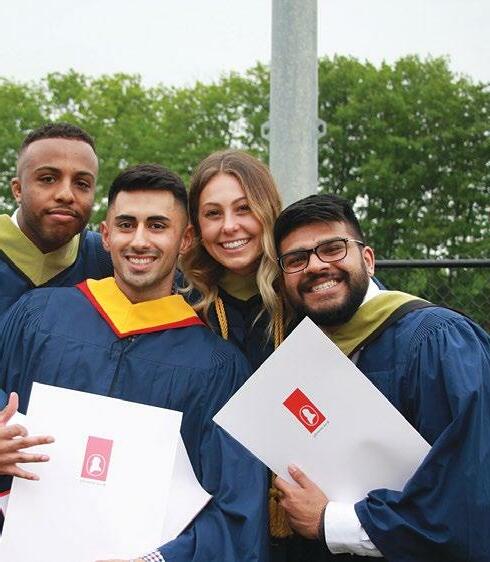
2021-22 ANNUAL REPORT INCLUDING FINANCIAL STATEMENTS
Contents
Our financial health
Financial results 1
Chairs’ message
Chair of the Board’s message 2 Chair of Senate’s message 3 Governance
Governance at Brock University 4 Board of Trustees 4 Senate i
Institutional Strategic Plan ii The big picture (Pullout 1) iv Student experience 9
New programs/course offering highlights 13
Research 14 Community engagement 21 Inclusivity 26
Brock sports 29 Alumni 32
Brock student excellence 34 Teaching awards 35
Graduate Studies awards 37 Research awards and Canada Research Chairs (CRC) 38
Excellence in staff i Donor engagement ii
Excellence in 2021-22 (Timeline pullout 2) iv Our people 43
Reviewing the numbers Financial facts 45
Overview 48
Financial results – funding basis 48 Revenue and expense allocation model 58
Funding basis reconciled to the Financial Statements 60
Examination of net assets 62 Financial review of the audited Financial Statements 64
Taking a closer look at some of the numbers 65
University Risk Management 73 Financial Statements
Statement of Administrative Responsibility 75
Independent Auditor’s Report 76
Statement of Financial Position 79 Statement of Operations 80
Statement of Changes in Net Assets 81
Statement of Cash Flows 82
Notes to Financial Statements 83
Dear Brock community,
President’s message
Lynn Wells, President and Vice-Chancellor

This report contains certain forward-looking information. Users are cautioned that actual results may vary. Throughout the text in this annual report, financial values have been rounded to the nearest thousand.
On behalf of the entire leadership team, I want to thank every member of the University community for your continued and thoughtful stewardship of Brock’s finances. The challenging decisions you make continue to help the University prioritize student success and research excellence while maintaining our strong financial position.
As we look back on the last fiscal year, I hope you’ll take a moment to reflect on all that we were able to achieve as a campus community during what continued to be incredibly difficult times.
Despite the unprecedented challenges presented by COVID-19, faculty, librarians and staff worked together to ensure students had the meaningful and safe on-campus experience they wanted.
Additionally, Brock continued to be recognized for its excellent student experience, being ranked among the best in the country last year. And for the fourth straight year, Brock was ranked No. 1 in Canada for its mental health supports, something in which we should all take great pride.
We continued to significantly grow our research enterprise and funding, and Brock is now home to 10 active Canada Research Chairs (CRCs) – nationally-recognized researchers, working in fields ranging from cognitive neuroscience and plant biotechnology to muscle health and youth mental health – and 14 CRC allocations.
The Brock Badgers athletics teams often give us reasons to smile, but this year we got to cheer them on in a record-setting time in Badger history, with 10 teams competing in their respective national championships. The most successful season in Brock sports history is one we won’t soon forget.
And we continued our preparations to host the Niagara 2022 Canada Summer Games this August, a legacy of which will be the fantastic facilities located right here on our campus and available to future Brock students and to the broader regional community.
As we prepare for a fulsome return to on-campus learning this fall, I want to extend my warmest thanks to the entire Brock community for the continued dedication to providing an exceptional experience for our students. It would not be possible without you.
Financial results
The following table illustrates the financial results of the University presented on a funding basis as well as in accordance with accounting standards for not-for-profits (NFPS). A reconciliation between the two presentations can be found starting on page 60.
Student fees 188,064 196,563 187,773 197,036 186,012 186,657 Grant revenue 99,780 97,708 97,338 94,758 106,724 103,943
Internal chargebacks 7,346 8,641 3,098 Inter-fund revenue 5,943 7,462 8,843 Research revenue 13,173 13,034 11,778 Other revenue 50,256 48,406 63,736 61,747 24,319 39,066
Total revenues 351,389 358,780 362,020 366,575 328,996 341,444
Operating costs
Personnel costs (221,304) (233,761) (229,489) (237,560) (214,657) (220,557) Inter-fund expenses (28,926) (26,610) (18,143) Other operating costs (97,262) (101,888) (129,772) (128,957) (83,302) (113,842)
Total operating costs (347,492) (362,259) (359,261) (366,517) (316,102) (334,399)
Mitigation target 3,479
Funding surplus (before discretionary appropriations) 3,897 - 2,759 58 12,894 7,045
Discretionary appropriations (3,896) (12,885)
Funding surplus (after discretionary appropriations) 1 - 2,759 58 9 7,045
Statement of operations metrics
Figure 2
By student headcount ($000s) Brock Median(1) Average(1) April 2022April 2021April 2020April 2021April 2020April 2021April 2020 Student fees (primarily tuition) 9.62 9.46 9.39 9.46 9.60 9.43 9.41 Grant 5.92 6.07 5.62 9.67 8.44 10.50 10.27 Personnel costs 11.76 11.18 11.48 13.77 13.88 14.01 13.82 Scholarships 1.55 1.40 1.25 1.53 1.39 1.63 1.55 Interest on long-term debt 0.54 0.53 0.35 0.33 0.35 0.33 0.31 Investment income 0.08 0.24 0.15 0.80 0.47 1.00 0.51 (1) Calculated using financial information from 13 other comprehensive universities. Certain 2020 metrics have been updated due to revisions in certain universities’ financial statements. Brock’s tuition is in line with the average; however, grant revenue per student continues to be well below the sector average. Naturally, Brock operates more efficiently given the below-average government funding, and this is seen in the lower personnel costs per student. Brock continues to invest in students through increasing scholarships. Interest and investment income metrics are in line with Brock’s financial health metrics, as detailed below.
Financial health metrics
using
information from
other comprehensive universities. Certain 2020 metrics have been updated due to revisions in certain universities’ financial statements. (3) Increase is due to a one-time repayment of a $14.4 million loan utilizing the debt repayment reserve establish within the Fiscal Framework.
Refer to page 68 for explanations of the debt-related financial health metrics.
2021-22 Annual Report 1 Our financial health
Brock(1) Median(2) Weighted average(2) April 2022April 2021April 2020April 2021April 2020April 2021April 2020 Primary reserve ratio 25.7% 25.6%14.2%27.5%22.8%45.2%40.6% Debt burden ratio 3.5% 3.7%6.7%(3) 2.6%2.4%2.5%3.8% Interest burden % 3.2% 3.4%2.1%1.5%1.3%1.7%1.2% Interest coverage 2.98 3.00 4.64 4.48 4.64 5.19 5.07 Viability ratio 38.8% 32.9%35.7%113.1%109.2%131.5%131.6% Net operating revenues ratio 2.4% 8.3%9.3%11.7%4.6%15.2%5.4% Employee future benefits per student headcount ($000s) $(1.32) $(1.09) $(1.13) $(1.24) $(3.52) $(2.35) $(4.25) Endowment per student
($000s) $6.10 $6.28 $5.25 $10.37 $8.61 $8.81 $7.94 (1)
Figure 3
headcount
Certain Brock 2021 metrics have been adjusted due to an update in reporting. (2) Calculated
financial
13
Figure 1
NFPS Funding 2020-21 Actual NFPS 2020-21 Actual
Actual
Budget 2021-22 Actual 2021-22 Budget
($000s) Funding
2021-22
2021-22
Revenue
Chair of the Board’s message
Mark Arthur, Chair of the Board, Brock University

On behalf of the Board of Trustees at Brock University, I invite you to carefully read the story of Brock University as told in the pages of our 2021-22 Annual Report.

This is the story of yet another year like no another at Brock, which included its share of challenging circumstances as the pandemic situation evolved.
From rapidly changing public health guidelines to pivoting from online to in-class learning, individuals from across our institution were asked to come together like never before.
Thanks to the Brock community’s creativity, resilience and dedication, the institution was able to move forward, and is now preparing for a full return to the on-campus experience so desired by students.
Students coming to campus for the first time this fall will find an institution nationally recognized for the quality of its educational and student experience, its research enterprise, and its welcoming, diverse community. A place strongly committed to equity, diversity, inclusion and reconciliation, which values its strong roots in the Niagara region and its role on the national and international stage.
All of this is thanks to the tireless work of the entire Brock community. Your ability to make challenging decisions over the last year means that Brock remains in a strong financial position, and can continue to offer the exceptional student experience it has become known across the country for.
My sincerest thanks for a job well done!
2 2021-22 Annual Report CHAIRS’ MESSAGE
Chair of Senate’s message
Don Cyr, Chair of Senate, Brock University

2021-22 continued to be a challenging year for the University and its Senate, having to continue to deal with the impact of the pandemic on the institution’s operations and finances. Much focus was placed upon ensuring that Brock was in a financially sound position, despite the continued freeze on tuition and increased costs or lost revenues associated with the impact of the pandemic. Working collaboratively with administration and the Board of Trustees, the University Senate passed a motion endorsing the University’s 2022-23 budget as one consistent with the academic policy of the institution.
Over the year, the University continued to deliver its range of courses and services almost completely online until partly through the Winter Term of 2022 when a staged approach to returning to in-person delivery was enacted. It has certainly been a transformational experience, not just for students but for everyone at the institution. The question now is what elements of online teaching and service delivery can and should be retained in the future. This remains a changing landscape at many institutions and will continue to be fodder for discussion.
Senate did endorse the purchase of an updated Learning Management System this year, potentially providing for greater flexibility in some aspects of course delivery.
During the year, several innovative programs were approved by Senate, submitted to and ultimately approved by the Ministry of Colleges and Universities, to be offered by Brock. These include a Bachelor of Science in Psychology, a Bachelor of Arts in Adult Education, a Bachelor of Science in Data Science and Analytics, a PhD in Intelligent Systems and Data Science, and a Concurrent Bachelor/Master of Nursing program. The 20-month Bachelor/Master of Nursing is a one-of-its-kind program and will contribute to additional Nursing students entering Brock in the fall. Through this, Brock is making a significant contribution to the health-care needs of Ontario.
Work continues on educational programming in the field of integrated engineering, and this year Senate approved the naming of the Yousef Haj-Ahmad Department of Engineering in recognition of a generous gift from the Haj-Ahmad family in honour of Dr. Yousef Haj-Ahmad, former Professor of molecular genetics at Brock University and current president and CEO of Norgen Biotek Corp.
This year also saw the approval of a number of new and continuing agreements on collaborative programming and transfer credits with several Ontario colleges, providing innovative pathways for students from college programs to degrees at Brock.
Finally, during the year the Senate was consulted and provided suggestions in terms of the attributes of potential candidates for the role of President at Brock University.

2021-22 Annual Report CHAIRS’ MESSAGE 3
Governance at Brock University
The University was incorporated in 1964 through The Brock University Act (the Act), a Statute of the Province of Ontario. The University is governed by the Act, which provides that the governance, conduct, management and control of the University’s property and the conduct of its business and affairs is vested in the Board of Trustees (the Board), while the Senate is responsible for the education policy of the University. This bicameral system of governance, is shown below.
2021-22 Board of Trustees members
• Mark Arthur, Community Trustee, Chair of the Board
• Greg Berti, Community Trustee
• Bradley Clarke, Staff Trustee
• Gary Comerford, Community Trustee, Immediate Past Chair of the Board
• Don Cyr, Faculty Trustee, Chair of Senate
• Mary De Sousa, Community Trustee, Vice-Chair of the Board
• Arti Freeman, Community Trustee
• Kristian Knibutat, Community Trustee
• Brian Lang, Community Trustee
• Erin Mathany, Community Trustee, Member, Brock University Alumni Association Executive Committee
• Bill Maurin, Community Trustee
• Anne McCourt, Community Trustee
• Trecia McLennon, Staff Trustee
• Marylee O’Neill, Community Trustee
Board of Trustees
The Board consists of up to 26 members, including up to 17 community members elected by the Board, as well as one graduate and one undergraduate student, three faculty members and two staff members elected by their respective constituencies. The Chancellor and the President and ViceChancellor are ex officio members of the Board. The Board currently consists of 23 members.
• Hilary Pearson, Chancellor
• Rafay Rehan, Student Trustee, President, Brock University Students’ Union
• Miriam Richards, Faculty Trustee
• JoAnna Roberto, Community Trustee
• Stephanie Thompson, Community Trustee
• Robert Welch, Community Trustee
• Lynn Wells, Interim President and Vice-Chancellor
• Christopher Yendt, Student Trustee, President, Brock University Graduate Students’ Association
• Debbie Zimmerman, Community Trustee
4 2021-22 Annual Report GOVERNANCE
23 Board of Trustees committees Executive Committee University and Community Experience Committee Capital Infrastructure Committee Financial Planning and Investment Committee Pension Committee Audit Committee Human Resources Committee Governance/ Nominating Committee
Board of Trustees Senate Standing committees and ad hoc or special committees Standing committees and ad hoc or special committees
Figure 5 Figure 4: The bicameral system of governance
Senate
As of the time of preparation of this report, the Senate consists of 70 members, including 38 elected full-time teaching staff and professional librarians, two members of the Board, six undergraduate students and two graduate students elected by their respective constituencies. There are also 22 ex officio members of the Senate.
2021-22 Senate members
Members ex officio
•Hilary Pearson (Chancellor)
Full-time teaching staff/professional librarian representatives 38 22
• Lynn Arner (FOH)
• Michael Ashton (FOSS)
•Lynn Wells (Interim President and Vice-Chancellor; Provost and Vice-President, Academic)
•Tim Kenyon (Vice-President, Research)
•Ken Chan (Vice-President, Administration)
•Austin Hurley (Vice-President, External Affairs, BUSU)
• Haley Myatt (Designate for President, GSA from the GSA Executive) (non-voting)
•Brian Power (Vice-Provost and Associate Vice-President, Academic)
•Anna Lathrop (Vice Provost and Associate Vice-President, Students)
•Robyn Bourgeois (Acting Vice-Provost, Indigenous Engagement)
•Ejaz Ahmed (Dean, Faculty of Mathematics and Science)
•Suzanne Curtin (Vice-Provost, Graduate Students and Dean, Faculty of Graduate Studies)
•Andrew Gaudes (Dean, Goodman School of Business)
•Ingrid Makus (Dean, Faculty of Social Sciences)
•Carol Merriam (Dean, Faculty of Humanities)
•Michael Owen (Dean, Faculty of Education)
•Peter Tiidus (Dean, Faculty of Applied Health Sciences)
•Geraldine Jones (Registrar and Associate Vice-President, Enrolment Services) (non-voting)
•Mark Robertson (University Librarian)
•Mark Arthur (Chair, Board of Trustees)
•Thomas Winger (President, Concordia Seminary)
•James O’Brien (Alumni Association Representative)
•Jennifer Dockstader (Co-Chair, Aboriginal Education Council)
Note:
Faculty of Applied Health Sciences (FAHS); Goodman School of Business (GSB); Faculty of Education (FOE); Faculty of Humanities (FOH); Faculty of Mathematics and Science (FMS); Faculty of Social Sciences (FOSS); and Faculty of Graduate Studies (FGS).
Pullout 1i
• Kate Bezanson (FOSS)
• Michael Bidochka (FMS)
• Irene Blayer (FOH)
• Alison Braley-Rattai (FOSS)
• Christene Carpenter-Cleland (FMS)
• Rosemary Condillac (FOSS)
• Maureen Connolly (FAHS)
• Gale Coskan-Johnson (FOH)
• Don Cyr (GSB)
• Drew Dane (FOSS)
• Sheng Deng (GSB)
• Tim Dun (FOSS)
• Fayez Elayan (GSB)
• Bareket Falk (FAHS)
• Amy Friend (FOH)
• Dawn Good (FOSS)
• Nicholas Hauck (FOH)
• David Hutchison (FOE)
• Kelli-an Lawrance (FAHS)
• Jingyu Li (GSB)
• Francine McCarthy (FMS)
• Cheryl McCormick (FMS)
• Richard Mitchell (FOSS)
• Tim Murphy (FOSS)
• Roberto Nickel (FOH)
• Unyong (Howard) Pyo (GSB)
• Monica Rettig (Library)
• Tim Ribaric (Library)
• Ian Ritchie (FAHS)
• Larry Savage (FOSS)
• Kirsty Spence (FAHS)
• Tek Thongpapanl (GSB)
• Francine Vachon (GSB)
• Terrance Wade (FAHS)
• Michelle Webber (FOSS)
• Shannon Welbourn (FOE)
• Arti Freeman
• Debbie Zimmerman
Undergraduate student representatives
• Ria Choksi
• Yasmine Hejazi
• Benjamin Johnson
• Daniel Krowchuk
• Moksh Sharma
Graduate student representatives
• Ash Grover
• Nawal Syed
6
70
Senate standing and special committees
Governance Committee Graduate Studies Committee
Information Technology and Infrastructure Committee
Research and Scholarship Policy Committee
Teaching and Learning Policy Committee
Undergraduate Student Affairs Committee
Student Appeals Board
Undergraduate Program Committee
Planning, Priorities and Budget Advisory Committee
Academic Review Committee (special) 2
Two 2
Row Council (special)
Figure
6
Representatives of the Board of Trustees
• Omer Gul
Institutional Strategic Plan
Illuminating Brock’s path forward is our Brock University Institutional Strategic Plan for 2018-2025, entitled “Niagara Roots – Global Reach,” referred to throughout the text of this document as the “Institutional Strategic Plan.” It was developed through a broad-based, full-year consultation process and has been approved by the Board of Trustees and Senate. The document sets out the vision, mission, guiding values and strategic priorities to support planning and decision-making until 2025. The entire Plan, including the Guiding Values, can be viewed at brocku.ca/vp-academic/wp-content/uploads/ sites/65/Brock-University-Strategic-Plan.pdf
Vision
Brock University is a dynamic, comprehensive university that makes a positive difference in the lives of individuals in our Brock community, the Niagara Region, Canada and the world through leadership, innovation and excellence in learning, teaching, research, scholarship and creativity across disciplines.
Mission
Brock flourishes through the scholarly, creative and professional achievements of our students, faculty and staff. Although we share a common purpose, we recognize and honour knowledge pursued through diverse perspectives and approaches. Our academic mission is to nurture and support our students and faculty in the discovery of knowledge through exemplary scholarship, teaching and service.
We provide undergraduate, graduate and professional education of the highest quality. Our graduate programs enhance Brock’s growing reputation for excellence in teaching, research, creativity and innovation. We provide a transformative experience for our students inside and outside the classroom by helping to develop their full potential as educated and engaged citizens in local and global communities. Brock graduates go out into the world as leaders, with a track record of entering fulfilling careers across all disciplines.
Brock University works to enhance the economic, social, cultural and intellectual lives of the communities around us – Niagara, Ontario, Canada and globally – and to demonstrate the vital ways in which we contribute to the well-being and betterment of society in the 21st century.
Strategic priorities
The Institutional Strategic Plan establishes four strategic priorities, along with associated goals and action items, to advance Brock’s vision over the next seven years. These priorities focus the University community on fulfilling and strengthening our mission as an engaged and comprehensive university through:
Strategic priority: Offer a transformational and accessible academic and university experience
To be a destination of choice for undergraduate, graduate and part-time students, we must ensure an academic and university experience that positively transforms our students’ abilities, understanding and impact on the world. We teach future-ready students and equip lifelong learners with a zest for knowledge, skills and competencies that will enable them to achieve their full academic, professional, career and life potential. Core to our student experience is the development of engaged citizens who are resilient, involved, career-ready and versatile.
Strategic priority: Build research capacity across the University
Our research focus is central to our identity. Brock will invest in building a world-leading research institution that is grounded in scholarly excellence and strong graduate and postgraduate programs. We will leverage our strengths within and across disciplines to enhance research impact.
Strategic priority: Enhance the life and vitality of our local region and beyond Brock is committed to working with the communities in Niagara, Ontario, Canada and the world. Through local and global connections, we increase opportunities for the residents of Niagara. By responding to the needs of society and supporting its growth and development, we strengthen community vitality and vibrancy.
Strategic priority: Foster a culture of inclusivity, accessibility, reconciliation and decolonization
At Brock, we believe that a diverse and welcoming learning community is built upon the foundation of exceptional students, faculty, staff and alumni. This requires that Brock be attractive and welcoming to people of all identities, and accepting of the unique histories and experiences of Indigenous people within the Canadian state.
Pullout 1ii
Pullout 1iii Our strategic priorities
innovation
creativity
Integrity and respect Freedom of thought and expression coupled with academic responsibility Inclusivity, diversity, equity Unique student experience The generation and mobilization of knowledge Reconciliation and decolonization Offer a transformational and accessible academic and university experience Build research capacity across the University Enhance the life and vitality of our local region and beyond Foster a culture of inclusivity, accessibility, reconciliation and decolonization Guiding V alues Strategic
Priorities Innovation and transdisciplinarity Sustainable, accountable stewardship GUIDING VALUES AND STRATEGIC PRIORITIES(1) (1) The colours in the graphic include Brock’s brand standards and those from the Indigenous Medicine Wheel, the Pride Flag and the Dish with One Spoon Wampum Agreement Flag.
set the University on the path towards greater national and global recognition for its engagement and relevance to students and communities through enhanced
and excellence in teaching, learning, discovery,
and the application of knowledge across disciplines.
Focus and
Figure 30
capital and infrastructure projects and reserves, operating project accounts, research funds with no external obligations, start-up funds, professional expense reimbursement accounts and the external research fund.
Pullout 1iv
Figures represent the number of students in each Faculty of Major on Nov. 1 of each Academic Year (as per PFIS-USER submissions). In addition, figures also include new-entry enrolments as of Feb. 1 for Master of Education (ISP), Master of Accountancy, Master of Material Physics, and Technological Education programs. For the 2020-21 Academic Year, Master’s Preparation Certificate in Education was also included in this list, while Master of Education (ISP) was excluded.
Note: the table above also includes ‘No Faculty’ (i.e. auditing and non-degree) enrolment.
are reported based on a student’s home Faculty, weighted based on each individual’s course registrations, according to course weights. Undergraduate FTEs represent all semesters, as of each ministry reporting date and in accordance with ministry reporting guidelines; graduate FTEs represent Fall and Summer semesters (in accordance with ministry reporting guidelines) as well as Winter MAcc registrations.
Total
Total
Total
2021-22 Actual Purchased services Utilities and taxes Financial expenditures Repair and maintenance and capital replacement Scholarships and fellowships Library acquisitions Cost of sales Inter-fund expenses(1) Other operating costs Amortization of capital assets 2021-22 Budget Purchased services Utilities and taxes Financial expenditures Repair and maintenance and capital replacement Scholarships and fellowships Library acquisitions Cost of sales Inter-fund expenses Other operating costs Amortization of capital assets Funding operating costs ($000s) Funding operating costs ($000s) NFPS operating costs ($000s) NFPS operating costs ($000s) 14% 16% 5% 8% 12% 15% 14% 6% 6% 8% 10% 4% 4% 3% 3% 13% 21% 16% 19% 9% 7% 23% 19% 21% 3% 3% 9% 23% 10% 7% 4% 3% 25% 18% 14% 5% Total 129,772 19,387 6,393 10,908 11,587 30,230 4,339 4,36615,685 26,877 18,976 8,107 10,934 11,399 29,373 4,715 4,513 16,376 24,564 Total 128,957 Total 130,084 Total 128,498 17,942 6,393 12,985 8,636 23,675 5,218 4,366 32,822 18,047 18,172 8,107 13,019 8,502 23,845 5,222 4,513 26,610 20,508 2021-22 Actual Purchased services Utilities and taxes Financial expenditures Repair and maintenance and capital replacement Scholarships and fellowships Library acquisitions Cost of sales Inter-fund expenses(1) Other operating costs Amortization of capital assets 2021-22 Budget Purchased services Utilities and taxes Financial expenditures Repair and maintenance and capital replacement Scholarships and fellowships Library acquisitions Cost of sales Inter-fund expenses Other operating costs Amortization of capital assets Funding operating costs ($000s) Funding operating costs ($000s) NFPS operating costs ($000s) NFPS operating costs ($000s) 14% 16% 5% 8% 12% 15% 14% 6% 6% 8% 10% 4% 4% 3% 3% 13% 21% 16% 19% 9% 7% 23% 19% 21% 3% 3% 9% 23% 10% 7% 4% 3% 25% 18% 14% 5% (1) Included in inter-fund expenses are discretionary appropriations in the amount of $3,896. Figure 7 Figure 8 Figure 9: Personnel costs by group Personnel group (1) ($000s) 2021-22 Actual 2021-22 Budget Salary/wage Benefits Total personnel costs Salary/wage Benefits Total personnel costs Faculty and Professional Librarians 91,432 17,933 109,365 94,023 20,647 114,670 Admin/professional 44,478 11,614 56,092 47,656 13,381 61,037 OSSTF 7,024 2,192 9,216 7,857 2,538 10,395 CUPE 1295 FT 6,476 2,030 8,506 6,964 2,513 9,477 SAC 5,859 993 6,852 5,715 1,134 6,849 Other ongoing personnel 705 191 896 655 201 856 Total ongoing personnel 155,974 34,953 190,927 162,870 40,414 203,284 CUPE 4207 Unit 1 14,885 1,679 16,564 14,398 1,642 16,040 Other temporary personnel 12,782 1,031 13,813 13,474 963 14,437 Total temporary personnel 27,667 2,710 30,377 27,872 2,605 30,477 Total – funding basis 183,641 37,663 221,304 190,742 43,019 233,761 Adjustments to NFPS (See page 61 for discussion of adjustments) Employee future benefits adjustment(2) 266 266 (715) (715) Internal restricted funds and research personnel costs(3) 6,866 1,053 7,919 3,925 589 4,514 Total – NFPS basis 190,507 38,982 229,489 194,667 42,893 237,560 (1) Faculty and Professional Librarians – BUFA members, Associate Deans, Associate Vice-Presidents of Research and Associate Librarian; Admin/Professional – ongoing administrative/ professional and exempt staff; OSSTF – support and technical staff; CUPE 1295 FT – full-time maintenance, trades and custodial staff; SAC – Senior Administrative Council; Other ongoing – CUPE 4207-2, CUPE 4207-3, CUPE 2220 and IATSE; CUPE 4207 – Unit 1 – instructors, teaching assistants, lab demonstrators, course co-ordinators and marker/graders; Other temporary – all other part-time teaching and non-teaching positions, Faculty overloads and stipend transfers. (2) The employee future benefits adjustment for actual 2021-22 of $266,000 is the difference between payments made for employee future benefits and the net change in the obligation. The employee future benefits adjustment for budget 2021-22 actually nets two adjustments – $748,000 and $1,463,000. Refer to adjustment 10 and 11 on page 90 of the 2021-22 Budget Report for detailed descriptions of these adjustments. (3) The personnel costs on a funding basis does not include personnel costs recorded in the internally or externally restricted funds. This adjustment represents the personnel costs in the following funds: endowments, course fees,
The big picture
129,772 19,387 6,393 10,908 11,587 30,230 4,339 4,36615,685 26,877 18,976 8,107 10,934 11,399 29,373 4,715 4,513 16,376 24,564
128,957
130,084 Total 128,498 17,942 6,393 12,985 8,636 23,675 5,218 4,366 32,822 18,047 18,172 8,107 13,019 8,502 23,845 5,222 4,513 26,610 20,508
Figure 13: Student headcount by Faculty of major Figure 14: Student full-time equivalent by Faculty of major 2017-18 2018-19 2019-20 2020-21 2021-22
14,767 14,980 15,519 15,324 15,220
1,637 1,617
19,112 19,796 19,723 19,513
Undergraduate (FT)
Undergraduate (PT) 2,288 2,306 2,270 2,448 2,433 Graduate (FT) 1,425 1,493 1,660
Graduate (PT) 352 333 347 314 243 Total 18,832
FTEs
Full-time equivalent (FTE) student Applied Health Sciences Education Humanities Mathematics and Science Social Sciences Goodman School of Business 21-22 20-21 19-20 18-19 17-18 21-22 20-21 19-20 18-19 17-18 21-22 20-21 19-20 18-19 17-18 21-22 20-21 19-20 18-19 17-18 21-22 20-21 19-20 18-19 17-18 21-22 20-21 19-20 18-19 17-18 4,005 4,057 4,285 4,324 3,705 3,735 3,744 3,839 3,704 3,618 1,504 1,627 1,767 1,863 1,487 1,993 2,101 2,302 2,337 2,284 1,650 1,555 1,724 1,748 1,777 5,229 5,067 5,301 5,240 5,008 Year 2017-18 2018-19 2019-20 2020-21 2021-22 Undergraduate 16,275 16,409 17,099 17,407 17,237 Graduate 1,566 1,614 1,783 1,724 1,697 Total 17,841 18,023 18,882 19,131 18,934 Note: the table above also includes ‘No Faculty’ (i.e. auditing and non-degree) enrolment. Student headcount full time (FT) and part time (PT) Applied Health Sciences Education Humanities Mathematics and Science Social Sciences Goodman School of Business 21-22 20-21 19-20 18-19 17-18 21-22 20-21 19-20 18-19 17-18 21-22 20-21 19-20 18-19 17-18 21-22 20-21 19-20 18-19 17-18 21-22 20-21 19-20 18-19 17-18 21-22 20-21 19-20 18-19 17-18 4,429 3,836 4,121 4,168 4,412 3,501 3,576 3,593 3,415 3,368 1,699 1,728 1,772 1,920 1,895 2,420 2,115 2,230 2,474 2,449 1,914 1,809 1,724 1,879 1,885 5,362 5,765 5,625 5,827 5,543 Year Figure 10: Fall 2021 undergraduate students by permanent country of residence (%) Domestic (Ontario) International Domestic (outside Ontario) Bangladesh Nigeria Other (includes 85 countries) International India China United Arab Emirates 90.0 8.3 2.2 2.0 2.8 .4 .5 .4 1.7 Figure 11 Fall 2021 graduate students by permanent country of residence (%) 63.7 32.6 12.6 7.8 2.3 1.6 1.5 6.8 3.7 Domestic (Ontario) International Domestic (outside Ontario International India China Iran (Islamic Republic of Bangladesh United States of America Other (includes 39 countries) Total undergraduate students 1,893 Faculty of Applied Health Sciences (FAHS) Goodman School of Business (GSB) Faculty of Education (FOE) Faculty of Humanities (FOH Faculty of Mathematics and Science (FMS) Faculty of Social Sciences (FOSS) 40 184 83 613 433 Total graduate students 663 441 15 16 78 59 54 540 Figure 10: Fall 2021 undergraduate students by permanent country of residence (%) Figure 11: Fall 2021 graduate students by permanent country of residence (%) Figure 12: 2021 international student headcount by Faculty Pullout 1v
2021-22 Annual Report FINANCIAL STATEMENTS Figure 22: Retention rates Average class size by year (Full-course equivalent). Overall average class size. Applied Health Sciences Education Goodman School of Business Year 4 Year 3 Year 2 Year 1 Year 4 Year 3 Year 2 Year 1 Mathematics and Science Year 4 Year 3 Year 2 Year 1 Social Sciences Year 4 Year 3 Year 2 Year 1 Year 4 Year 3 Year 2 Year 1 Humanities Year 4 Year 3 Year 2 Year 1 96 56 59 56 221 33 21 84 234 98 21 73 49 45 75 60 50 29 32 19 10 31 67 156 33 39 48 50 45 71 60 62 59 64 64 Overall average 2021-22 2020-21 2019-20 2018-19 2017-18 Figures are based on 2021-22 Fall/ Winter enrolment. Students dir ectly fr om secondary school <75 75-84 84.1-89 89.1-95 >95 Figure 18 2020-21 undergraduate programs average entering grade (%) 29 6 28 30 7 Source: AppDetails BrockDB (students who applied to Brock for more than one program only included once). Source: AppDetails Brock DB Source: AppDetails Brock DB Figure21: Undergraduate average class size FOSS FMS FOH GSB FAHS Figure 19: 2020-21 undergraduate programs entering average grade by Faculty (%) 85.5 85.2 85.2 86.2 87.8 Within Faculty, same department (%) Within Faculty, different department (%) Outside of Faculty (%) Applied Health Sciences Education* Goodman School of Business Mathematics and Science Social Sciences Humanities 2020 2019 2018 2017 2016 2020 2019 2018 2017 2016 2020 2019 2018 2017 2016 2020 2019 2018 2017 2016 2020 2019 2018 2017 2016 2020 2019 2018 2017 2016 83.5 5.5 13.4 2.1 1.2 0.6 1.7 1.1 7.6 8.0 10.6 5.9 13.5 15.8 8.4 75.6 72.9 82.7 74.4 7.7 18.9 15.8 18.2 12.5 74.3 60.8 65.5 60.9 67.9 81.1 61.2 65.8 65.1 74.2 15.4 4.2 3.9 77.8 62.0 65.9 57.2 72.0 6.9 6.8 8.2 8.2 8.0 2.0 2.3 2.6 2.8 2.1 60.3 59.1 73.5 60.7 76.6 4.0 16.2 97.3 95.9 96.7 96.7 97.3 90.1 89.9 92.8 90.3 89.3 87.9 87.3 89.4 89.7 89.0 96.7 97.3 96.7 97.3 95.9 91.7 88.4 89.8 89.2 85.9 87.2 85.2 88.6 85.3 85.6 85.0 83.4 82.9 82.5 80.8 8.6 11.0 3.9 8.7 19.8 7.8 6.6 16.4 14.5 20.1 19.9 19.6 18.9 7.8 6.5 5.4 2.6 Figures represent the tracking of first-time, full-time bachelor’s degree-seeking students. The figures represent the percentage of firstyear students returning the following November, regardless of year of study. The year shown represents the cohort year (year of entry). Figure 15: Self-identified Indigenous applicants and registrants Applicants Registrants 2018-19 175 41 2019-20 251 69 2020-21 214 52 2021-22 218 67 Source: Power BI Admissions on March 10, 2022. Figure 17: Students that received OSAP in 2020-21 (%) YES: 47 NO: 53 Figure 16 Full-course equivalents (FCE) offered in 2021-22 (%) 87 13 Spring/ Summer Fall/Winter 2021 2020 2019 2018 2017 Figure 20: Brock mean entering average of new students directly from secondary school (%) 81.8 81.8 84.3 85.9 81.8 Figure 16: Full-course equivalents (FCE) offered in 2021-22 (%) Figure 17: Students who OSAP in 2021-22 (%) Overall average Figure 18: 2021-22 undergraduate programs average entering grade (%) Figure 19: 2021-22 undergraduate programs entering average grade by Faculty (%) Figure 20: of new students directly from secondary school (%) *Represents Teacher Education only. Source: Consortium for Student Retention Data Exchange (CSRDE). Pullout 1vi Campus Store revenue ($000s) Sales per student headcount ($) 2022-23 Budget 2021-22 2020-21 2019-20 2018-19 419 6,615 8,009 7,665 5,597 6,223 387 284 319 329 Parking Services revenue ($000s) Number of permits issued 2022-23 Budget 2021-22 2020-21 2019-20 2018-19 6,437 875 5,853 4,352 4,848 3,729 3,857 3,776 3,390 295 Residence revenue ($000s) Occupancy (%) 2022-23 Budget 2021-22 2020-21 2019-20 2018-19 24 158 18,557 18,901 9.83 98.32 3,708 19,440 97.61 80.11 94.40 Cash donations (includes stock and property) Endowment donations 2021-22 2020-21 2019-20 2018-19 1,863 1,279 1,394 3,003 1,553 538 2,942 2,495 2016-17 2017-18 2018-19 2019-20 2020-21 Other Units (VPR, ORS & FGS)* Social Sciences Mathematics and Science Humanities Education Goodman School of Business Applied Health Sciences 245 180 3,361 3,422 2,392 2,537 1,738 177 18 118 365 450 414 299 219 151 217 562 1,167 268 3,945 4,466 3,812 3,396 4,251 3,242 3,408 3,608 2,686 2,500 8,472 3,08 3,259 5,059 5,293 2020-21 2019-20 2018-19 2017-18 2016-17 14,385 16,173 14,697 18,348 559 5,844 7,982 15,337 609 6,994 7,734 2,087 5,459 8,627 2,948 3,081 8,668 9,170 6,907 2,271 Tri-council* Other grants Contracts * CIHR, SSHRC, NSERC, CRCs 2021-22 2020-21 2019-20 2018-19 2017-18 2016-17 9 8 32 31 9 9 9 9 31 31 32 31 Undergraduate co-op programs Graduate co-op programs Total co-op student enrolment Figure 27: 2016-17 to 2021-22 co-op programs and enrolment 2,293 2,452 2,591 2,290 2,657 2,273 Figure 23: 2018-19 to 2022-23 Parking Services revenue Figure 24 2018-19 to 2022-23 Campus Store revenue Figure 27: 2016-17 to 2021-22 co-op programs and enrolment Figure 28: 2016-17 to 2020-21 external research grants – cash received ($000s)(1) Figure 29: 2016-17 to 2020-21 external research grants by Faculty – cash received ($000s)(1) Figure 25: 2018-19 to 2022-23 Residence revenue Figure 26: 2018-19 to 2021-22 donations ($000s) Note: Starting in 2018-19, permits are no longer required in Zones 1 and 2 for the months of May, June, July and August. Provided by Ancillary Services. Provided by the Office of Research Services. Grants are presented on a cash basis. *Includes external research grants in the office of the Vice-President, Research, Office of Research Services and Faculty of Graduate Studies, including Research Support Funds and externally-funded scholarships for graduate students. (1) Certain 2019 figures have been restated. Figures provided by Financial Services. Amounts will differ from the Financial Statements, as these numbers represent cash collected, not revenue recognized. Provided by Ancillary Services. Provided by Co-op, Career and Experiential Education. Pullout 1vii
Celebrating our people
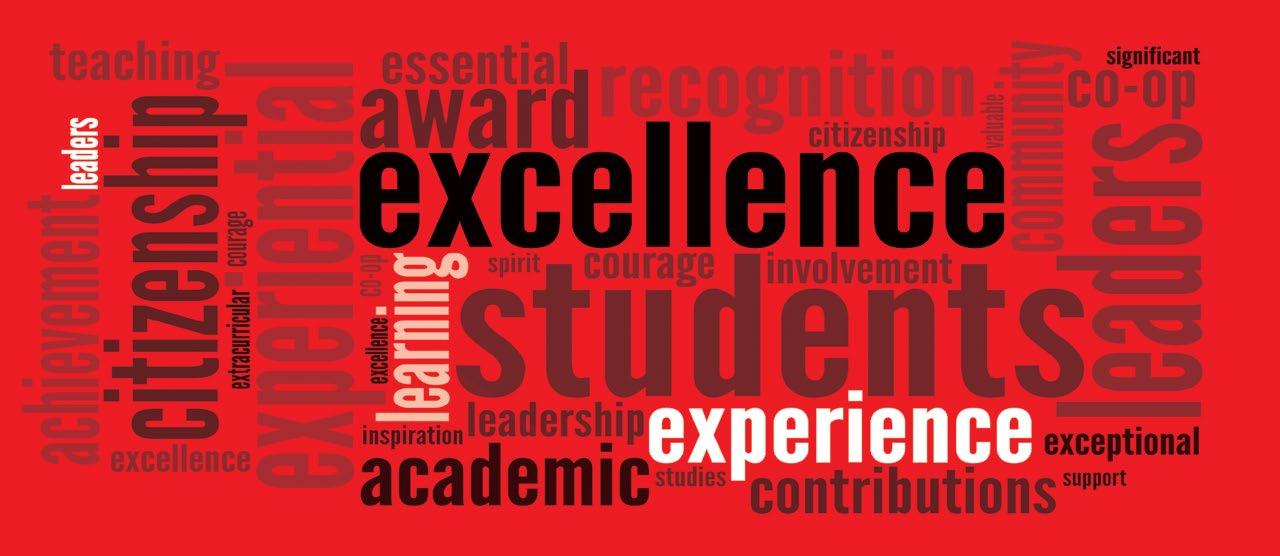
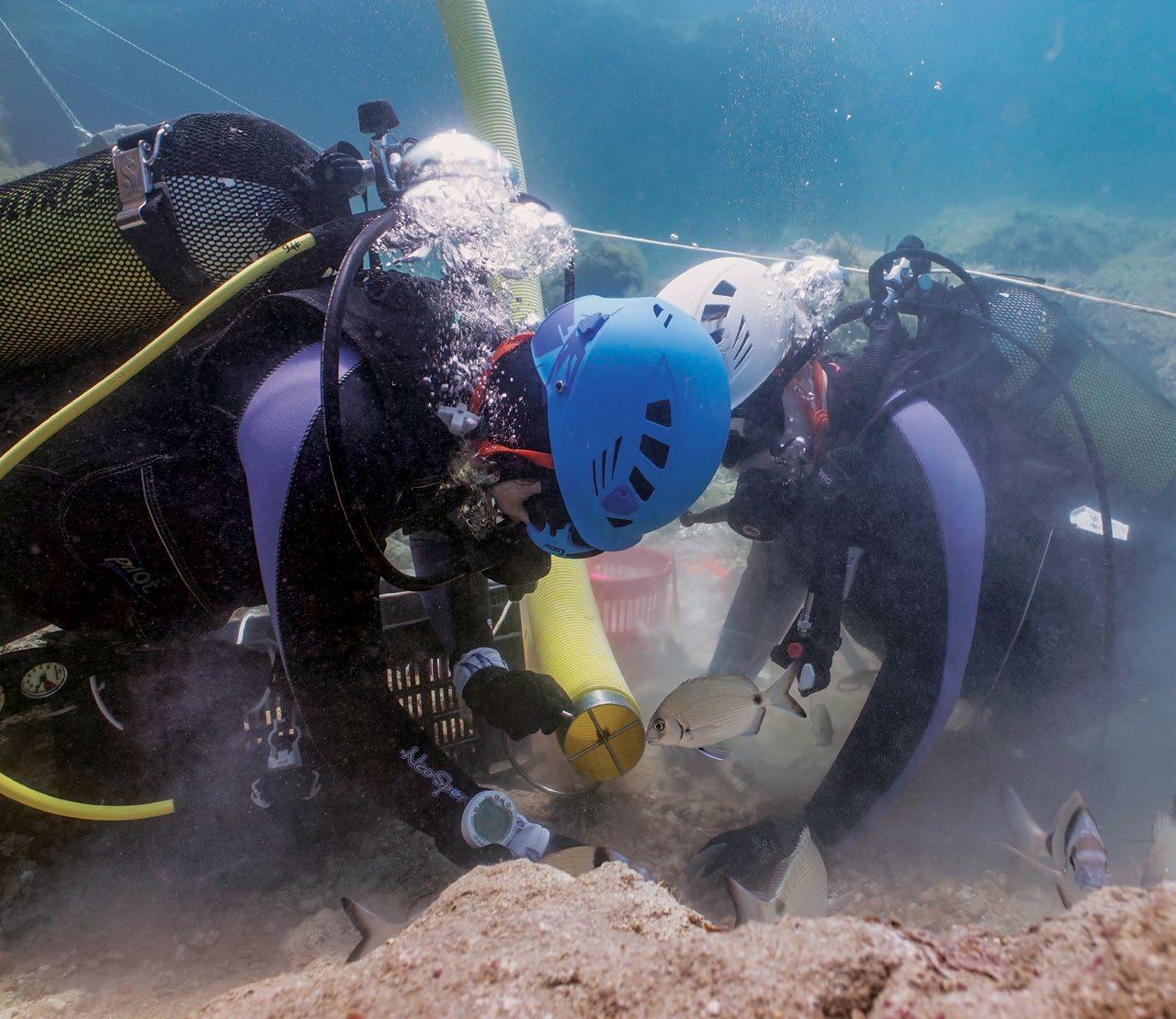
We can talk about revenue and expenses, but it is really our people and their accomplishments that make Brock University “BU.”
Pullout 1viii
Brock students Liz Hoffer (BA 2022), and Nicole Gavin (MA 2019) excavate a marble-carrying ancient shipwreck in Marzamemi, Sicily. Photo by Elizabeth S. Greene, courtesy of the Marzamemi Maritime Heritage Project.
STUDENT EXPERIENCE
STRATEGIC PRIORITY:
Offer a transformational and accessible academic and university experience.
To be a destination of choice for undergraduate, graduate and parttime students, we must ensure an academic and university experience that positively transforms our students’ abilities, understanding and impact on the world. We teach future-ready students and equip lifelong learners with a zest for knowledge, skills and competencies that will enable them to achieve their full academic, professional, career and life potential. Core to our student experience
is the development of engaged citizens who are resilient, involved, career-ready and versatile.
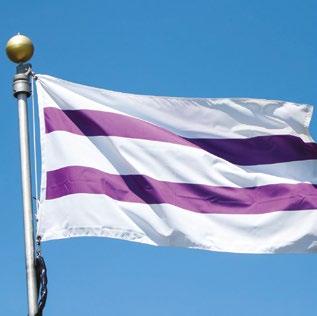
GOALS:
• Deliver high-quality programs that meet the interests and needs of students, and support them to achieve their potential in life.
• Expand Brock’s lifelong learning opportunities for our students and members of the community.

• Provide an engaging campus experience that meets students’ needs and affords social, cultural and recreational opportunities.
• Offer globally oriented learning and experience opportunities.
Time
A Brock first!
capsule messages
inspire Education grads
Nabiha Sabree was one of the Class of 2021 Concurrent Teacher Education graduates who were mailed inspiring messages they wrote to themselves when they started at Brock six years ago. Peter Vietgen, an Associate Professor in the Faculty of Education, kept the box filled with handwritten notes from students who in 2015 were embarking on their journey to become the next generation of teachers. 214 cards made their way back to their rightful owners. The Class of 2021 is the first to graduate from the sixyear Concurrent Teacher Education program since teacher education programs were expanded from one year to two by the Government of Ontario in 2015. brocku.ca/brock-news/2021/06/time-capsulemessages-inspire-education-grads/
Mental health aid
Mobile app offers Brock students 24-7 crisis counselling, mental health resources
Brock University students in need of mental health supports can access counselling and resources no matter the time of day. As part of the University’s ongoing commitment to the mental health of its students, the ‘My Student Support Program (My SSP)’ mobile app, shown above, was launched last year as a pilot project with LifeWorks (formerly Morneau Shepell) to proactively meet students’ needs and reduce barriers for support.
The My SSP app offers Brock students real-time, 24-7 confidential support with a professional licensed counsellor via telephone and text chat in five languages: English, French, Spanish, Mandarin and Cantonese. brocku.ca/brock-news/2021/07/mobile-appoffers-brock-students-24-7-crisis-counsellingmental-health-resources/
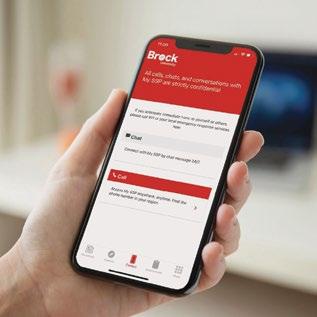
New scholarships
Faculty of Math and Science launches Indigenous scholarships
Three new scholarships have been created to support Indigenous students as they pursue programs in Brock’s Faculty of Mathematics and Science (FMS). Created through the Faculty’s Dean’s Strategic Discretionary Fund, the initiative will see 15 students provided with scholarship funding through FMS contributions of $110,000. The Faculty worked with Brock’s ViceProvost, Indigenous Engagement as well as Aboriginal Student Services to establish the scholarships, with the process guided by the common goal of fostering a culture of inclusivity, accessibility, reconciliation and decolonization.
brocku.ca/brock-news/2021/05/faculty-of-mathand-science-launches-indigenous-scholarships/
2021-22 Annual Report STUDENT EXPERIENCE 9
Brock University course using virtual reality to enhance online learning experience

Martin Danahay is taking his online teaching approach to a new level. The Brock University Professor in the Department of English Language and Literature hosted the class, WRDS/IASC/GAME 3P15 Writing for New Media, as part of his ongoing work to introduce virtual reality components into teaching. In 2018, he received a Chancellor’s Chair for Teaching Excellence award, which provided him funding to virtually bring together five students for a class using Oculus Quest headsets. The class advanced to 20 students with headsets entirely in 3D spaces.
brocku.ca/brock-news/2022/02/brock-university-course-using-virtualreality-to-enhance-online-learning-experience/
Medical Sciences student-athlete excelling on ice and in class
Third-year Medical Sciences student Rebekah Feld – who is also a Brock Badgers women’s hockey player – had the opportunity to job shadow Dr. Anna Kobylecky for a day last year at Niagara Health’s St. Catharines Site through Brock’s Med Plus program, a competitive four-year, non-credit program that runs concurrently with students’ academic studies. “It was the most unreal experience I’ve ever had,” said Feld. “I observed orthopedic surgery and even got the chance to hold an extracted gall bladder.” The unique co-curricular program includes job shadowing, networking opportunities with healthcare professionals, skill development workshops and community service projects.
brocku.ca/brock-news/2021/05/medical-sciences-student-athleteexcelling-on-ice-and-in-class/

Orientation offers second-year students resources for on-campus learning
When Brock’s second-year students continued their academic journeys in fall 2021, they experienced something new as they began on-campus learning for the first time as COVID-19 restrictions lessened. To ensure this new step was a comfortable one, a group of partners from across campus created the Year 2 Orientation program to help students become better acquainted with a campus that felt both new and familiar. Among the activities included is the LEAP UP program, which aims to connect students with the specific services and resources that will assist them in their university experience.
brocku.ca/brock-news/2021/08/orientation-offers-second-yearstudents-resources-for-on-campus-learning/
Brock Ambassador and fifth-year Concurrent Education Student Tricia Doma was among those delivering on-campus tours to interested second-year students.
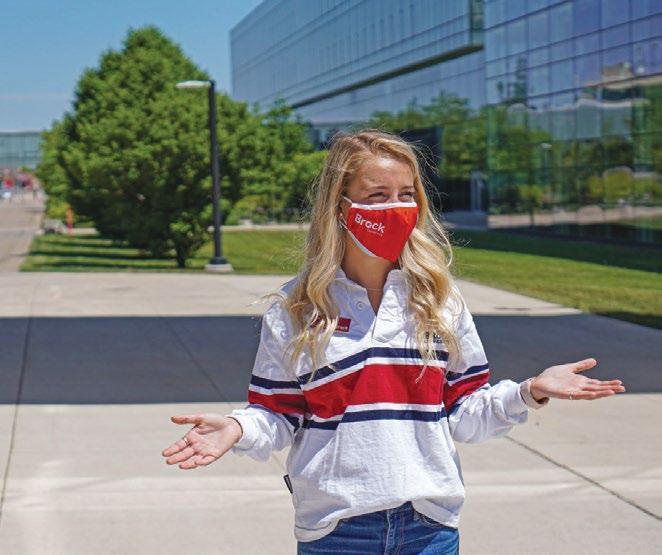
10 2021-22 Annual Report
EXPERIENCE
STUDENT
The Writing for New Media course, run for the first time in virtual reality, has students representing themselves with avatars in the virtual space.
Brock International Student Ambassadors prepare for Convocation
If you’ve walked the halls of Brock University or tuned into Brock International’s social media channels over the past four years, chances are you know them. Left to right, Marcelo Correa from Brazil, Ana Ferreira from Trinidad and Tobago and Santiago Negret Rey from Colombia, have been leaders within Brock’s international community throughout their undergraduate studies. They were first introduced as part of the inaugural group of 10 International Student Ambassadors in 2017 during Brock International’s Open House. Their academic achievements and community engagement both on and off campus saw them selected for the annual award every year of their academic career. brocku.ca/brock-news/2021/06/brock-international-student-ambassadorsprepare-for-convocation/
Horizon Scholarship
Personal experience drives Horizon Scholarship winner to help children with disabilities
Master of Applied Disability Studies student Nneka Onyeachonam is one of 20 inaugural winners of the Brock Horizon Graduate Student Scholarship presented to high-achieving graduate students from Black, Indigenous, People of Colour (BIPOC) and other underrepresented groups. For Onyeachonam, the line between personal and professional has long been blurred. She has been working in the disability field for more than 15 years, using her knowledge to help families, including her own, navigate what can be a difficult path. Two of Onyeachonam’s own children have been diagnosed with disabilities, helping to fuel her passion to make a difference. Onyeachonam feels receiving the Horizon Graduate Student Scholarship, which includes a one-time award of $5,000, was validation of her hard work.
brocku.ca/brock-news/2021/05/personal-experience-drives-horizonscholarship-winner-to-help-children-with-disabilities/

For all 2021-22 Horizon Scholarship recipients see: brocku.ca/brock-news/2021/12/brock-honours-2021-22-horizonscholarship-recipients/
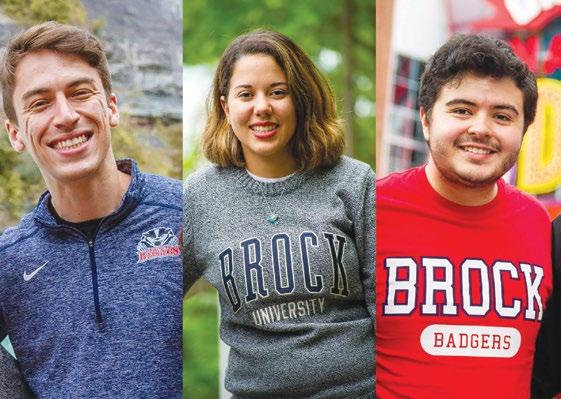
GAME students shatter expectations on Steam
When fourth-year Brock GAME students released their capstone project, Shatter Keep, for free on the Steam platform, they didn’t expect to get more than 100 downloads. It has since amassed more than 12,000 downloads. “We didn’t go in with too high expectations,” says Nitish Nair (BA ’21), who was the producer for the project. Shatter Keep was created for a fourth-year GAME capstone project. The project helped Jonathan Lopes (BA ‘21), the creative director on the project, land a job in the game industry quickly after graduation. Lopes and Nair advise future students to take advantage of opportunities outside of class to build their skills.
brocku.ca/brock-news/2021/08/game-students-shatter-expectations-onsteam/
Brock only Canadian university to win national accessibility competition in two categories
Impressing with creativity and ingenuity, two Brock University teams have won top honours in the Universities Canada Innovative Designs for Accessibility (IDeA) student competition for developing innovative, practical and cost-effective solutions to address barriers and challenges for people with disabilities. Winning first place in the virtual learning and distance education stream was a Brock team creating adaptive exercise programming online to help maintain and improve the various mobility needs of adults who identify as having a disability or neurodiversity. Winning second place in the attitudinal/systemic barriers category was a team with proposed app called SHELS: Sexual Health, Education, Love, and Support that would provide disabled populations much-needed sexual violence support, sexual health education and self-care practices all in one place.
brocku.ca/brock-news/2021/07/brock-only-canadian-university-to-winnational-accessibility-competition-in-two-categories/

2021-22 Annual Report STUDENT EXPERIENCE 11
Brock students pitch ideas to create global change with WWF-Canada
Three Brock undergraduate students joined more than 100 post-secondary learners from across Canada to help create a more sustainable future. Kassie Burns, a third-year Biological Sciences student with a minor in Environmental Sustainability, Jercin Elsa Koshy, a first-year Public Health student, and Jordan Sheridan, a second-year Biological Sciences and Med Plus student with a minor in Classics, made it to the final round of presentations at the Designing Change for a Living Planet 2021 conference and competition, hosted annually by World Wildlife Fund Canada (WWF-Canada). Included in the students’ proposal was an expansion of Brock’s Campus-Wide Co-Curriculum Certificate of Engagement to include an Environmental Action domain to engage students in conservation and sustainable actions to help the environment. brocku.ca/brock-news/2021/06/brock-students-pitch-ideas-to-create-globalchange-with-wwf-canada/
Academic Initiatives Fund supports creation of Education micro-credentials
The Faculty of Education’s pilot micro-credential initiative is one of 18 projects that have received seed funding through Brock’s new Academic Initiatives Fund (AIF) to address key priorities in the University’s Institutional Strategic Plan and aid with Brock’s pandemic recovery. “Graduating students and adult learners will need to develop and re-learn skills throughout their careers,” said Michael Owen, Dean of the Faculty of Education. “As a Faculty, we recognize that student recruitment and retention take many forms, particularly in case of adult students who are often working while pursuing further education.” For current students, these micro-credentials will offer opportunities to build transferrable skills for the workplace. For new students, micro-credentials will serve as terminal market-focused credentials and pathways to certificates and degrees.
brocku.ca/brock-news/2021/12/academic-initiatives-fund-supports-creation-ofeducation-micro-credentials/
Niagara history
Grad student earns scholarship for digitizing Niagara history
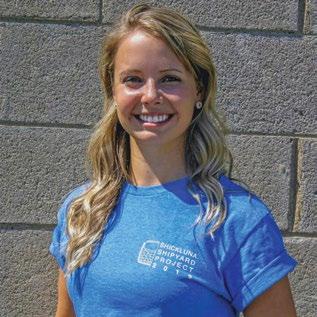
At first glance, history and technology may not appear to go hand in hand, but Jessica Linzel (BA ’18) has shown they can make the perfect pair. The Brock Master of Arts in History candidate used geographical information systems (GIS) software to translate historical information about colonial trade routes into spatial analysis – and a national organization took notice. Linzel was honoured with the prestigious Esri Canada GIS Scholarship, which recognizes work in geospatial sciences by students in universities around the world. The scholarship is presented by Esri Canada, a company that creates GIS software to digitize the geography of the world.
brocku.ca/brock-news/2021/06/grad-studentearns-scholarship-for-digitizing-niagara-history/
BIHS Bursary
New bursary launched for Black and Indigenous Brock student-athletes
Brock University is introducing a new bursary award to provide additional financial support to student-athletes who self-identify as either Black or Indigenous. The Black or Indigenous Heritage Student-Athlete (BIHS) bursary aims to support studentathletes who demonstrate financial need and is not centred around athletic achievement. “We are excited to introduce this bursary to help students who identify as Black or Indigenous achieve their post-secondary goals,” said Interim President and Vice-Chancellor Lynn Wells. The current amount of the BIHS bursary will allow for 25 awards of up to $2,000.
brocku.ca/brock-news/2022/03/new-bursarylaunched-for-black-and-indigenous-brock-studentathletes/

BIPOC Award
FAHS launches new Diversity and Inclusion Award
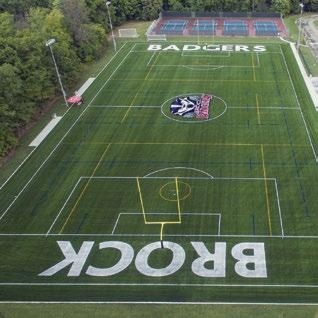
A new Faculty of Applied Health Sciences (FAHS) fundraising initiative is aiming to increase representation of and support for Black, Indigenous and People of Colour (BIPOC) students enrolled in the Faculty’s programs. Dean Peter Tiidus says fostering a culture of diversity and inclusivity across the University starts with a commitment to Brock’s Institutional Strategic Plan. “We recognize the strength and benefits a diverse population brings to our community,” Tiidus says. In response, a new $25,000 gifts initiative has been launched to support the development of a new award, named the Faculty of Applied Health Sciences Diversity and Inclusion Award.
brocku.ca/brock-news/2021/10/fahs-launches-newdiversity-and-inclusion-award/
12 2021-22 Annual Report STUDENT EXPERIENCE
New programs/course offering highlights:
Bachelor of Nursing/Master of Nursing
– Faculty of Applied Health Sciences
Brock University’s new concurrent Bachelor of Nursing/ Master of Nursing (BN/MN) program, the first of its kind in Canada, is an innovative, course-based program designed to provide students with a high-quality alternative entry to practice that includes a hands-on and theoretical approach. The 20-month expedited program offers students opportunities to gain experience in five areas, including knowledge-based practice and self-regulation. The innovative approach to the program structure provides students with a balance of clinical and theoretical experience.
brocku.ca/brock-news/2022/02/brock-launches-canadas-first-acceleratedconcurrent-nursing-program/ PhD in Sustainability Science
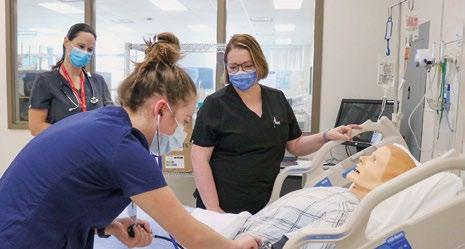

– Faculty of Social Sciences
Brock University’s Environmental Sustainability Research Centre (ESRC) has launched a PhD in Sustainability Science, the first program of its kind in the country. Offered by only a few leading institutions internationally, the PhD in Sustainability Science marks Brock’s 10th doctoral program and will welcome its first cohort in Fall 2022. ESRC Assistant Professor Jessica Blythe says the PhD program offers a scholarly opportunity for changemakers who are keen to address some of the pressing issues of our time.
brocku.ca/brock-news/2021/10/brock-launches-canadas-first-phd-insustainability-science/ Master of Arts in Game Studies
– Faculty of Humanities
Brock University’s new Master of Arts (MA) in Game Studies, the first program of its kind in Canada, is an interfaculty and interdisciplinary program designed to provide students with a high-quality venue for studying and designing games in all their forms. The two-year program, starting in Fall 2022, offers students opportunities to engage with scholarly and professional literature, exploring the key debates within the discipline.
brocku.ca/brock-news/2021/10/brock-launches-canadas-first-master-of-artsin-game-studies/
Canadian Culture and Education Studies and Leadership in Community-based Education – Faculty of Education
Brock University’s Faculty of Education has launched two new certificates, Canadian Culture and Education Studies (CCES) and Leadership in Community-based Education (LCBE), designed to assist internationally educated students as they pursue advanced post-secondary studies in Canada and obtain work in community-based educational settings.
brocku.ca/brock-news/2022/02/faculty-of-education-launches-newcertificates-for-international-students/
Visual Arts course examining the anatomical body in historical texts – Faculty of Humanities

The new course, open to all Brock University students, will critically examine anatomical illustrations throughout history and unpack what these visual representations reveal culturally, socially and artistically.
brocku.ca/brock-news/2022/03/new-visual-arts-course-examines-theanatomical-body-in-historical-texts/
Brock adds to lineup of virtual learning resources – Faculty of Humanities and Faculty of Mathematics and Science Virtual Learning Strategy funding from the Ontario Ministry of Colleges and Universities via eCampusOntario has led to the creation of added History and Mathematics and Statistics online learning options for Brock students.
A new course from Assistant Professor of Mathematics and Statistics Pouria Ramazi will see students learn how to use complex machine learning models through short videos that break up the material into easy-to-learn pieces for a broader audience that may have less background knowledge on the subject. Meanwhile, the latest addition to the History course catalogue has Associate Professor of History Daniel Samson helping students to explore 18th century settler colonialism through the examination of primary sources.
brocku.ca/brock-news/2022/04/brock-adds-to-lineup-of-virtual-learningresources/
13 2021-22 Annual Report STUDENT EXPERIENCE
RESEARCH
STRATEGIC PRIORITY: Build research capacity across the University
Our research focus is central to our identity. Brock will invest in building a world-leading research institution, grounded in scholarly excellence and strong graduate and postgraduate programs. We will leverage our strengths within and across disciplines to enhance research impact.
GOALS:
• Nurture a culture of research and creative excellence.
• Invest in research infrastructure and support to ensure sustainable and accessible research services for the Brock scholarly community.
• Enhance transdisciplinary research and high-impact research practices.
• Build awareness of Brock University as a centre of research excellence.
Evolution COVID-19 Soil protection
Machine learning to predict future of COVID-19

The rise and fall of COVID-19 cases depends on countless factors, but new Brock University research is able to harness that data and predict various scenarios related to the virus up to 10 weeks in the future. With researchers from University of Alberta, Assistant Professor Pouria Ramazi, of Brock’s Department of Mathematics and Statistics, is using machine learning and artificial intelligence (AI) algorithms to make these critical predictions. Funded by Alberta Innovates, the project sees COVID-19 related data sets, such as Google mobility data, temperature and number of intensive care unit beds, fed into an AI algorithm to help predict the outcome of proposed preventive policies and to advance scientific research. brocku.ca/brock-news/2021/05/brock-research-usesmachine-learning-to-predict-future-of-covid-19/
Pace of evolution faster than previously thought
In response to targeting by trophy hunters, wild populations of bighorn sheep are now growing 10 per cent smaller horns than they did less than 20 years ago as a way to adapt and minimize the risk to their species. That rapid evolutionary interplay between hunter and hunted is an example described in a recently accepted paper in the Journal of Molecular Ecology entitled “The Pace of Modern Life, Revisited,” co-authored by a research team at Brock University. The research by the paper’s co-senior author, Brock University Assistant Professor of Biological Sciences Kiyoko Gotanda, along with colleagues at 10 institutions around the world, shows evolution can be seen within a lifetime. brocku.ca/brock-news/2021/12/brock-researchfinds-pace-of-evolution-faster-than-previouslythought/

Brock prof studies naturebased methods of mitigating climate change impacts

Extreme weather events such as heavy rainfall or droughts have major impacts on farmlands, including soil erosion, damage or loss of crops and insect pest invasion. Brock biologist Liette Vasseur is researching ways in which cover crops, plants growing in addition to the crop, can contribute in protecting soils against climate change effects. Cover crops are plants – typically legumes, grasses or herbaceous flowering plants – that are planted to stop soil erosion and increase nutrients in the soil. Vasseur’s research project involves studying unique cover crops, rootstocks and irrigation techniques for Canadian vineyards.
brocku.ca/brock-news/2021/11/video-brock-profstudies-nature-based-methods-of-mitigatingclimate-change-impacts/
14 2021-22 Annual Report RESEARCH
okoGotanda
Brock’s Niagara Community Observatory – remote work as a long-term strategy
Remote work shouldn’t be for every organization, but when it’s done right, it can be a boost for worker wellbeing and help maintain “a healthy and productive work culture,” says new Brock University research. “For those organizations that do choose some form of remote work, our research suggests that success depends on building a culture rooted in human connection, supported with clear communication plans, the right digital tools and a compatible managerial style,” says Kate Cassidy, co-author of the latest brief produced by Brock’s Niagara Community Observatory (NCO). “To be, or not to be, remote? Examining the essential factors needed for ongoing remote work success,” explores the benefits and potential downsides of remote work. brocku.ca/brock-news/2021/10/brocks-niagara-community-observatoryexamines-remote-work-as-a-long-term-strategy/

Brock awarded more than $500K in federal funds
for early-stage research
As one of nine Brock University researchers who received an Insight Development Grant from the Social Sciences and Humanities Research Council of Canada, Professor of Finance Ernest Biktimirov is exploring the relationship between the price of houses and people’s attitudes and beliefs about the housing market as conveyed in news stories. “Research results will help develop recommendations on house price movements for households, real estate investors and developers, regulators and policymakers,” says Biktimirov. Vice-President, Research Tim Kenyon says he is pleased by the number of Insight Development Grant recipients this year. “Our researchers’ curiosity and creativity have propelled them to expand into novel areas, contributing fresh insights on issues that are important to society,” he says. brocku.ca/brock-news/2021/08/brock-awarded-more-than-500k-in-federal-fundsfor-early-stage-research/
Accounting research unearths true cost of cheap conflict minerals
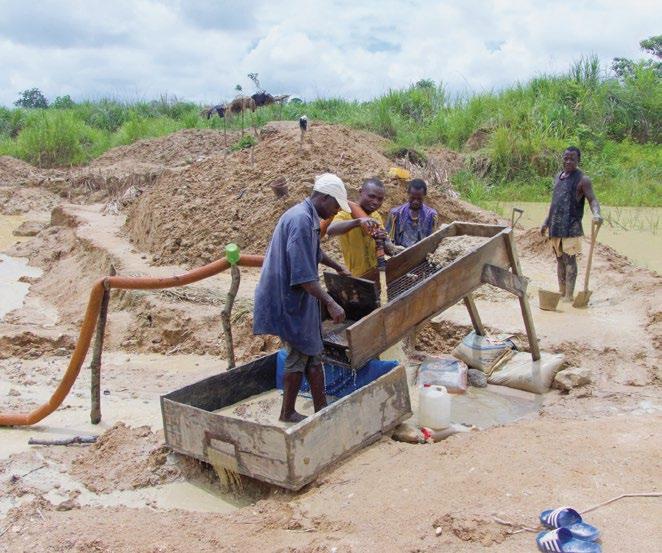
Cheap in the short term – expensive in the long term – when sourcing minerals mined in conflict zones, is what a Brock research team has found. Professor of Accounting, Fayez Elayan is lead author of a paper published in the Journal of Business Ethics, which examines if and how investors value mandatory human rights disclosures of conflict mineral usage. Elayan and his colleagues examined the files of 3,639 U.S. registrants to determine the market’s reaction to companies’ disclosures concerning their sourcing of minerals originating from conflict zones.
brocku.ca/brock-news/2021/07/accounting-research-unearths-truecost-of-cheap-conflict-minerals/
Brock team awarded $250,000 grant to
explore links between childhood adversity and allergies
A Brock University research team is conducting a first-ofits-kind study to see if and how abuse, severe household dysfunction and other childhood traumas set the stage for a lifetime of suffering with allergies. “Allergy prevalence is rising rapidly and understanding why requires new transdisciplinary thinking, outside the box,” says Associate Professor of Health Sciences Adam MacNeil. “Many of the contributing factors remain elusive.” Assistant Professor of Health Sciences Karen Patte says the team is “taking a unique approach by linking sociology and psychology with immunology and physiology – fields that seldom collaborate – to help determine the mechanisms linking childhood adversity and allergies.” brocku.ca/brock-news/2021/06/brock-team-awarded-250000-grant-to-explorelinks-between-childhood-adversity-and-allergies/
15
Associate Professor of Health Sciences Adam MacNeil and Assistant Professor of Health Sciences Karen Patte are heading a Brock University research team that is conducting the study.
2021-22 Annual Report RESEARCH
Workers sift for precious metals and minerals at a mine in the Democratic Republic of Congo.
Brock team wins national video competition for research on LGB substance use
A Brock University research team has found that lesbian, gay and bisexual (LGB) people in Ontario are at greater risk of requiring urgent medical attention due to substance abuse compared to their heterosexual counterparts. PhD student Celine Teo and master’s student Sukhdeep Kaur presented these and other results in a video they prepared for a policy challenge offered by the Canadian Research Data Centre Network. Their video, “Substance-related acute care disparities by sexual orientations in Ontario,” captured first place in the national competition. brocku.ca/brock-news/2021/07/brock-team-wins-national-videocompetition-for-research-on-lgb-substance-use/
Brock Canada Research Chair honoured by national plant biology association
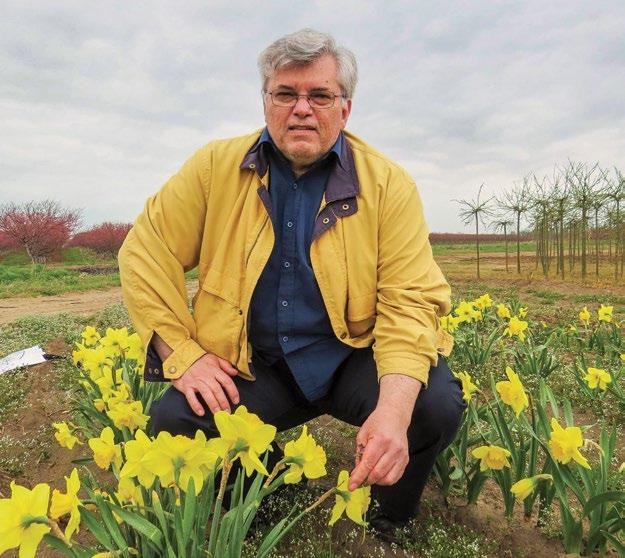
Brock University Professor of Biology and Canada Research Chair Vincenzo De Luca was honoured recently with the Canadian Society of Plant Biologists (CSPB)’s Gold Medal for his research on plants and anti-cancer drugs. De Luca, and more than 100 of his students, have spent years examining how an alkaloid called vinblastine found in the Madagascar periwinkle is biosynthesized, a process that converts simple molecules through enzyme catalysts into more intricate products. For his part, De Luca says one of his most satisfying accomplishments is transmitting his research knowledge, skills, interest and enthusiasm to the next generation, brocku.ca/brock-news/2021/07/brock-canada-research-chair-honoured-bynational-plant-biology-association/
Brock University receives NSERC and SSHRC funding
Brock University researchers have been awarded $1.4 million in funding from the Natural Sciences and Engineering Research Council of Canada (NSERC). Six researchers received funding from the Discovery Grants program and two through the Research Tools and Instruments program. Among the NSERC award recipients is Canada Research Chair in Bone and Muscle Development, Kinesiology Professor Wendy Ward. With her Discovery Grant, Ward’s research team will be exploring whether natural chemicals called polyphenols found in rooibos tea (a type of herbal tea) will help mothers’ bones to form more mineral and become stronger after pregnancy and lactation, a time when bone cell activity is very active.
In addition, six graduate students were awarded $0.2 million in NSERC graduate student awards. Among the recipients is Robert Crozier, a PhD student in the Faculty of Applied Health Sciences who is examining the effects of naturally occurring chemicals from the rosemary plant on allergic inflammation. The NSERC funding will allow Crozier and his team to develop their early-stage discovery research, helping to draw attention and pave the path for plantderived compounds as anti-allergy therapeutics.
As part of Social Sciences and Humanities Research Council of Canada (SSHRC)’s Insight Grant program, which supports research excellence proposed by scholars and judged worthy of funding by their peers and/or other experts, Brock researchers were awarded more than $0.9 million. “NSERC and SSHRC are vital sources of support for the leading-edge research we conduct at Brock University,” says Vice-President, Research Tim Kenyon. “We are grateful for the extensive funding awarded to Brock scholars in so many fields, through these highly competitive national programs.”
brocku.ca/brock-news/2021/06/brock-researchers-awarded-more-than-23m-in-federal-nserc-and-sshrc-grants/ brocku.ca/brock-news/2022/01/grad-student-researchers-receive-196000in-federal-funding/

16
Recent master’s graduate Sukhdeep Kaur (MSc ’21), Associate Professor of Health Sciences Antony Chum and PhD student Celine Teo. Teo and Kaur produced a video that captured first place in a national competition offered by the Canadian Research Data Centre Network.
2021-22 Annual Report RESEARCH
Memory & spirituality
Brock awarded more than $440k from CIHR for research on older adult memory, child spirituality
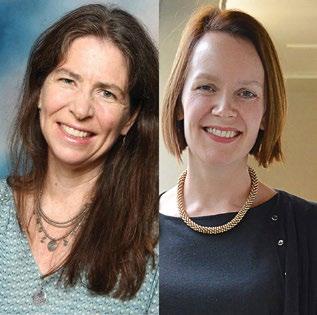
Brock Assistant Professor of Health Sciences Valerie Michaelson (left) and Brock Professor of Psychology and Canada Research Chair in Cognitive Neuroscience of Aging Karen Campbell (right) have received funding from the Canadian Institutes of Health Research for their research on child spirituality and age-related declines in associative memory, respectively. Identifying ways to help older adults remember events and understanding how spirituality shapes the physical health conditions of young people are the goals of two Brock University research projects recently funded by the Canadian Institutes of Health Research (CIHR). Karen Campbell is using her five-year CIHR Project Grant to research mechanisms in the brain and nervous system that contribute to age-related declines in associative memory. With her one-year CIHR Bridge Grant, Valerie Michaelson will be pursuing her research project “Establishing Spirituality as a Social Determinant of Health.” brocku.ca/brock-news/2022/03/brock-awarded-more-than-440k-fromcihr-for-research-on-older-adult-memory-child-spirituality/
Brock part of national research team setting up EEG data-sharing system
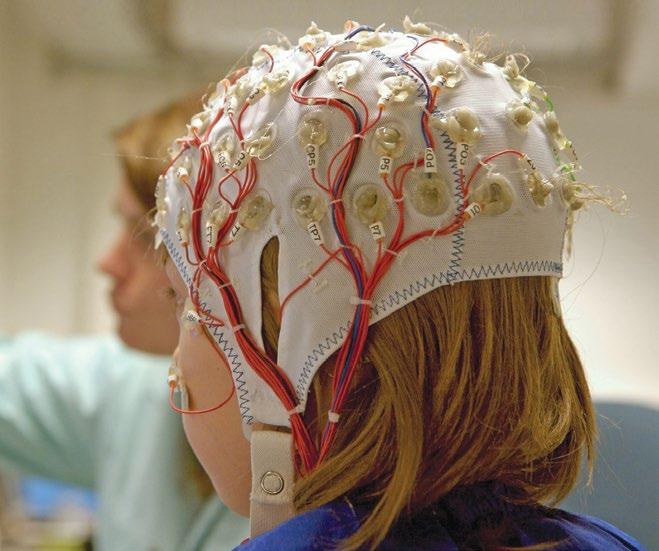
Brock researchers are part of a team that is developing a system to share data collected from electroencephalography (EEG), which is a technique used by researchers and clinicians to measure electrical signals in the form of brainwaves, gathered by electrodes placed on the scalp of participants. These data are used to enable scientists to better study and potentially detect early signs and progress of a wide variety of psychological conditions and behavioural disorders in childhood, as well as neurodegenerative diseases and conditions in aging. Brain Canada, a national charitable organization that supports brain research, has awarded the team $1.8 million to create EEGNet.
brocku.ca/brock-news/2021/08/brock-part-of-national-research-teamsetting-up-eeg-data-sharing-system/
Future educators share ideas for nature learning
Students in CHYS 2P16: Principles of Community Engagement in Education spent the last day of the Winter 2022 Term classes sharing their research and enjoying the natural wonders of Ball’s Falls Conservation Area. The event marked the completion of a term project that saw students in the Department of Child and Youth Studies second-year course research two key areas in support of the education-related programs offered by the Niagara Peninsula Conservation Authority (NPCA). Students examined how the NPCA’s nature school, day camps and field trips could provide children and youth with improved and more equitable access to green spaces and new ways to promote the development of environmental stewardship among children and youth.
brocku.ca/brock-news/2022/04/future-educators-share-ideas-for-naturelearning-with-community/

2021-22 Annual Report RESEARCH 17
Brock chemistry team creates modified sugar molecules used in medicines
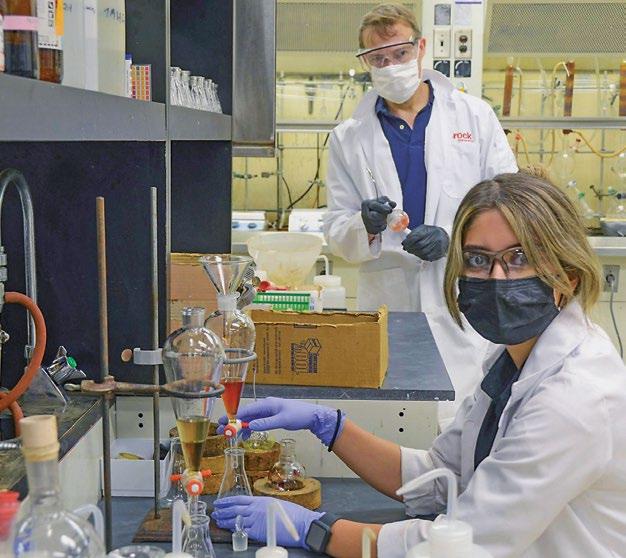
In partnership with Simon Fraser University, Travis Dudding, Brock University Chemistry Professor and his team are making glycomimetics, modified natural sugars that are “essential bio-molecules” vital for fundamental biological processes such as cells passing signals to one another. “With these designer sugars, we’re interested in making sugars with favourable properties for drug applications, such as having longer lifetimes in the body and improved binding affinities to receptors in the body, assisting in cell signalling, or processes where sugars are needed,” says Dudding. brocku.ca/brock-news/2021/09/brock-chemistry-team-createsmodified-sugar-molecules-used-in-medicines/
Brock chemistry group key contributor to North American team researching Vitamin E
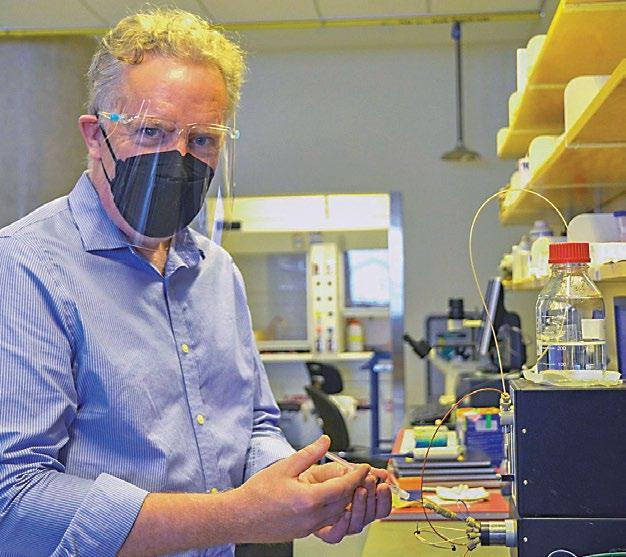
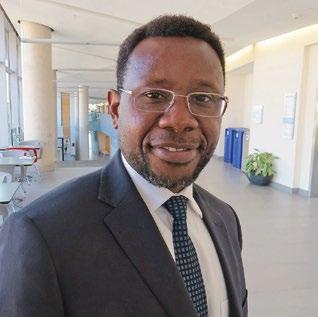
Vitamin E has long been believed to be an antioxidant, a substance that protects cells from damage caused by molecules that may play a role in cancers, heart disease and other illnesses. Some scientists believe Vitamin E has additional medicinal functions beyond being an antioxidant, but it has been nearly impossible to test that theory, says Brock University Professor of Chemistry Jeffrey Atkinson. Atkinson’s research could shed new light on Vitamin E’s full functions. Atkinson is a key contributor to a North American research team recently awarded US $2.1 million from the U.S. government’s National Institutes of Health (NIH).
brocku.ca/brock-news/2021/08/brock-chemistry-group-key-contributor-tonorth-american-team-researching-vitamin-e/
Horticultural management
Brock team awarded provincial funding to study best management practices in horticulture
Growing and harvesting fruits and vegetables on a large scale is tricky business. The soil quality has to be good, there needs to be plenty of water, the right pesticides have to be used properly, and, as a whole, the industry should be managed efficiently and effectively. There are experts who have information and knowledge on these and other areas, but a lack of a consistent, co-ordinated approach that connects experts, government officials and farmers to share knowledge is holding the Niagara and Ontario industry back, says Associate Professor of Political Science and Director of Brock’s Niagara Community Observatory (NCO) Charles Conteh. He is heading a research team examining knowledge transfer and knowledge translation in Ontario’s horticultural industry as the bedrock of building best management practices in the sector with a grant from the Ontario Ministry of Agriculture, Food and Rural Affairs (OMAFRA). Conteh says the heart of the project involves putting knowledge and information into farmers’ hands. OMAFRA is supporting this work with a $115,000 grant. brocku.ca/brock-news/2021/06/brock-team-awarded-provincial-funding-tostudy-best-management-practices-in-horticulture/
18 2021-22 Annual Report RESEARCH
Research
(IPBS)
Monitoring grapes Climate change
CCOVI data forecasts another excellent year for Niagara wines

Cool Climate Oenology and Viticulture Institute (CCOVI) Technician Lisa Dowling analyzes the grapes collected for the institute’s Preharvest Monitoring Program for key indicators of ripeness each year. The program has been tracking the progress of Niagara’s grapes at four sites across the Niagara Peninsula every year since 2010. CCOVI Director Debbie Inglis says “The program is not only a valuable tool for navigating the complexities of harvest each year to determine harvest dates, but it also serves as a historical database that researchers and the industry can use to compare growing season conditions and fruit maturity over time, in order to support the collective work done to continually produce high-quality wines.” brocku.ca/brock-news/2021/08/ccovi-dataforecasts-another-excellent-year-for-niagara-wines/
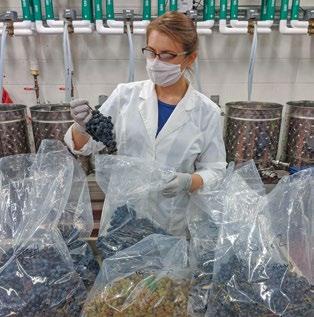
Water treatment
Brock economist to carry out national water survey as part of oil sands research Scientists are studying ways that plants and their associated microbes can clean up wastewater from oil sands processes using constructed wetland treatment systems. The big question is: will the public support such an approach? Brock University economist Diane Dupont is creating a national public survey to gauge the extent to which people value technologies that harness the power of ecosystem services in the natural environment. “The benefits provided by plants and microbes are not directly purchased from a shelf or traded in the marketplace,” says Dupont, whose work will focus on ecosystem services from plants that filter and clean water. brocku.ca/brock-news/2021/10/brock-economistto-carry-out-national-water-survey-as-part-of-oilsands-research/

Brock prof researches community response to climate change
Jessica Blythe is an Assistant Professor in Brock University’s Environmental Sustainability Research Centre whose research follows three themes: examining the conditions under which transformations to more sustainable and equitable futures may occur; exploring how the costs and benefits of various ocean governance arrangements are unevenly distributed across people and places; and, examining how adaptation to climate change can promote equity, reduce vulnerability and foster socialecological sustainability. Blythe is pursuing this community research through the Niagara Adapts Innovative Partnership project, which aims to protect Niagara residents from the impacts of climate change by developing and implementing evidence-based climate adaptation plans. brocku.ca/brock-news/2021/10/video-brock-profresearches-community-response-to-climate-change/
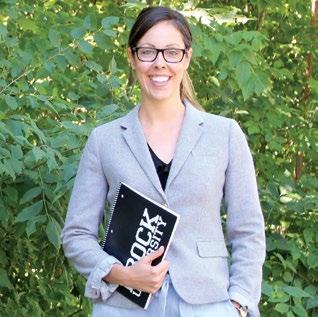
19 2021-22 Annual Report RESEARCH
Scholars grant recipients announced by Goodman Goodman School of Business has announced recipients of its inaugural Research Scholars program. Faculty have received grants from five research funds created in conjunction with CPA Ontario (CPA), the International Partnership of Business Schools
and the Goodman School of Business (GSB). “These opportunities contribute to the advancement of theoretical or methodological approaches through multiple high-quality independent programs of research,” says Tek Thongpapanl, Goodman’s Associate Dean of Research and Graduate Programs. brocku.ca/brock-news/2021/11/research-scholars-grant-recipientsannounced-by-goodman/
Recipients of the Goodman School of Business’ inaugural Research Scholars program include (clockwise from top left) Fayez Elayan, Professor of Accounting; Samir Trabelsi, Professor of Accounting and Governance; Wesley Helms, Associate Professor of Strategic Management; Magnus Hultman, Assistant Professor of Marketing; and Simon Suwanyangyuan, Assistant Professor of Accounting.
Brock research shows lags and promise in municipal-Indigenous relations
A new research paper suggests relations between municipalities and urban Indigenous populations can provide a means of enacting changes recommended by the Truth and Reconciliation Commission (TRC) if appropriate steps are taken. In “Municipal-Indigenous Relations in Ontario: Initiatives in Brantford, Hamilton, and Niagara,” which will soon appear in the Journal of Canadian Studies, Brock University Assistant Professor of Political Science Joanne Heritz analyzes the current level of engagement with urban Indigenous populations in the single-tier municipalities of Hamilton and Brantford, and the upper tier of the two-tiered municipality of Niagara Region.
brocku.ca/brock-news/2021/12/brock-research-shows-lags-and-promise-inmunicipal-indigenous-relations/
CFI awards Brock more than $623,000 for
specialized research equipment
Brock University’s newest Canada Research Chairs (CRC) will be purchasing state-of-the-art equipment thanks to funding from the Canada Foundation for Innovation (CFI). The CFI has awarded Paula Duarte-Guterman, Matthew Kwan, Danielle Sirianni Molnar and Newman Sze $623,933 for specialized infrastructure through its John R. Evans Leadership Fund. “CFI’s investment in Brock University is critical support for the cutting-edge discoveries our researchers are making,” says Brock Vice-President, Research Tim Kenyon. “This funding enables a better understanding of mental health in youth, diseases that affect us as we age, and how experiences remodel the brain across the lifespan – all areas that impact many people in society.”
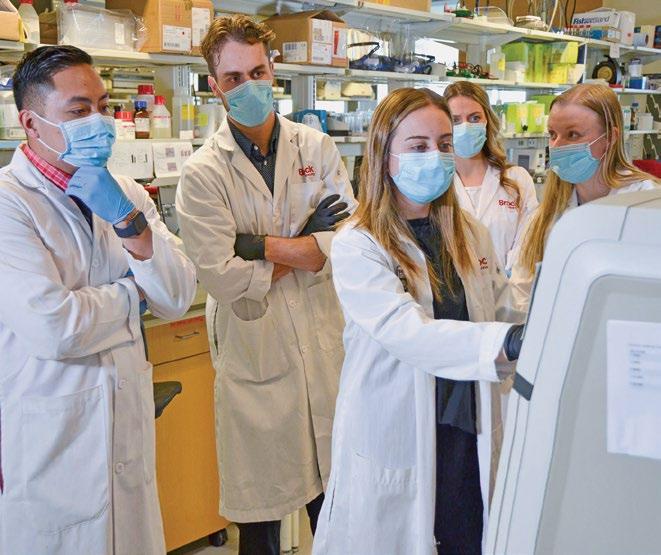
brocku.ca/brock-news/2022/01/cfi-awards-brock-more-than-623000-forspecialized-research-equipment/
New Brock research explores time travel paradoxes
Assistant Professor of Physics Barak Shoshany, along with fourth-year Physics student Jared Wogan, recently published a paper titled “Wormhole Time Machines and Multiple Histories.” In true sci-fi fashion, the paper discusses a theoretical model of a time machine created using a wormhole – a ‘shortcut’ through space and/or time. A wormhole can connect two very distant points in space, such as two stars, enabling quick travel between them without the limitation of the speed of light. It can also connect two points in time, potentially enabling travellers to go back in time. This is called a wormhole time machine.
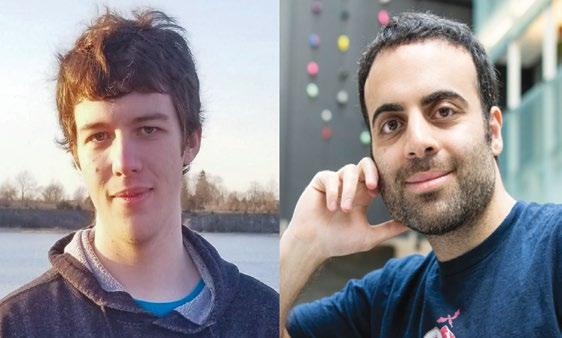
brocku.ca/brock-news/2021/12/new-brock-research-explores-timetravel-paradoxes/
Canadian Space Agency awards Brock team funding for space health
Val Fajardo, Assistant Professor, Kinesiology and Canada Research Chair in Tissue Plasticity and Remodeling, is heading up a team that’s investigating how to prevent space travellers from experiencing muscle loss and weakness, bone fragility and cognitive decline, which occur when spending time in space. On April 5, 2022, the Canadian Space Agency announced it had granted Fajardo and his team $150,000 to carry out this research, one of nine projects being conducted at universities across Canada, “to ultimately better understand the effects of space on the human body.” brocku.ca/brock-news/2022/04/canadian-space-agency-awards-brockteam-funding-for-space-health/
From left: Fajardo, master’s student Ryan Baranowski, PhD student Jessica Braun, master’s student Briana Hockey and master’s student Emily Copeland.
2021-22 Annual Report RESEARCH
20
Fourth-year Physics student Jared Wogan (left) and Assistant Professor of Physics Barak Shoshany.
COMMUNITY ENGAGEMENT
STRATEGIC PRIORITY: Enhance the life and vitality of our local region and beyond
Brock is committed to working with the communities in Niagara, Ontario, Canada and the world. Through local and global connections, we increase opportunities for the residents of Niagara. By responding to the needs of society and supporting its growth and development, we strengthen community vitality and vibrancy.
•
GOALS:
•
•
•
Ergonomics
Brock prof’s video series explains environmental ergonomics to general audiences
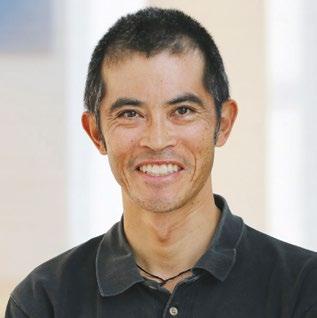
Is work productivity worse during a heat wave? Does daylight saving time increase physical activity in children? Is there a higher risk for COVID-19 transmission in ice rinks? At first glance, these questions don’t seem to have a lot to do with one another, but they are all examples of how our surroundings impact our bodies. The questions are also titles of three of more than two dozen videos Brock University’s Stephen Cheung has produced to explore environmental ergonomics, the study of how people interact with their outdoor and indoor physical environments. The series communicates insights, concepts and knowledge gathered by researchers in various parts of the world.
brocku.ca/brock-news/2021/05/brock-profs-videoseries-explains-environmental-ergonomics-togeneral-audiences/
Pathways
Brock Makerspace launches new learning pathways

The Brock University Library Makerspace has launched a new series of themed and curated ‘pathways’ that combine a variety of online workshops with hands-on maker hours. Workshops help participants build their knowledge, develop new skills and generate innovative ideas, while maker hours allow time to complete small and easy-to-approach projects alongside Makerspace staff. Participants will complete each pathway with the confidence to explore new technologies. The Library Makerspace is a collaborative space open to the Brock and Niagara communities to gain access to new and emerging technologies, such as audio production, photo/video production, 3D prototyping, virtual reality, robotics and digital prototyping.
brocku.ca/brock-news/2022/01/brock-makerspacelaunches-new-learning-pathways/
Partnerships
Brock research teams awarded federal funding for community partnerships
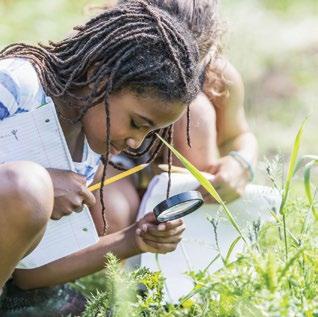
Three Brock University teams have received a boost in funding for projects that aim to help Niagara organizations meet the needs of women and children during the pandemic and provide opportunities for Indigenous communities in the region’s tourism industry. The Social Sciences and Humanities Research Council of Canada (SSHRC) has awarded the researchers a total of $57,477 through the Partnership Engage Grant (PEG) program, which provides short-term support for partnered research activities that respond to immediate needs and time constraints facing public, private or not-for-profit organizations in non-academic sectors.
brocku.ca/brock-news/2021/09/brock-researchteams-awarded-federal-funding-for-communitypartnerships/
21 2021-22 Annual Report COMMUNITY ENGAGEMENT
Increase and enhance enriching opportunities for our students, alumni, faculty and staff to engage with the community.
Support regional economic, social and cultural vitality.
Enhance engagement with Indigenous communities in the spirit of reconciliation.
Cultivate outstanding relationships with our alumni, starting with their earliest interactions with the University.
Brock LINCubator announces first cohort of startups
They want to make student cards more secure, respirators more efficient, homes quieter, people happier, workplaces more collaborative and local sports easier to find. They are part of the first cohort of the Brock University LINCubator business incubation program announced Nov. 12, 2021. As one of Brock LINC’s programs, the LINCubator helps the earlystage ventures reach their next stage of business development by working in collaboration with Brock Partnerships, Innovation and Intellectual Property Advancement (PIIPA), Goodman Group, Co-op, Career and Experiential Education, as well as external partners. brocku.ca/brock-news/2021/11/brock-lincubator-announces-firstcohort-of-startups/

Brock senior leaders, faculty and staff as well as members of the Niagara community discussed several community engagement-focused topics during Brock University’s virtual Town Hall.
Town Hall focused on community engagement
Brock senior leaders hosted an online Town Hall June 25, 2021 to discuss the community engagement pillar of the University’s Strategic Plan. Nearly 300 people watched the livestreamed event that featured conversations with community members about how the University is enhancing the life and vitality of the Niagara region and beyond. Highlights of the town hall included members from the local chambers of commerce and representatives from Brock Co-op Education discussing how co-op students helped support businesses during the pandemic.
brocku.ca/brock-news/2021/06/video-available-for-town-hall-focusedon-community-engagement/
Brock students make their mark at Niagara vaccination clinics
Normally, students in Brock’s Interprofessional Education for Quality Improvement Program (I-EQUIP) complete one- or two-year projects that assist local health-related organizations. However, while meeting virtually at the beginning of the 2022 Winter Term, Associate Professor of Health Sciences Madelyn Law let students know the Niagara Region Public Health (NRPH) could use some assistance in designing the layout of its vaccination sites throughout the region. The students were responsible for much of the initial planning, clinic design work and flow monitoring for several of Niagara’s COVID-19 vaccination clinics. brocku.ca/brock-news/2021/06/brock-students-make-their-mark-atniagara-vaccination-clinics/

Fourth-year Child Health and Med Plus student Marissa Raso helped to design the layout of a Covid-19 vaccination clinic in Welland and is now a screener at various Niagara Region Public Health vaccination sites.
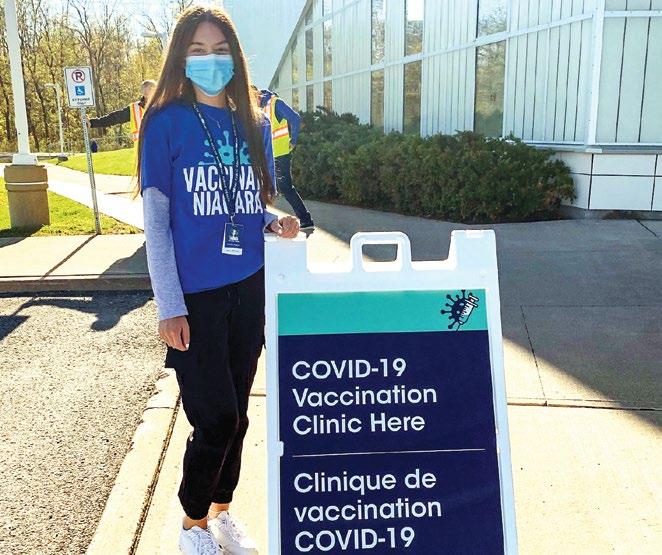
22 2021-22
Report COMMUNITY ENGAGEMENT
The businesses of Hayden Maass, left, and Adrian Belcastro, are part of the first cohort of six startups selected for the inaugural Brock LINCubator program.
Annual
Students launch exhibit with Niagara-on-the-
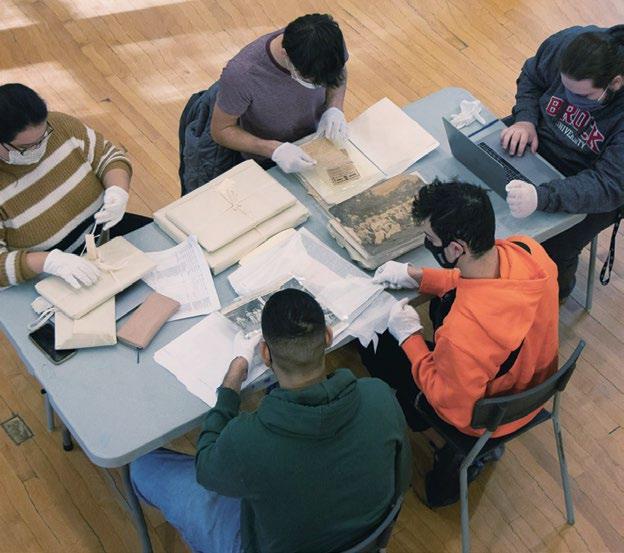
Lake
tiny museum
It’s a tiny museum, but a big history project. Students in Brock University’s HIST/CANA3F02 Making History in Niagara course worked with Niagara-on-the-Lake Museum to create a special exhibit on Niagara sport history for the Town’s mobile tiny museum. “(The students) had a lot of great ideas and questions, and their dedication and enthusiasm for history is evident with this class,” said Shawna Butts, Assistant Curator and Education Programmer at the museum. “It has been interesting to see them develop an understanding of what museums do and how we interpret and tell history for a public audience.” brocku.ca/brock-news/2021/11/students-launch-exhibit-with-niagara-onthe-lake-tiny-museum/
New seed library
Seeds on loan to community at Brock Library
The list of items you can borrow from the Brock University Library is growing. On April 19, 2022, the James A. Gibson Library opened the Brock University Seed Library to the community. The initiative, which allows people to “borrow” seeds for planting, was the brainchild of Brock Master of Sustainability candidates Alexandra Cotrufo and Madison Lepp. When the pair learned about WWFCanada’s Go Wild School Grants, they decided to apply in hopes of bringing their vision for a community seed library to life. The WWF-Canada Go Wild School Grant program funds projects that are focused on protecting or restoring nature in schools and on campuses. While most recipients receive grant amounts of $1,000, Cotrufo and Lepp were fortunate to receive $2,500 to plan, build and execute their project. A one-year trial collaboration between the Brock University Project Charter and the Brock University Library, the seed library will offer free seeds to community members to “borrow” and plant during the spring and summer seasons. The program functions like a library as participants are asked to later return a new batch of seeds from their gardens.
brocku.ca/brock-news/2022/04/seeds-on-loan-to-community-at-brock-library/
Students help WWF-Canada with fresh approaches to sharing water research
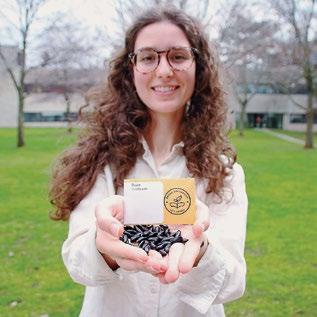

When students in Julia Baird’s Research Themes in Water Resources class undertook a project to collect and share current research about freshwater, they had three very different audiences to impress: Baird, a curious public and the World Wildlife Fund of Canada (WWF-Canada). Students used a stipend to finance innovative projects that could help a target audience understand different issues related to freshwater resilience. The final results, included social media pieces, high school lesson plans, short videos and ArcGIS StoryMaps. They learned about issues and gained crucial experience in the field.
brocku.ca/brock-news/2021/07/students-help-wwf-canada-withfresh-approaches-to-sharing-water-research/
23 2021-22 Annual Report COMMUNITY ENGAGEMENT
Brock grad making an impact in remote northern community
Through his own experiences, Mujib Ahmadiy (BPH ’17) has learned the difference education can make in the lives of others. When the opportunity presented itself, Ahmadiy, packed his bags and headed to where he felt he could have the greatest impact –in Canada’s north. In Sept. 2021 Ahmadiy began work as a secondary school teacher at Attagoyuk Illisavik in Pangnirtung, a small hamlet of nearly 1,500 people on Baffin Island in Nunavut. He is teaching two cohorts of 15 Grade 9 students, with a focus on health and math, while also coaching a soccer team. brocku.ca/brock-news/2021/11/brock-grad-making-an-impact-inremote-northern-community/

Armed Forces
Brock prof working to improve inclusivity in Canadian Armed Forces Nancy Taber, Professor in Brock’s Faculty of Education, is part of a research team that has received funding to provide insights into transforming the culture of the Canadian Armed Forces (CAF). She is one of three co-directors – along with Maya Eichler at Mount Saint Vincent University and Tammy George at York University – whose team has received $750,000 from Mobilizing Insights in Defence and Security (MINDS) to work over three years with the Department of National Defence and the CAF.
The aim is to provide insight on transforming CAF culture by focusing on root causes of discrimination, sexual misconduct and systemic racism.
brocku.ca/brock-news/2022/04/brock-profworking-to-improve-inclusivity-in-canadian-armedforces/
Virtual reality
Students invited to make waves online through work-integrated learning program

Brock University students – in their virtual form – have the chance to connect with leading employers across Canada through a new work-integrated learning partnership. Brock has teamed up with Wavemakers, a groundbreaking inclusive work-integrated learning program in virtual reality that is supported by the Government of Canada’s Innovative Work-Integrated Learning Program. Students who apply to and are accepted into Wavemakers have access to the program’s virtual campus, where they can connect with employers and students in real time and complete work-integrated learning projects.
brocku.ca/brock-news/2021/09/students-invitedto-make-waves-online-through-work-integratedlearning-program/
Health & business
Brock’s first MBA MPH grads ready to make a difference in public health Jacqueline Gates (left) and Beth Swenor are two of the first graduates of Brock University’s new Master of Business Administration and Master of Public Health concurrent degree program. When the first cohort of students entering Brock’s Master of Business Administration (MBA) and Master of Public Health (MPH) concurrent degree program started their studies in fall 2019, they had no idea that they would be graduating during the biggest public health crisis of their generation.
On Friday, Oct. 15, 2021 the first five students from the program that prepares grads to be public health administrators received their degrees during Brock’s Fall Convocation ceremony.
brocku.ca/brock-news/2021/10/brocks-first-mbamph-grads-ready-to-make-a-difference-in-publichealth/

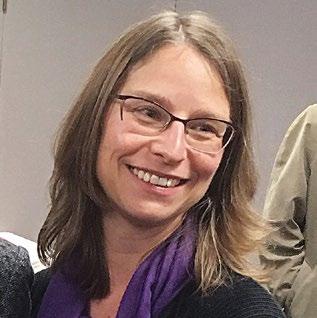
24 2021-22 Annual Report COMMUNITY ENGAGEMENT
Brock University graduate Mujib Ahmadiy (BPH ’17), a secondary school teacher at Attagoyuk Illisavik in Nunavut, took part in a community walk organized by the school to promote positivity and resilience.
CCOVI connects community and industry with new virtual opportunities

In a typical year, Brock University’s Cool Climate Oenology and Viticulture Institute (CCOVI) welcomes thousands of industry professionals and wine enthusiasts to its slate of in-person tastings, conferences, workshops and other special presentations. When the pandemic hit, however, CCOVI explored new ways of staying connected in a virtual capacity – and those efforts are paying off. CCOVI has engaged with more than 600 community and industry members though its new online initiatives. More than 100 guests attended CCOVI’s new virtual wine tastings and more than 400 people tuned in to watch the lectures live. brocku.ca/brock-news/2021/06/ccovi-connects-community-and-industrywith-new-virtual-opportunities/
Brock prof working to improve environmental stability of coastlines along Canada-U.S. border
Brock Biological Sciences Professor Liette Vasseur is part of a Great Lakes and St. Lawrence Cities Initiative called the Mayors Advisory Council on Coastal Resilience. The council was established to work with mayors of municipalities on the Great Lakes and St. Lawrence River on both sides of the Canada-U.S. border to develop recommendations on how to mitigate the considerable damage to their shorelines caused by erosion, flooding and other impacts, and adapt to increasing water level fluctuations and other extreme weather events. The council’s meetings provide a useful forum to both educate and spread awareness of issues that residents may not be aware are affecting their localities, Vasseur said.
brocku.ca/brock-news/2021/05/brock-prof-working-to-improveenvironmental-stability-of-coastlines-along-canada-u-s-border/
LCBO partners with Brock to advance equity in beverage alcohol industry
A mutual commitment to inclusion has fostered a strong partnership between the Liquor Control Board of Ontario (LCBO) and Brock University’s Goodman School of Business. On Oct. 12, 2021 the LCBO launched its Spirit of Inclusion initiative in response to the lack of equitable representation of women and diverse communities in the beverage alcohol industry. Partnering with the Goodman School of Business, the LCBO initiative will help create more opportunities for diverse women looking to enter, advance and thrive in the industry. “It is our responsibility to use our influence and resources to increase diverse representation and foster inclusion within the beverage alcohol industry,” said George Soleas, President and CEO, LCBO. brocku.ca/brock-news/2021/10/lcbo-partners-with-brock-to-advanceequity-in-beverage-alcohol-industry/
Brock Badgers’ donations provide boost to Community Care
The Brock Badgers raised more than 300 pounds of food and toy donations for Community Care of St. Catharines and Thorold in the last two months of 2021. The donations included a total of 200 pounds of food and 140 pounds of toys. The Badgers’ Community Care campaign was led by the StudentAthlete Leadership Council (SALC). “The first two events we ran as a council were extremely successful. It was extraordinary to be able to give back to a community who has always welcomed Brock in the Niagara region,” said SALC co-president Madeline Hingston, a fourth-year Kinesiology student. brocku.ca/brock-news/2022/01/brock-badgers-donations-provideboost-to-community-care/
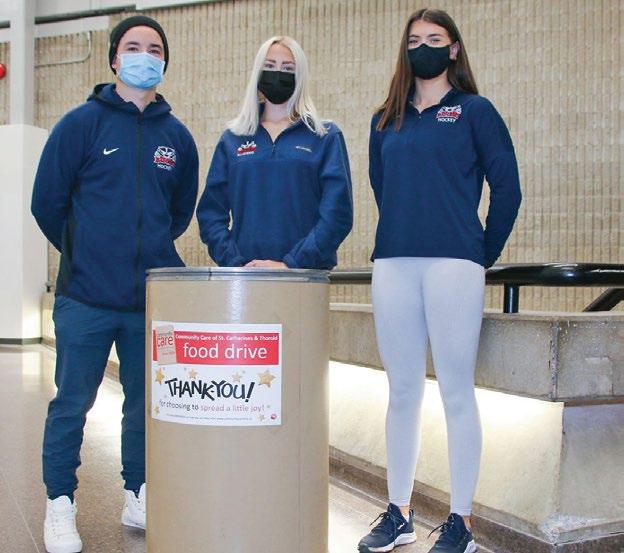
2021-22 Annual Report COMMUNITY ENGAGEMENT 25
Brock University’s Cool Climate Oenology and Viticulture Institute (CCOVI) has launched a new series of virtual tastings, including a recent event curated for Piller’s Fine Foods featuring Mitchell McCurdy (BSc ’18), Winemaker at Marynissen Estates Winery.
From left: SALC co-presidents Johnny Schaefer and Madeline Hingston, and co-vice president Bailey Brooks.
INCLUSIVITY
STRATEGIC PRIORITY: Foster a culture of inclusivity, accessibility, reconciliation and decolonization
At Brock, we believe that a diverse and welcoming learning community is built upon the foundation of exceptional students, faculty, staff and alumni. This requires that Brock be attractive and welcoming to people of all identities, and accepting of the unique histories and experiences of Indigenous people within the Canadian setting.
GOALS:
• Strengthen relationships of trust with Indigenous communities and partners across all sectors and activities of the University.
• Promote effective human resource practices and philosophies that improve inclusivity, accessibility, reconciliation and decolonization.
• Further celebrate the success of our faculty, staff, students and alumni
History made
Brock alumna elected first Black president of an Ontario teachers’ union

Toronto teacher and Brock alumna Karen Brown (BA ’91) made history when she was elected the first Black president of a teachers’ union in Ontario. Brown, who is also the first known Black president of a provincial teacher affiliate union in Canada, was named president of the Elementary Teachers’ Federation of Ontario during the organization’s annual meeting on Aug. 17, 2022. Brown has served as the ETFO’s vice-president since 2015 and was first elected to the provincial executive in 2009. She was recognized for her efforts in 2017 when she was named one of Canada’s 100 Most Accomplished Black Women. brocku.ca/brock-news/2021/08/brock-alumnaelected-first-black-president-of-an-ontarioteachers-union/
Olympics
Brock grad named to Canada’s Olympic bobsleigh team
It wasn’t too long ago that Niamh Haughey was running on Brock Alumni Field, making tackles as a women’s rugby team member, or skating at Seymour-Hannah Arena alongside her teammates on the Brock women’s hockey team. But today, she can be found putting her athletic prowess to the test halfway around the world. In a short time, Haughey (BPhEd’ 21) has made a rapid rise through the Bobsleigh Canada team and was named an alternate brakewoman for Team Canada at the Beijing Olympic Winter Games. Haughey credits her time with the Brock Badgers for helping to shape the athlete she is today. brocku.ca/brock-news/2022/01/brock-gradnamed-to-canadas-olympic-bobsleigh-team/

Support services
Brock’s student supports highlighted in recognition of National AccessAbility Week
Whether a student has a learning disability, mental health disorder or a physical, hearing or vision disability, Brock University offers supports and accommodations that remove barriers and promote a culture of inclusivity.
National AccessAbility Week, from May 30 to June 5, 2021, celebrated the valuable contributions of Canadians with disabilities and recognized the efforts of individuals, communities and organizations to eliminate barriers to accessibility and inclusion. One way in which Brock University is eliminating barriers is through the many support services offered through Student Accessibility Services (SAS).
brocku.ca/brock-news/2021/06/brocks-studentsupports-highlighted-in-recognition-of-nationalaccessability-week/
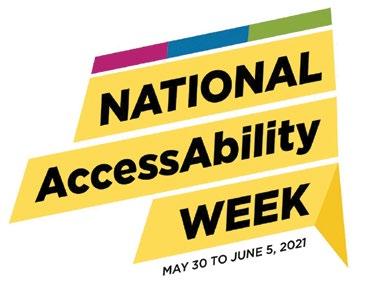
26 2021-22 Annual Report INCLUSIVITY
Brock grad raising awareness of trans identities through film
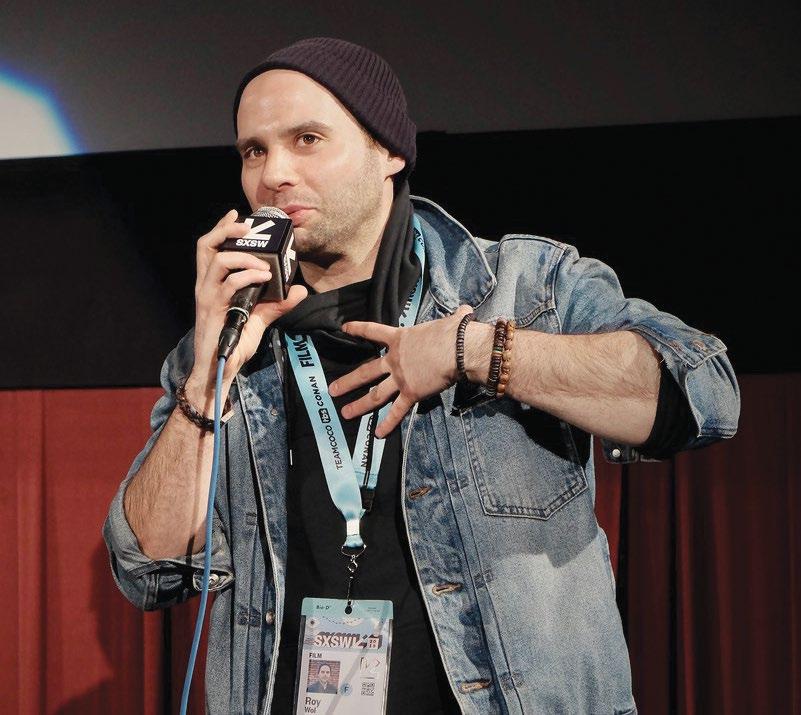
Brock alumnus and award-winning filmmaker Roy Wol (BA ’06) is starting important conversations about trans identities through his work. He brought that meaningful discussion virtually to the Brock community. In March 2021, Brock’s Pride Week kicked off with a special screening of Wol’s film, The Garden Left Behind. The 2019 release won the Audience Choice Award when it premiered at South by Southwest (SXSW) and has gone on to screen at more than 70 festivals and 50 community events. He notes that some 48 people from the trans community worked on the film, and more from the broader communities 2SLGBTQQIA+ rounded out the cast and crew. brocku.ca/brock-news/2021/05/brock-grad-raising-awareness-of-transidentities-through-film/
New teaching lodge to provide safe space for Indigenous ways of knowing A new structure on Brock University’s main campus is home to a variety of Indigenous teaching and learning opportunities. Thanks to a gift from the Niagara Peninsula Aboriginal Area Management Board (NPAAMB), a teaching lodge has been built in an open area behind Schmon Tower on the edge of the Niagara Escarpment. Similar to teaching lodges built by NPAAMB in two locations on the Six Nations of the Grand River Reserve and one at the Niagara Regional Native Centre, the lodge at Brock will be used for an array of activities, including Indigenous language teaching and a quiet space for healing. brocku.ca/brock-news/2021/06/new-teaching-lodge-to-provide-safespace-for-indigenous-ways-of-knowing/

Brock represented at Tokyo Summer Olympic and Paralympic Games
The 2020 Summer Olympic and Paralympic Games were postponed to summer 2021 due to the COVID-19 pandemic and are still commonly called Tokyo 2020. Four of Canada’s rowing contingent have roots in the Brock rowing program, including alumni Laura Court (BA’ 19), in photo, and Terry Paul (BPhEd’ 87) and former Badgers rower Luke Gadsdon and coach John Wetzstein. Court represented Canada at the Paralympic Games as coxswain for the mixed coxed four boat competing in the PR3 event, consisting of athletes with physical impairments and visual impairments or intellectual disabilities.
brocku.ca/brock-news/2021/07/brock-represented-at-tokyo-summerolympic-and-paralympic-games/

27 2021-22 Annual Report INCLUSIVITY
Online event focused on Indigenous women’s
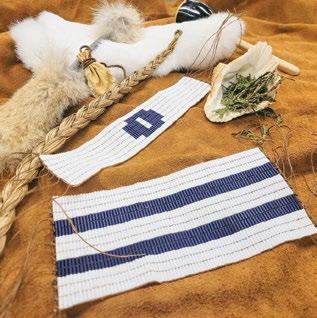
leadership

Understanding the critical role the leadership of Indigenous women has played in the survival of their communities was the focus of a free webinar in May, 2021. Robyn Bourgeois, Brock University’s Acting Vice-Provost, Indigenous Engagement, led the session as part of the Business Breathers series facilitated by Goodman Group, the Goodman School of Business’s community-focused learning and development services provider. The talk, titled “Warrior Women – Indigenous Women and Leadership,” helped participants learn why leadership is so important to Indigenous women and how it can offer invaluable lessons for non-Indigenous organizations.
brocku.ca/brock-news/2021/05/online-event-to-focus-on-indigenouswomens-leadership/

Education instructor part of inspirational Team Canada Olympic campaign
Faculty of Education instructor Lee Martin (BEd ’12) motivates children to reach their full potential and change the world around them on a daily basis. His work inside and outside the classroom caught the attention of the Canadian Olympic Committee (COC), and he was now featured as part of Team Canada’s Tokyo 2020 ‘Glory From Anywhere’ campaign. It showcased the achievements of both Canadian athletes and community heroes who achieve glory every day by inspiring others.“The campaign aims to showcase that everyone is capable of inspiring others to be their best,” said Martin. brocku.ca/brock-news/2021/08/education-instructor-part-ofinspirational-team-canada-olympic-campaign/
Indigenous languages
National Indigenous Languages Day a time to celebrate, educate
As Canada marked National Indigenous Languages Day on March 31, 2022, a Brock expert encouraged society to learn more about the importance of language preservation. Stanley Henry, Assistant Professor in Brock’s Faculty of Education, recommended people take time to celebrate the more than 70 Indigenous languages spoken across the country. He suggested learning more about efforts to preserve Canada’s Indigenous languages, including languages traditionally spoken locally, and the progress Indigenous people are making to reclaim their ancestral languages. Since 1993, National Indigenous Languages Day has been recognized as a way to honour the importance of Indigenous languages and promote their survival. Several of Canada’s Indigenous languages are endangered according to data from the 2016 census. The residential school system, in particular, eroded Indigenous languages by not allowing Indigenous children to speak in their mother tongues.
brocku.ca/brock-news/2022/03/national-indigenous-languages-day-atime-to-celebrate-educate/
28 2021-22 Annual Report INCLUSIVITY
Achievements
The Brock Badgers enjoyed the most successful sports season in University history during the 2021-22 season. In their first sports campaign since the COVID-19 pandemic cancelled the 2020-21 season, the Badgers roared out of the pandemic to capture seven championship titles in men’s rowing, men’s lacrosse, women’s volleyball, women’s hockey, men’s basketball and men’s and women’s wrestling.
“Athletics and recreation are an important part of the student experience, whether that be as a student-athlete or as a casual fan,” said Brock Interim President Lynn Wells. “We’re so incredibly proud of how all of our varsity student-athletes and teams have done this year and how they continue to represent Brock University so well. Go Badgers!”
The Badgers had 10 teams compete at national championships and 30 teams represented Brock at the provincial level. A total of eight coaches were named Coach of the Year across various sports while student-athletes secured seven major awards and 45 all-star honours.
Above, the Brock women’s hockey team poses by a 2022 sign while at the U SPORTS Women’s Hockey Championships in Charlottetown, PEI.
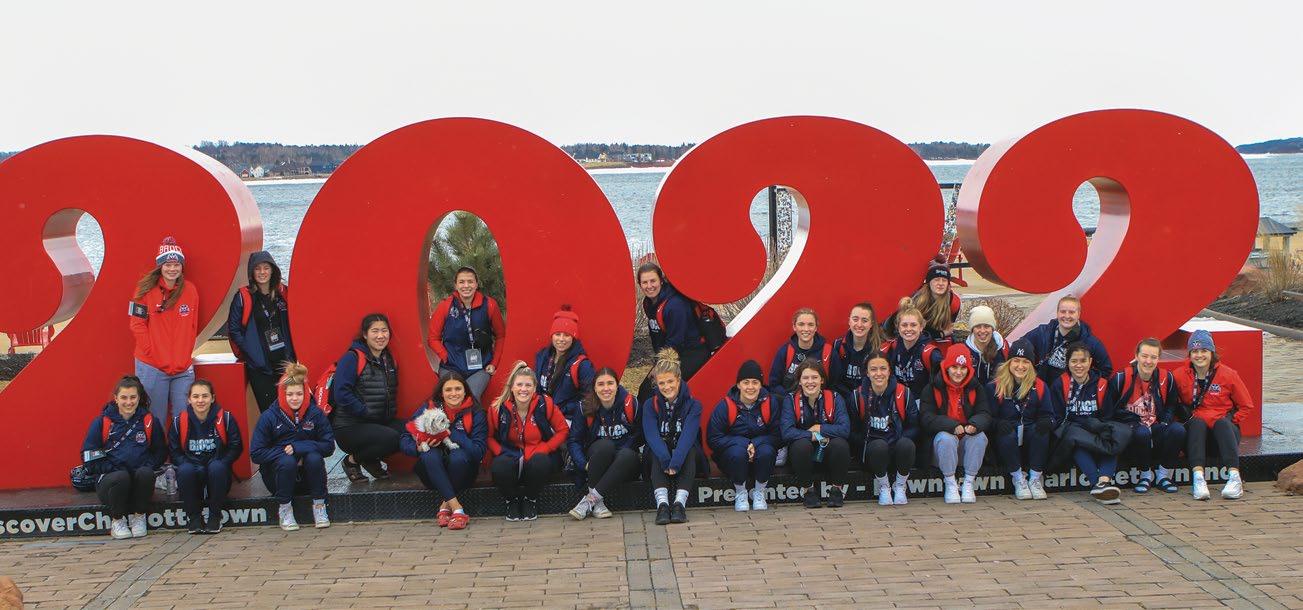
• Men’s Lacrosse – CUFLA national champions
• Men’s Rowing – OUA champions
• Women’s Volleyball – OUA champions
• Women’s Hockey – OUA champions
• Men’s Basketball – OUA champions
• Women’s Wrestling – OUA champions
• Men’s Wrestling – OUA champions
Other team medals
• Women’s Basketball – OUA silver
• Men’s Hockey – OUA silver
• Women’s Rowing – OUA team gold
• Men’s Fencing – OUA team gold
• Softball – OIWFA bronze
• Ringette – AA bronze
• Men’s Swimming – OUA individual bronze
• Women’s Fencing – OUA individual bronze
• Figure Skating – OUA individual bronze and silver
Coaches of the Year
• Tim Stang – Men’s Fencing (OUA)
• Marty Calder – Men’s Wrestling (OUA)
• Dave Collie – Women’s Wrestling (OUA)
• Mike Rao – Women’s Basketball (OUA)
• Willy Manigat – Men’s Basketball (OUA)
• Steve Delaney – Women’s Volleyball (OUA, U SPORTS)
• Tom Kent – Men’s Rowing (OUA)
• Vince Longboat – Men’s Lacrosse (CUFLA)
Other Major Awards
• Women’s Wrestling OUA Rookie of the Year – Mia Friesen
• Women’s Lacrosse OUA Rookie of the Year – Mia Friesen
Roger Li
• Women’s Basketball OUA West MVP –Samantha Keltos
• Men’s Basketball OUA West MVP – Tajinder Lall
• Men’s Volleyball OUA West MVP –Logan House
• Figure Skating – Spirit Award
U SPORTS First-Team AllCanadian
• Logan House (Men’s Volleyball)
• Tajinder Lall (Men’s Basketball)
Brock Sports Major Award Winners
• Female Athlete of the Year – Cassidy Maplethorpe (Women’s Hockey)
• Male Athlete of the Year – Stephen Harris (Men’s Rowing)
• Women’s Team Coach of the Year –Steve Delaney (Women’s Volleyball)
• Men’s Team Coach of the Year –Vince Longboat (Men’s Lacrosse)
• Female Team of the Year – Women’s Volleyball
• Male Team of the Year – Men’s Basketball
• David S. Howes Spirit of Brock Award –Emily Bonisteel (Women’s Fencing)
• David Atkinson Surgite Award – Emma Irwin (Women’s Hockey)
• RM Davis Surgite Award – Owen Guy (Men’s Hockey)
• Joseph P. Kenny Student Therapist Award –Joshua Celebre and Tyler Nancekivell
• BSP Student Intern of the Year –Alex Tousignant
• BSP Impact Award – Hana Parkin
• Marilou Iusi Memorial Service Award –Anna Lathrop
29 2021-22 Annual Report INCLUSIVITY
Brock women’s hockey clinches first provincial championship
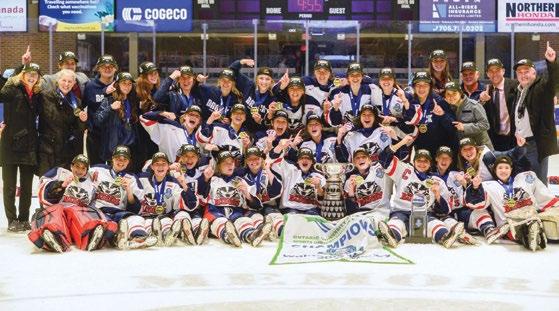
The Brock women’s hockey team captured their first provincial championship banner since the program began in 2000 on March 19, 2022. Brock edged the Nipissing Lakers 2-1 in North Bay to clinch the team’s first Ontario University Athletics (OUA) Women’s Hockey Championship. “We can’t stop smiling, crying and screaming. We are so proud of one another, because we promised we would do it for each other,” said senior defenceman Paige Cohoon. “If I had one word to describe this team, it’d be family. At the end of the day, it doesn’t matter the talent you have, what matters is the heart. This team’s heart is unstoppable.”
brocku.ca/brock-news/2022/03/brock-womens-hockey-clinches-firstprovincial-championship/
Brock teams qualify for national championships
What turned into an historic playoff run for the Brock Badgers continued in basketball courts and hockey arenas in Edmonton, Kingston and Wolfville, N.S. Brock University saw an unprecedented five teams qualify for their respective U SPORTS national championships this season. Three of the five won Ontario University Athletics (OUA) provincial titles, including the women’s hockey, women’s volleyball and men’s basketball teams. Men’s basketball won its first OUA title since 1992 on March 26, 2022 with a 95-75 win over Queen’s.
brocku.ca/brock-news/2022/03/three-more-national-championshipson-tap-for-brock-sports/
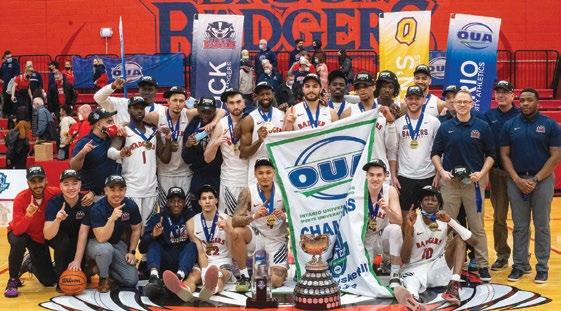
Sport Management grad, Badgers assistant hockey coach heading to WHL
A major junior hockey franchise in the Western Hockey League (WHL) has hired a Brock Sport Management grad who also served as an assistant coach with the Brock women’s hockey team. The Edmonton Oil Kings recently welcomed Josh Mallory (BSM ’19) as their new Video Coach and Hockey Operations Co-ordinator. While the new opportunity means a cross-country move for the Brock Sport Management alumnus and current master’s student, he plans to continue his studies with the University. Mallory wore many hats during his three seasons with the Brock women’s hockey team, including director of analytics, general manager and assistant coach. brocku.ca/brock-news/2021/08/sport-management-grad-badgers-assistanthockey-coach-heading-to-whl/
Brock Sports launches new StudentAthlete Leadership Council
Brock Sports is taking steps to ensure its studentathletes are heard. A new Student-Athlete Leadership Council (SALC) has been formed that will allow studentathletes to provide insight on the student-athlete experience to Brock’s athletics department. “It’s important for studentathletes to have a voice and the ability to make change. The council’s feedback will be a collaborative component of Brock Sports to help elevate our program,” said Melissa Kirst, Director, Brock Sports. “This core group of leaders will address the needs of more than 900 student-athletes, calls to action regarding social justice issues and how programs can thrive.” The council will provide feedback to Brock Sports on their policy creation and overall operations, which affect the lives of Brock student-athletes. A total of 35 studentathletes were named to the leadership council, including co-presidents Madeline Hingston of women’s rowing and Johnathon Schaefer of men’s hockey. Each member serves as the liaison between the council and their respective team. gobadgers.ca/news/2021/10/26/general-news-brock-sports-launches-newstudent-athlete-leadership-council.aspx?path=bh
The Brock Badgers men’s basketball team after winning the Ontario University Athletics title at Brock.
The Brock women’s hockey team captured its first OUA Championship in North Bay.
2021-22 Annual Report INCLUSIVITY 30
Brock Badgers capture first lacrosse title in 12 years
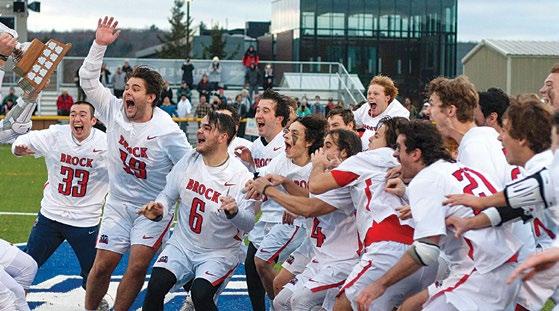
The Brock men’s lacrosse team captured its first Canadian University Field Lacrosse Association (CUFLA) championship in 12 years and the 19th title in school history on November 7, 2021. The Badgers narrowly defeated the Guelph Gryphons 10-9 in overtime during the championship game at Nipissing University in North Bay. “It’s surreal. I knew my guys had worked hard all year from the first tryouts to the last shot of the year,” said Head Coach Vince Longboat. “I believed in these men from the beginning. It’s the culmination of a goal we set from Day 1, and the goal was accomplished today.” brocku.ca/brock-news/2021/11/brock-badgers-capture-first-lacrosse-titlein-12-years/
Making history
Quigley crown: Brock women’s volleyball wins OUA title at home

For the first time in program history, the Brock Badgers women’s volleyball team holds the Ontario University Athletics (OUA) Women’s Volleyball Championship. The No. 2 Badgers defeated the No. 3 Toronto Varsity Blues 3-1 (25-15, 25-17, 17-25, 25-15) to capture the Quigley Cup at Bob Davis Gymnasium in St. Catharines on March 19, 2022. “This road hasn’t been easy. They say whatever doesn’t kill you makes you stronger, and I think that’s what’s happened to us,” said OUA West Coach of the Year Steve Delaney. brocku.ca/brock-news/2022/03/quigley-crownbrock-womens-volleyball-wins-oua-title-at-home/
Pro contract
Brock men’s volleyball grad signs pro contract
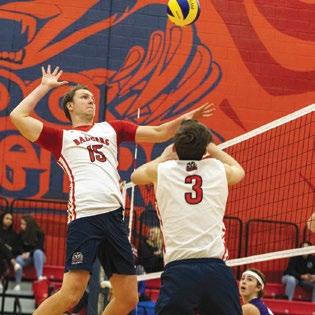
After years of hard work – both on and off the court – Peter Schnabel (BA ’21) saw a life goal become a reality when he became the first player out of the Brock Badgers men’s volleyball program to sign a pro contract. Two months after graduating from Brock with a degree in Psychology, Schnabel signed with Austria’s Raiffeisen Waldviertel in August, 2021. The opportunity is a dream come true, said Schnabel, a 6-foot-6 international student-athlete from Merzhausen, Germany. Schnabel racked up a total of 321 kills in three seasons while competing in Ontario University Athletics, where he was also named a Second Team All-Star for threeconsecutive seasons. brocku.ca/brock-news/2021/08/brock-mensvolleyball-grad-signs-pro-contract/
Mental health
Brock student-athlete hopes to help others by sharing her mental health struggles
After Madeline Hingston completed her seven-year-long rowing career as a Badger in November 2021, she encountered a body image hurdle. She is hoping by sharing her struggles with mental health that others will reach out for help. As co-president of Brock’s Student-Athlete Leadership Council (SALC), Hingston helped design a series of internal mental health and wellness events for varsity student-athletes during Bell Let’s Talk week. Alongside Alex Roger, Brock Sports’ Game Day and Events Assistant Co-ordinator, the SALC developed a five-day series that includes virtual yoga, online drop-in peer hubs and webinars presented by the University’s Student Wellness and Accessibility Centre. gobadgers.ca/news/2022/1/25/general-news-brockstudent-athlete-hopes-to-help-others-by-sharing-hermental-health-struggles.aspx
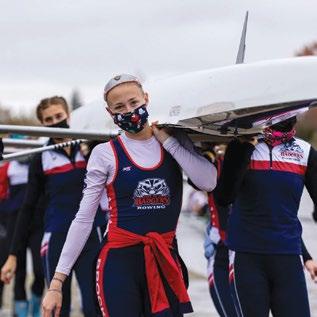
2021-22 Annual Report INCLUSIVITY 31
The Brock men’s lacrosse team celebrates winning the 2021 Baggataway Cup in North Bay.
INCLUSIVITY
ALUMNI
Alumni Recognition Awards
The Alumni Association takes great pride in recognizing the achievements of Brock alumni who have earned prominence as a result of their exceptional professional achievements and/or service to society. The recognition of accomplished alumni promotes the excellence of the University, its graduates and the Alumni Association.
Distinguished Alumni Award
The award honours one Brock University graduate each year who has earned prominence as a result of their exceptional professional achievements and/or service to society.
• Mike Pilato’s (BAcc ’98)
Outstanding Young Alumni Award
This award honours one young alumnus/a for their outstanding contributions early in their career.
• Brennor Jacobs (BA ’19)
Community Engagement Award
This award honours one alumnus/a who has set a high standard for community service and has made a significant contribution as a volunteer to their community.
• Mario De Divitiis (BA ’06, MA ’08)
Distinguished Faculty Graduate Award
This award was implemented to celebrate individual Faculty alumni who have earned prominence as a result of their exceptional professional achievements and/or service to society.
• Elisabeth Walker-Young (BPhEd ’02) – Faculty of Applied Health Sciences
• Chase Blodgett (BEd ’09, BPhEd ’09) – Faculty of Education
• Shawn Rubel (BA ’04) – Faculty of Humanities
• Johann (Hans) Matthews (BSc ’84) – Faculty of Mathematics and Science
• Angela Salvatore (BA ’02) – Faculty of Social Sciences
• Cheryl Brandon (BBA ’04) – Goodman School of Business
brocku.ca/brock-news/2021/10/brock-university-announces-2021distinguished-faculty-graduate-awards/

Two Brock grads set to lead Team Ontario at Niagara 2022
The Niagara 2022 Canada Summer Games will be a homecoming for Steve Sevor (BPhEd ’00, MEd ’04) and Jennifer Bennett (BPhEd ’00). Sevor, who is serving as the Chef de Mission for Team Ontario, and Bennett, Team Ontario’s Assistant Chef de Mission, both graduated from Brock University. “My passion and fuel for sport was ignited at Brock and I am so excited to return to where it all started,” said Sevor, whose day job sees him work as the manager for the City of Hamilton’s Sport Services. Bennett, a professor in the Sport Management and Sport Business Management programs at Humber College, also has fond memories of her time at Brock. brocku.ca/brock-news/2021/12/two-brock-grads-set-to-lead-team-ontario-atniagara-2022/
Powerful alumni
Brock alumni, board member named on list of Canada’s Most Powerful Women
Deborah Rosati, above, is one of two Brock University alumnae and three people with Brock connections named to the 2021 Canada’s Most Powerful Women: Top 100 Award winners list. Selected by the Women’s Executive Network (WXN) the 2021 cohort was celebrated at a virtual two-day leadership summit and awards gala Nov. 24 to 25, 2022. On the list are Brock alumnae Deborah Rosati (BAdmin ’84) and Nicolle Butcher (BBA ’92), along with Brock Board of Trustees member Stephanie Thompson. There are recipients in 13 categories representing the country’s private, public and not-for-profit sectors. Rosati is the Founder and Chief Executive Officer of Women Get On Board Inc. and was selected in the BMO Entrepreneurs category. Butcher, Senior Vice-President, Renewable Generation and Power Markets for Ontario Power Generation, was selected in the CIBC Executive Leaders category. Thompson, Engineering Team Leader for General Motors of Canada and CEO of STEM by Steph, was selected in the CP Skilled Trades category. brocku.ca/brock-news/2021/11/brock-alumni-board-member-named-onlist-of-canadas-most-powerful-women/
32
2021-22
Report
Annual
Outstanding
Young Alumni Award
recipient honoured Brennor Jacobs (BA ’19) of the Oneida Turtle Clan is the 2021 recipient of Brock University’s Outstanding Young Alumni Award. Jacobs first became involved with creating adult literacy programming and materials for Indigenous learners while he was studying at Brock. After graduating, Jacobs created a 437-page book titled Akhwatsirehko:wa My Big Family that explores how lacrosse has impacted people emotionally, intellectually and spiritually. The book won the Mind, Body and Spirit category of the 2021 Next Generation Indie Book Awards – the largest international awards program for independent authors and publishers. brocku.ca/brock-news/2021/12/outstanding-young-alumni-awardrecipient-honoured-for-impact-on-indigenous-communities/
Brock graduate Mario De Divitiis honoured for dedication to community

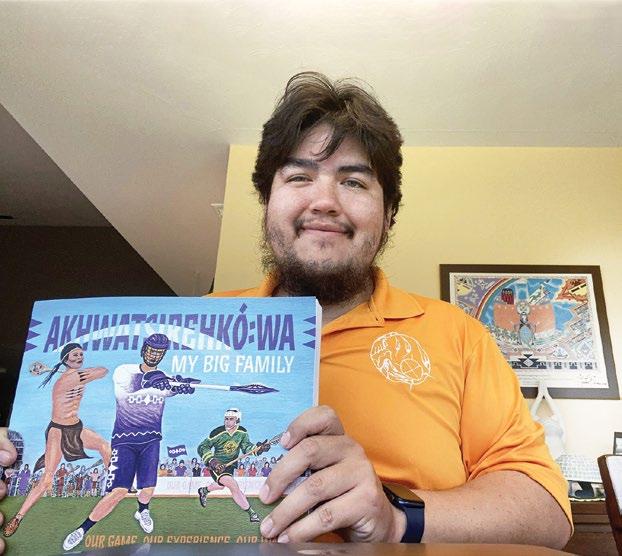
As one of nine siblings, Mario De Divitiis (BA ’06, MA ’08) grew up with a selfless attitude and a sense of community. His mother has spent the past five decades volunteering with many local organizations, and his father was an entrepreneur who was closely connected to and driven by local initiatives. So it’s no wonder De Divitiis developed a passion for helping others and has dedicated his personal and professional life to making a positive impact. In recognition of his significant contributions, the Brock University Political Science graduate is the 2021 recipient of the Brock University Alumni Association Award for Community Engagement. brocku.ca/brock-news/2021/12/brock-graduate-mario-de-divitiishonoured-for-dedication-to-community/
Brock grad lands $500,000 deal on CBC’s Dragons’ Den
After receiving a $500,000 boost on CBC’s Dragons’ Den, Tefari Bailey (BA ’19) is using the funds to help change the future of banking. The Brock University graduate recently appeared on the hit Canadian TV show to pitch Hutsy, an online-only financial technology company. After a successful pitch to the Dragons’ Den celebrity investors, Hutsy’s concept piqued the interest of ‘Dragon’ Wes Hall, who provided Bailey with $500,000 to invest in venture capital funding for the business. Co-founded by Bailey in 2019, Hutsy is a neo-bank, which has no physical branches and offers a simple and convenient way to use money. brocku.ca/brock-news/2022/02/brock-grad-lands-500000-deal-oncbcs-dragons-den/

2021-22 Annual Report INCLUSIVITY 33
Brock student excellence
Brock Leaders Citizenship Award
Brock Leaders Citizenship Awards recognize a combination of high academic achievement and personal leadership abilities. The students listed below have demonstrated excellence in fine arts, writing, debating, science, extracurricular activities and/ or significant citizenship contributions to the community.
• Malak Matus – Applied Health Sciences
• Madeline Grimes – Humanities
• Valerie Beck Slatter – Humanities
• Abigail Fuller – Humanities
• Marena Schneider – Goodman School of Business
• Alexander Deangelis – Applied Health Sciences
• Megan Sardella – Mathematics and Science
• Arlette Mamo – Humanities
• Andrea Dekorte – Goodman School of Business
• Gabriel Piessens – Humanities
• Lauren Gallant – Social Sciences
• Michaela Rankin – Applied Health Sciences
• Rebecca White – Applied Health Sciences
• Brooke Lavery – Social Sciences
34
• Parker Triano – Applied Health Sciences
President’s Surgite Award
The President’s Surgite Award recognizes those students who have been outstanding in one or more of the following areas: demonstrated exemplary leadership in a student club, organization, association or team; did something exceptional that helped to advance Brock’s academic reputation; made a significant contribution to student life at Brock; or provided a valuable service to Brock or the broader community.
• Silvana Nguyen – Mathematics and Science
• Kian Rego – Applied Health Sciences
• Brielle Kaminsky – Education
• Noah James – Applied Health Sciences
• Sarah Smith – Applied Health Sciences
• Temi Odunuga – Applied Health Sciences
• Ben Johnson – Social Sciences
• Owen Angus-Yamada – Goodman School of Business
• Francesco Amodio – Social Sciences
• Haley Myatt – Social Sciences
Aboriginal Achievement Awards
The Aboriginal Achievement Awards are presented by Brock’s Student Success Centre and Aboriginal Student Services to honour high-level achievers in their studies and off-campus lives.
• Cassandra Carlson – Mathematics and Science
Board of Trustees Spirit of Brock Medal
The Brock University Board of Trustees provides a medal for graduating students who best exemplify Sir Isaac Brock’s spirit with one or more of the following qualities: leadership, courage, innovation, inspiration and community involvement.
• Felisia Milana – Social Sciences
• Donna Brewitt Whetstone – Education
• Natalie Hamel – Applied Health Sciences
• Kirsten Bott – Applied Health Sciences
• Yarnie Shahparast – Goodman School of Business
• Owen Angus-Yamada – Goodman School of Business
• Josh Kelly – Education
• William Ankomah – Education
• Kellian Gordon – Humanities
• Madeleine Maheu – Mathematics and Science
• Aisha Kassymbek – Mathematics and Science
• Ben Johnson – Social Sciences
• Caitlyn Gallant – Social Sciences
Governor General’s Medals
The Governor General’s Medals recognize excellence in academic studies. The gold medal is presented to the student with the highest overall average in a graduate program. The silver medals are awarded to the students completing their first four-year bachelor’s degree with the highest and second highest cumulative averages.
• Gold – Elizabeth Todd – Social Sciences
• Silver – Connor Wilson – Mathematics and Science
• Silver – Bryn Crandles – Mathematics and Science Co-op
and Experiential Education Awards
Co-op Students of the Year Awards recognize excellence in job performance, academic achievements and extra-curricular involvement, based on a student’s contributions to their co-op employers, co-op education at Brock and the community at large.
• Yarnie Shahparast – Honours Bachelor of Accounting Co-op
• Ishan Kohli – Honours Bachelor of Business Administration Co-op
• Justin Dilgert – Honours Bachelor of Business Administration Co-op
The Experiential Education Student of the Year Awards recognize students’ achievements in all facets of experiential learning.
Individual winner: Noah James – Applied Health Sciences Group winners:
• Kiara Kalenuik – Applied Health Sciences
• Ryanne Logan – Mathematics and Science
• Tory Shklanka – Applied Health Sciences
• Kian Rego – Applied Health Sciences
• Kahlan Woodhouse – Applied Health Sciences
34 2021-22 Annual Report INCLUSIVITY
Teaching awards
Teaching Awards 2021-22
Brock University Distinguished Teaching Award

This award is presented annually to a faculty member who, in the opinion of their peers, has made an outstanding contribution to the teaching and learning environment at Brock University.
Leanne Taylor, Faculty of Education: Taylor’s Teaching Philosophy is guided by Milner’s principle: ‘Start Where You Are – But Don’t Stay There’. Her approach is grounded in a desire to inspire change, build critical capacity, and generate knowledge that will grow and continue long after students leave her course. By emphasizing the process of ‘unlearning’, she employs daily equity habit-building activities and multimedia methods to move into the ‘messiness’, generate questions, and nudge students past their comfort zones toward their ‘learning edge’.
Faculty Awards for Excellence in Teaching
GOODMAN SCHOOL OF BUSINESS
Skander Lazrak, Finance, Operations, and Information Systems: Lazrak teaches corporate finance, financial theory, financial analysis and empirical finance. Lazrak researches asset pricing, and corporate, international and empirical finance.
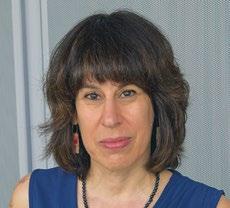

FACULTY OF MATHEMATICS AND SCIENCE
Costa Metallinos, Chemistry: Metallinos has been a perennially excellent instructor in the Department of Chemistry since 2003. Metallions’ teaching strategies produce a high level of class engagement and participation and allow new material to be covered at a pace that students can absorb.

FACULTY OF APPLIED HEALTH SCIENCES
Rebecca MacPherson, Health Sciences: MacPherson teaches Human Anatomy, Human Pathology and Pathophysiology of the Metabolic Syndrome. MacPherson’s research program strives to understand the relationship between disturbances in cellular homeostasis and metabolic diseases
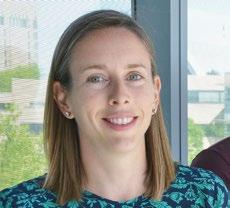

FACULTY OF EDUCATION
Joe Barrett, Educational Studies: Barrett teaches a number of elementary and secondary B.Ed. courses focused upon physical and health education curriculum and instruction as well as graduate M.Ed. courses focused upon physical and health education policy and curricula.

FACULTY OF HUMANITIES
Rob Alexander, English: Alexander has taught courses in rhetoric, literature, journalism, professional writing, creative writing, social justice, ecocriticism and the history of linguistic thought. Alexander has helped develop Brock’s Rhetoric and Professional Writing and Creative Writing programs.
FACULTY OF SOCIAL SCIENCES
Shauna Pomerantz, Child and Youth Studies: Pomerantz has taught on topics such as popular cultures of children and youth, sociology of childhood, and sociocultural theories. Pomerantz engages students through down-to-earth language and conversation, first-person experiences, and connections to music, shows, film, history, and current events to demonstrate theory in action.
2021-22 Annual Report INCLUSIVITY 35
Leanne Taylor, Associate Professor, Department of Educational Studies
Skander Lazrak, Professor, Finance, Operations and Information Systems
Costa Metallinos, Professor, Chemistry
Rebecca MacPherson, Associate Professor, Health Sciences
Rob Alexander, Associate Professor, English Language and Literature
Shauna Pomerantz, Associate Professor, Child and Youth Studies
Joe Barrett, Associate Professor, Educational Studies
Brock University Award for Excellence in Teaching for Early Career Faculty
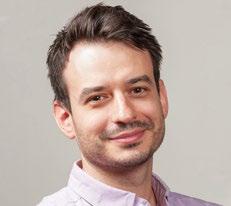
This award recognizes the contributions to teaching undertaken by a new faculty member who is in the first five years of a tenure-track position.
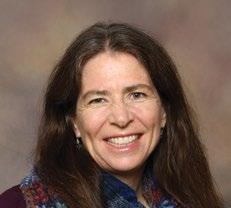
Valerie Michaelson, Health Sciences: “Passion and compassion.” This is how Michaelson’s teaching is described by her students, colleagues and the community. Her depth of commitment and activities related to teaching and learning at Brock are exemplary and demonstrate a true passion for education and inspiring change.
Clarke Thomson Award for Excellence in Sessional Teaching
This award recognizes the contributions of a part-time/sessional teaching staff member who contributes significantly to student learning at Brock University.
Kate Cassidy, Communications, Pop Culture, and Film: Cassidy is described as a scholar and an instructor who has given a great deal of attention to supporting, stretching and promoting memorable learning experiences. Students and alumni consistently remark at the attention and support they have received from Cassidy as they explore and embark upon their careers.
Don Ursino Award for Excellence in the Teaching of Large Classes
Martin Dragan, Health Sciences: As the instructor of the Introduction to Health Sciences Course and Senior Lab Demonstrator of the Human Systems Anatomy course, thousands of students have the pleasure of learning from Martin early in their academic careers each year. Martin’s passion and commitment for making learning personal, interactive and engaging makes these classes less intimidating and enjoyable.
Teaching Assistant Awards 2021-22 TA Award
Bruna Fernandes, Department of Nursing: Fernandes has demonstrated a commitment to the feedback process and professional learning. For Fernandes, “Teaching is a great responsibility and I take it seriously.”


Shawna Hopper, Health Sciences: Hopper has worked to create a teaching and learning environment that is supportive, productive, challenging and welcoming. For Hopper, building such an environment acknowledges “learning is a lifelong process.”
Graduate TA Award
Megan Magier, Health Sciences: Magier demonstrates a commitment to creating an equitable and accessible teaching and learning environment for her students. She wants her students to know they are in a safe, equitable space where they are respected and can thrive.


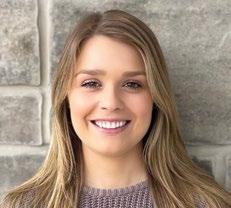
Novice TA Award
Sara McCowell, Department of Educational Studies: McCowell has demonstrated a strong commitment to her students in her practice and through her professional development. She strives “to establish a positive rapport with my students to create a safe and supportive classroom to support their learning needs.”
Valerie Michaelson, Associate Professor, Health Sciences
Kate Cassidy, Communications, Pop Culture, and Film
Martin Dragan, Health Sciences
Bruna Fernandes, Department of Nursing
Shawna Hopper, Health Sciences
36 2021-22 Annual Report INCLUSIVITY
Megan Magier, Health Sciences
Sara McCowell, Department of Educational Studies
Graduate Studies awards
Marilyn Rose Graduate Leadership Award
Recognizes individuals for their vision and leadership on behalf of Graduate Studies at Brock in areas such as academic programming, research and scholarship, student services, and student experience initiatives – the kind of work through which a strong and vital graduate culture has emerged in support of graduate students and in support of the University’s academic and research goals.
• Emily Bagshaw, Student, Master of Arts, Social Justice and Equity Studies
Michael Plyley Graduate Mentorship Award
Nominations come from graduate students as an opportunity for them to pay tribute to an individual graduate faculty member who has provided them with outstanding support and encouragement in their development as a graduate researcher.
• Melanie Pilkington, Professor, Chemistry
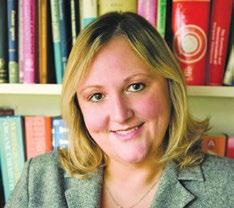

• Sheila O’Keefe-McCarthy, Associate Professor, Nursing
Jack M. Miller Excellence in Research Awards
These awards recognize graduate students who have presented projects that are highly original and are addressing significant questions.
Faculty of Applied Health Sciences:
• Josh Celebre, MA, Applied Health Sciences
• Phillip Wallace, PhD, Applied Health Sciences
Faculty of Mathematics and Science:
• Adel Hadjiesmaeili, MSc, Management
• Alina Baradzenka, PhD, Chemistry
Faculty of Education:
• Sreedevi Rajasekharan, MEd, Education
• Rakha Zabin, PhD, Educational Studies
Faculty of Humanities:
• Shakeel Ahmed, MA, Classics
• Brett Robinson, PhD, Interdisciplinary Humanities
Faculty of Social Sciences:
• Sarah Bernier, MA, Applied Disability Studies
• Brianna Anderson, PhD, Child and Youth Studies
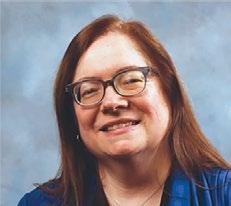
37 2021-22 Annual Report INCLUSIVITY
Emily Bagshaw, Student, Master of Arts, Social Justice and Equity Studies
Melanie Pilkington, Professor, Chemistry
Sheila O’Keefe-McCarthy, Associate Professor, Nursing
Canada Research Chairs (CRC) at Brock, April 2022
TIER 1
Andrea Doucet – CRC in Gender, Work, Care and Community
Vincenzo DeLuca – CRC in Organic Synthesis and Biocatalysis
Newman Sze – CRC in Mechanisms of Health and Disease
TIER 2
Julia Baird – CRC in Human Dimensions of Water Resources and Water Resilience

Karen Campbell – CRC in Cognitive Neuroscience of Aging
Paula Duarte-Guterman – CRC in Behavioural Neuroscience
Val Fajardo – CRC in Tissue Remodelling and Plasticity Throughout the Lifespan
Michael Holmes – CRC in Neuromuscular Mechanics and Ergonomics
Matthew Kwan – CRC in Youth Mental Health and Performance
Danielle Sirianni Molnar – CRC in Adjustment and Well-Being in Children and Youth
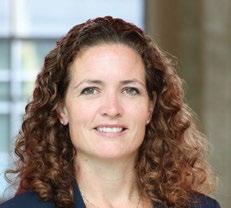
Research awards and Canada Research Chairs (CRC)
Chancellor’s Chair for Research Excellence
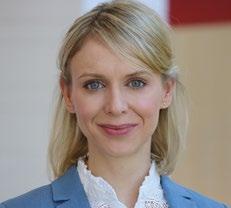
Dawn Trussell, Sport Management: Trussell’s recent work focusses on allyship, which involves those in positions of privilege and power working in solidarity with marginalized groups to dismantle systems of oppression that often exclude participants based on race, gender, sexual orientation and other social identities. brocku.ca/brock-news/2021/09/sport-management-prof-awarded-chancellors-chair-for-research-excellence/
Distinguished Research and Creative Activity Award
Andrea Doucet, Canada Research Chair, Sociology, Women’s and Gender Studies: Doucet’s research centres on care – as everyday practices, unpaid work, policies, and as part of knowledge-making processes. She leads a SSHRC Partnership research program on care/work policies and family stories, with a focus on how childcare services, parental leave and employment policies are experienced by diverse Canadian families.
Early Career Research and Creative Activity Award
Karen Patte, Health Sciences: Patte focuses on predictors of youth mental health with the goal to inform more effective and equitable policies and programs. She leads national research projects and collaborates across disciplines to advance understanding of how different contexts, exposures and individual factors interact to shape health trajectories over time.
Remembering Professor and Canada Research Chair Tomáš Hudlický
Longtime Professor of Chemistry and Canada Research Chair Tomáš Hudlický, who passed away in May 2022, specialized in synthesizing natural compounds used in drugs to fight cancer. One breakthrough was Hudlický’s creation of variations of the synthetic compound pancratistatin (PST), which he patented. In 2017, a team of scientists tested out these variations on 20 different types of cancer cells. The results showed that Hudlický’s compound appears to be capable of killing cancer cells while leaving healthy cells intact. He won many awards during his distinguished career. brocku.ca/brock-news/2022/05/remembering-professor-tomas-hudlicky/

Canada Research Chairs
The Canada Research Chairs (CRC) Program was created by the federal government to attract and retain top researchers. Tier 1 and Tier 2 CRCs are nominated by universities but must also be confirmed by their peers as being exceptional researchers and potential leaders – even world leaders – in their field. In January 2022, it was announced that Brock gained four new CRCs: Paula Duarte-Guterman; Matthew Kwan; Danielle Sirianni Molnar; and Newman Sze. In addition, Michael Holmes had his CRC renewed. Brock University has a total allocation of 14 CRC positions. brocku.ca/brock-news/2022/01/brock-university-gains-four-new-canada-research-chairs-one-renewal/
38 2021-22 Annual Report INCLUSIVITY
Dawn Trussell, Associate Professor, Sport Management
Karen Patte, Associate Professor, Health Sciences
Andrea Doucet, Professor, Sociology and Women’s and Gender Studies
Excellence in staff
President’s Distinguished Staff Award for Outstanding Contributions
The President’s Distinguished Staff Service Award for Outstanding Contributions recognizes employees who have excelled in demonstrating exemplary service and have provided outstanding contributions to the working environment and culture at Brock at a level significantly beyond normal expectations. The 2021 winners were:
• Tanya Bradley, Student Life and Success
• Pauline Dawson, Career Education
• Tracey Naldjieff, Office of Research Services
• Pete Sawatsky, Facilities Management
Human Resources Distinguished Staff Service Award for Leadership
The Human Resources Distinguished Service Award for Leadership is awarded to one staff member each year who has demonstrated a proven record of leading and working collaboratively, engaging fellow employees, building strong partnerships, and furthering the development of a respectful work and learning environment. The 2021 winner was:
• George Bench, Manager, Emergency Management and Life Safety
Outstanding Team Service Award
A new employee service award celebrating the power of teamwork was created by the Office of the President and Vice-Chancellor. This award will annually recognize a team of faculty and/or staff members for their outstanding
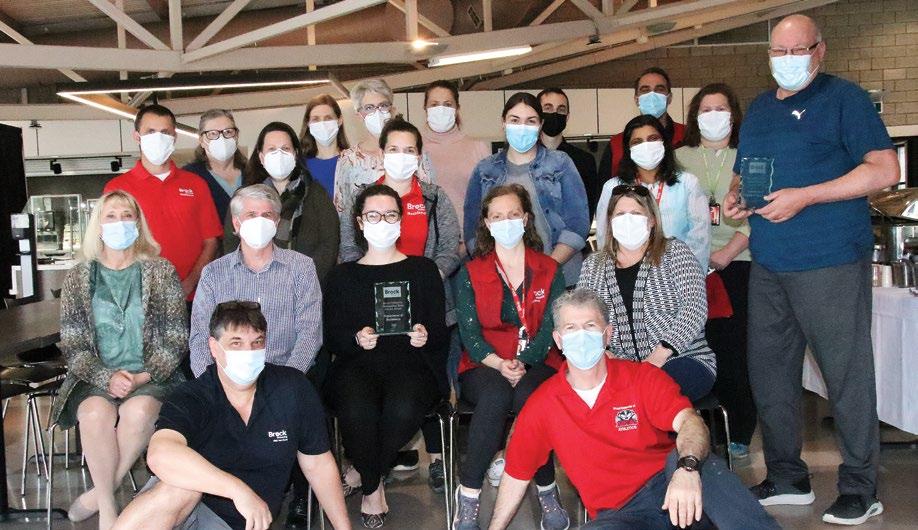
contributions throughout the year beyond what is normally expected. Although this award is for one team, this first year of the award was presented to two teams:
• Central Receiving and Mail Services
• Residences
Years of Service
Brock University celebrates employees who have reached significant service milestones in their careers. Employees who reached these milestones in 2021 were:
35
YEARS OF SERVICE TO BROCK
• Michelle Allard, Operations Co-ordinator, Client Services, Information Technology Services
• Leah Bradshaw, Professor, Political Science
• Richard Cheel, Professor, Earth Sciences
• Catherine Foreman, Manager, Library Collections
• Gary McDonnell, Assistant Supervisor, Electronics, Math and Science
• Fatima Noorbhai, Executive Assistant to the Dean, Social Sciences
• Robert Rattew, Horticultural Technician and Lead Hand, Facilities Management
• Evelyn Smith, Help Desk Co-ordinator/Data Research Assistant, Library Access Services
• Sharon Smith, Circulation Clerk, Instructional Resource Centre
• Clara Suba, Information Tech Support, Centre for Digital Humanities brocku.ca/brock-news/2022/04/brock-employees-celebrated-for-outstandingcontributions-long-standing-service/
At a celebratory luncheon Interim President Lynn Wells (seated far left) presented the 2021 Brock University Outstanding Team Service Awards to the Department of Residences and Central Receiving and Mail Services teams. The recipients of the inaugural award, as well as several other staff service awards, were announced at a livestreamed event.
THANK YOU
for your many years of contribution and for continuing to make Brock a great place to work!
Pullout 2i
Donor engagement
Giving at a glance – cash received ($millions)
Brock Alumnus and Retired Professor Boosts Engineering Education at Brock
Yousef Haj-Ahmad (BSc ’80, MSc ’82) has been investing in the future of Brock University’s students and programming since 1989.
After completing two degrees from Brock, Haj-Ahmad became a Professor of Biological Sciences at the University in 1989, where he taught students for 24 years before retirement. During his time at Brock, Haj-Ahmad also founded Norgen Biotek Corp in 1998, a slow but steadily growing company advancing the field of biotechnology research and testing, which he continued after retirement from the University.
His dedication to Brock and its students has also continued with a scholarship that provides financial support for students studying Biotechnology and Biological Sciences at the University. Additionally, Norgen Biotek Corp continuously welcomes Brock coop students and graduates, often giving them their first chance at industry work, through the lab.
Where do gifts make an impact – proportion of 2021-22 cash donations (%)
Now, Haj-Ahmad is looking to make an impact on Brock students that extends well beyond the four walls of a classroom or lab. Supported by a transformational $5-million gift from The Yousef Haj-Ahmad Family Foundation, Brock has announced the Yousef HajAhmad Department of Engineering. The department will place Brock as a competitor worldwide, offering students, faculty and the broader Niagara community new possibilities for teaching, learning and research.
Another important part of the gift to the University is the establishment of the Haj-Ahmad Engineering Scholarship for Women, which will support female students pursuing STEM (science, technology, engineering and math) education each year, paving the way for generations of skilled female engineers.
The generous commitment from Haj-Ahmad and his family is the result of their lifelong collective connection to Brock, and their belief that their alma mater can play a major role in an emerging sector.
brocku.ca/brock-news/2022/02/niagara-familys-transformative-5m-giftboosts-brock-engineering/
Pullout 2ii
38.0 6.2 55.8
20.2 2.7 54.7 11.4 4.3 6.7 2021-22 2020-21 2019-20 2018-19 2017-18 5.11 13.59 4.96 7.32 5.66 Giving
– cash
Alumni Faculty and staff Other donors*
Student awards Student supports Athletics Capital Research Other
at a glance
received ($millions) Figure 31
Supporters – proportion of 2021-22 cash donations (%)
Note: Figures provided by Development and Donor Relations. Figures will differ from the Financial Statements as they represent cash collected, not revenue recognized. The figures will also differ from those reported in Figure 26 of this report due to the source of the donation. For example, these figures also include donations to be directly provided to specific students.
*Other donors may include the following constituencies: friends, honorary Doctorate recipients, parents, students, club/organizations, companies or foundations.
Brock Badgers’ unforgettable season backed by crucial community support
Backing the Badgers on their most successful sport season in history were several partners and donors who ensured Brock’s student-athletes had the necessary facilities and financial support to excel.
With more than 900 athletes gearing up for the 202122 season, support from the Brock community allowed our Badgers to focus on getting back in the game. With the last two sports seasons cancelled due to the COVID-19 pandemic, it was more important than ever that athletes worried less about financial stressors and were able to show up undistracted and give each game their all.
And that they did. The Brock Badgers ended the 2021-22 season after capturing one national and six provincial championship titles. While these titles are the strongest testament to the dedication, hard work and training of our student-athletes, they are also a testament to Brock’s increased support and opportunities for our Badgers, made possible by generous donors.
Our student-athletes represent our University and showcase their Badger pride both on and off the court, so we look to support them and set them up for success in as many ways as possible.
This year, we saw an increase in the number of individual and organizational donors who wanted to step up to create additional student awards for our athletes. Brock donors truly understand the importance athletics and recreation has on the student experience and the joy their return would bring to our students.
For athletes, having tuition and other expenses supplemented meant they could spend their time outside of their studies on the field, court and/or ice.
Collectively, the Brock community believes this year was only the start of a strong comeback for Badgers sports. Likewise, the vital support from our community will continue to have an impact on our athletes for years to come.
brocku.ca/brock-news/2022/03/unforgettable-sports-season-playingout-for-brock-badgers/
TD support improves well-being and advances Brock programming for Seniors in Niagara
As a long-time supporter of Brock University and the Niagara region, TD Bank Group (TD) responded to the increased need of both physical and sociological support for seniors in our community. Through a multi-year grant, TD has invested in Brock’s SeniorFit program, offered by the Brock-Niagara Centre for Health and Well-Being.
Designed for Niagara residents 55 and older, SeniorFit works to enhance the quality of life across the lifespan by promoting and supporting a healthy lifestyle; focusing on exercise to improve strength, mobility and independence, while also enhancing confidence and self-esteem. Operating the program and working directly with seniors are Brock students from Kinesiology, Health Sciences, Therapeutic Recreation, Nursing and Gerontology programs.
As expected as we emerged from the pandemic, the unique SeniorFit program has increased in popularity, with more seniors needing or wanting assistance, programming and social interaction. The grant from TD will help the Brock-Niagara Centre both assess and expand the program to better serve seniors in the region.
In addition to enabling further assessment and research for the program, the grant allows the Centre to expand its SeniorFit program across the region using satellite locations. By bringing programming where the people are, we remove barriers to accessibility for seniors and thus expand awareness and opportunity for seniors to work to reduce the occurrences and severity of chronic conditions and illnesses.
brocku.ca/brock-news/2022/01/brock-td-working-together-to-improvephysical-and-mental-well-being-of-niagara-seniors/
TEXT
Pullout 2iii
iii 2021-22 Annual Report
TEXT
2021 TO 2022
It is exciting to review some of the accomplishments of the past year and showcase what the budget supports. This timeline represents a reflection of excellence in people, their accomplishments and other significant events at Brock – it exemplifies what makes Brock great. Many of the stories are taken from the Brock News as well as from a University-wide call. We encourage anyone who has a story they think would be relevant for next year’s timeline to submit it to annualreport@brocku.ca. In addition to the events described in the timeline, many of the ongoing awards received by students, alumni, faculty and staff, as well as Brock Sports achievements, student experiences, research accomplishments, community engagement events and Alumni successes, are highlighted in this report.
Third-year Medical Sciences student
Holly Bihun was one of the co-leads for the virtual Ability Empowerment Days event on May 11 and 12.
brocku.ca/brock-news/2021/05/event-encourages-studentswith-disabilities-to-explore-post-secondary-options/
Brock’s Board of Trustees approved a 202122 operating budget that is balanced with a mitigation target of $3.5 million (less than one per cent of revenue).

brocku.ca/brock-news/2021/05/brockretains-strong-financial-position-withapproval-of-balanced-budget/
On May 12, the University Senate approved the formation of the Department of Engineering – a historic move for Brock. brocku.ca/brock-news/2021/05/brocklaunches-department-of-engineering-inpreparation-for-bold-new-programming/
Brock University joins people from around the world to celebrate Pride Month throughout June.
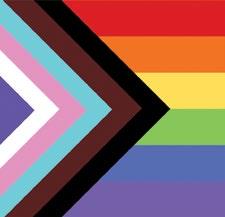
brocku.ca/brock-news/2021/05/month-ofvirtual-pride-activities-begins-tuesday/
Ingrid Makus, Dean of Brock’s Faculty of Social Sciences, was honoured with the Angela Hildyard Recognition Award for Influential Leaders. brocku.ca/brock-news/2021/05/dean-of-socialsciences-recognized-with-national-leadership-award/
September
Graduate Students’ Association celebrates 20th anniversary.
brocku.ca/brock-news/2021/09/ graduate-students-associationcelebrating-20th-anniversary

Brock’s New Student Welcome and Academic Orientation took place virtually on Sept. 7.
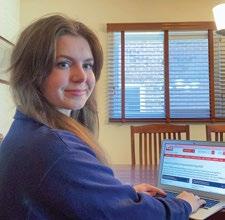
brocku.ca/brock-news/2021/09/ new-student-welcome-andacademic-orientation-to-takeplace-virtually/
Brock University’s main campus was buzzing with activity Sept. 13 as in-person classes resumed.
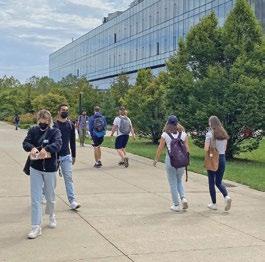
brocku.ca/brock-news/2021/09/brock-campuscomes-back-to-life/
Melissa Kirst started her new role as Brock University’s Director, Brock Sports on June 1. brocku.ca/brock-news/2021/06/new-director-ofbrock-sports-signals-commitment-to-academicathletic-excellence/

October
Virtual statements, a wall with messages of support, and orange shirts marked the first-ever National Day for Truth and Reconciliation at Brock University. brocku.ca/brock-news/2021/09/brock-marks-first-evernational-day-for-truth-and-reconciliation/
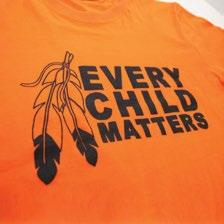
brocku.ca/brock-news/2021/10/brock-scores-highmarks-for-student-support-satisfaction-in-nationaluniversityrankings/
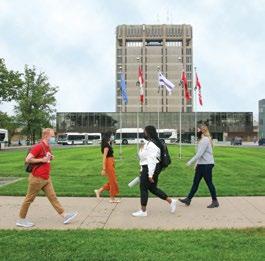
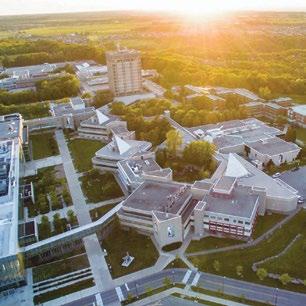
Margaret Kenequanash was honoured as the Goodman School of Business Distinguished Leader on Oct. 28.
brocku.ca/brock-news/2021/10/goodmanschool-of-business-to-honour-first-nationsleader-margaret-kenequanash/
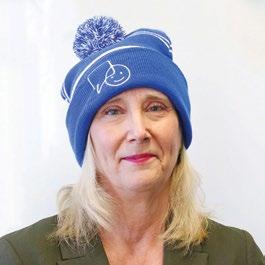


Brock University’s Cool Climate Oenology and Viticulture Institute (CCOVI) turned 25, commemorating a quarter-century since its inception on Oct. 26, 1996. brocku.ca/brock-news/2021/11/ brocks-ccovi-celebrates-25-yearsof-research-excellence/
January February
Brock University Interim President Lynn Wells shared a message with the Brock community on Bell Let’s Talk Day about the importance of continuing the conversation around mental health throughout the year. brocku.ca/brock-news/2022/01/brock-joins-bell-lets-talkconversation-with-week-of-mental-health-eventsresources/
For the fourth time, Brock University has been named one of Hamilton-Niagara’s Top Employers for 2022.
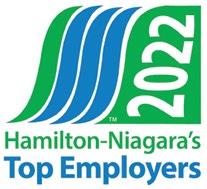
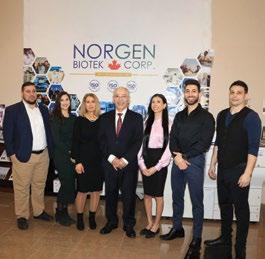
brocku.ca/brock-news/2022/01/brock-named-one-ofhamilton-niagaras-top-employers-for-fourth-time/
An array of virtual activities were held throughout February and early March to mark Black History Month/African Heritage Month at Brock University. brocku.ca/brock-news/2022/01/ black-history-month-at-brockaims-to-celebrate-educate/
The Haj-Ahmad Family Foundation donated $5 million to create the Yousef Haj-Ahmad Department of Engineering at Brock University. brocku.ca/brock-news/2022/02/niagara-familys-transformative5m-gift-boosts-brock-engineering/
brocku.ca/brock-news/2022/02/weeklong-brockwomen-in-stem-event-open-to-the-community/
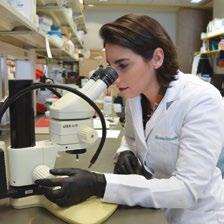
On Tuesday, Feb. 22 the undefeated Badgers women’s basketball (10-0) jumped past Saskatchewan to claim the No. 1 ranking in the U SPORTS Weekly Top 10. brocku.ca/brock-news/2022/02/brockwomens-basketball-claims-historicno-1-national-ranking/

May Excellence in 2021-22
2021
June INSTITUTIONAL STRATEGIC PLAN ICONS Student Experience Research Community Engagement Inclusivity
Brock University has retained its No. 1 ranking in Canada for student mental health supports and moves to No. 3 in Canada and No. 1 in Ontario for student satisfaction.
Mariana Garrido, a PhD student in Brock’s Faculty of Mathematics and Science, led the organizing committee that oversaw the Women in STEM event at Brock Feb. 7 to 11.
2022
Figure 32
Victoria Lawrence, left, and Ivana Twumasi
Pullout 2iv Pullout 2v
brocku.ca/brock-news/2021/06/ken-chan-brocksnew-vice-president-administration-ready-to-buildon-universitys-momentum/
June convocation marked the first time a PhD in Child and Youth Studies has been conferred at Brock or anywhere else in Canada. Yana Berardini and Prarthana Franklin-Luther were the program’s first graduates.

brocku.ca/brock-news/2021/06/phd-program-inchild-and-youth-studies-celebrates-first-graduates/

Brock students, faculty, staff, and community members have enrolled their children at the Rosalind Blauer Centre for Child Care, which marked its milestone 50th year.
brocku.ca/brock-news/2021/06/ rosalind-blauer-centre-forchild-care-turns-50/
July 1, Lynn Wells was appointed Brock University’s new Interim President and Vice- Chancellor.
brocku.ca/brock-news/2021/07/lynn-wells-hitsground-running-as-brocks-interim-president/
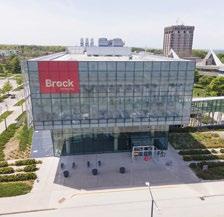

The 210,000-squarefoot facility at Canada Games Park will be named the Walker Sports and Abilities Centre. brocku.ca/brock-news/2021/07/brockcelebrates-walker-family-and-canadasummer-games-partnership/


Brock Vice-President, Research Tim Kenyon (left) competed in a handcycle race with St. Catharines Mayor Walter Sendzik and Thorold Mayor Terry Ugulini, to mark one year until the Canada Games begin. brocku.ca/brock-news/2021/08/one-year-countdown-tocanada-games-begins/
Ken Chan, Brock ’s VicePresident, Administration, and Carol Merriam, Dean of the Faculty of Humanities, joined the Board of Directors for the FirstOntario Performing Arts Centre. brocku.ca/brock-news/2021/07/ chan-merriam-named-toperforming-arts-centreboard/

Vice-President, Research Tim Kenyon says he is excited to be offering a third round of Canada Games research grants. brocku.ca/brock-news/2021/10/brock-vice-president-researchlaunches-third-round-of-canada-games-researchgrants/
March
vi
The Brock community celebrated Giving Tuesday on Nov. 30, a global movement aimed at supporting charitable causes, and raised more than $42,000 for students. brocku.ca/brock-news/2021/12/brocksupporters-raise-more-than-42000-forstudents-on-giving-tuesday/
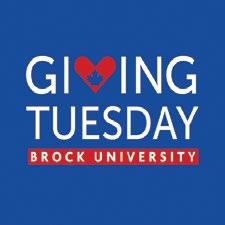
Dramatic Arts instructor Curtis Tye won the Arts in Education Award at the 2021 St. Catharines Arts Awards on Nov. 21. brocku.ca/brock-news/2021/12/dramaticarts-instructor-honoured-at-st-catharinesarts-awards/
December
For the first time since December 2020, Brock’s Campus Store opened for inperson shopping the week of Aug. 3 with limited capacity to allow two metres of physical distancing. brocku.ca/brock-news/2021/08/ campus-store-resumes-inperson-shopping/
brocku.ca/brock-news/2021/11/brockjoins-scarborough-charter-anti-blackracism-national-action-plan/
From Nov. 15 to 19 nearly three dozen events were hosted by Brock International Services for International Education Week (IEW).

brocku.ca/brock-news/2021/11/ gallery-global-learning-experiences-served-up-atinternational-education-week/
Brock University improved its trends rating and retained its A High credit rating from the Dominion Bond Rating Service (DBRS) Morningstar. brocku.ca/brock-news/2022/03/ brock-maintains-a-high-creditrating-trends-upward/
The Zone Fitness Centre at Brock University won the 2022 National Intramural-Recreational Sports Association Outstanding Facility Award. brocku.ca/brock-news/2022/03/brocks-zonefitness-centre-receives-national-recognition/
Jane Koustas, French Professor, with Brock’s Department of Modern Languages, Literatures and Cultures, was awarded the 2022 Governor General’s International Award for Canadian Studies.
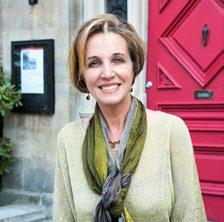
brocku.ca/brock-news/2022/03/ brock-prof-internationally-recognized-forcanadian-studies-contributions/


brocku.ca/brock-news/2022/03/brockywca-working-together-to-improvethe-lives-of-niagara-women-andfamilies/
Keegan Dalal, a master’s student in Brock’s Sport Management program, presented his research at the Two Days of Canada: Canada at Play conference that drew participants from around the world.
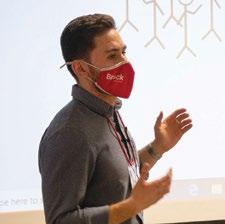
brocku.ca/brock-news/2022/04/brock-conferenceon-sport-draws-international-interest/
April
Sydney Sloane, a fourthyear Physical Education student, was Brock University’s 2021 recipient of the Accessibility and Inclusion Recognition Award. brocku.ca/brock-news/2021/12/advocate-for-those-withdisabilities-earns-accessibility-and-inclusion-award/
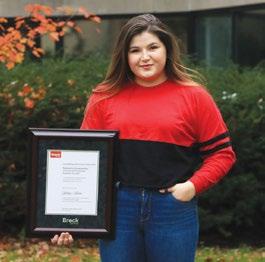
Mel Kobe was recently named general manager of a National Basketball League of Canada franchise. brocku.ca/brock-news/2021/12/brocksport-management-student-named-gmof-canadian-basketball-franchise/
Thanks to a comprehensive application and review process, 27 of Brock’s co-op programs are officially accredited by Co-operative Education and Work-Integrated Learning (CEWIL) Canada. brocku.ca/brock-news/2021/12/coop-programs-receive-nationalaccreditation/
Brock University announced on April 6 that its next Learning Management System (LMS) will be D2L’s Brightspace. brocku.ca/brock-news/2022/04/ brock-selects-kitchener-basedd2l-to-provide-next-learningmanagement-system/


Robyn Bourgeois, Brock’s Acting ViceProvost, Indigenous Engagement, presented at the University’s Town Hall on Friday, April 8. The focus of the townhall was on equity, diversity and inclusion progress and challenges. brocku.ca/brock-news/2022/04/equity-diversity-andinclusion-progress-challenges-highlighted-at-brock-town-hall/
Residence 8, Brock’s newest oncampus student housing building, is open and accepting applications for the 2022-23 academic year. brocku.ca/brock-news/2021/12/brocksport-management-student-namedgm-of-canadian-basketball-franchise/
A ribbon-cutting ceremony was held Friday, April 22 to mark the official opening of Canada Games Park and the Walker Sports and Abilities Centre brocku.ca/brock-news/2022/04/ grand-opening-held-for-walkersports-and-abilities-centreand-canada-gamespark/

July
November Brock University Interim President Lynn Wells signed the Scarborough Charter, joining dozens of postsecondary institutions across the country in committing to address the realities of anti-Black racism. The charter identifies key barriers to Black inclusion and approaches to identifying and responding to them.
Brock Interim President Lynn Wells and YWCA Niagara Region Executive Director Elisabeth Zimmermann signed a Memorandum of Understanding between the two organizations.
Afsana Hossain, Sharifa Ahmed and Aliza Kazi, –Brock University students from Bangladesh.
Pullout 2vi
June 1, Ken Chan, was appointed the new Vice-President, Administration
Brock Sport Management student
A ex
p hy courtesy o f t h e C ty fo S t Chtaira
Heidbuec
August
Pullout 2vii
Brock’s Makerspace provides dedicated spaces for each of its varying technologies (audio, video, 3D printing, VR, etc.) so students who wish to pursue a specific type of tech can have a focused environment that gives them the tools they need to create and succeed.

Pullout 2viii
Our people
Brock Wellness
Wellness continues to be an integral priority of the Brock community as we continue to focus on how well-being influences the overall health of faculty and staff and supports a culture that values work-life balance. This balance is increasingly important as employees may have been impacted by the pandemic in multiple ways, affecting their overall well-being.
The University’s holistic Workplace Wellness Framework was developed to address employee well-being, based on the American Substance Abuse and Mental Health Services Administration’s eight dimensions of wellness (see Figure 33) which has evolved since its inception. Some of this past year’s initiatives included:
• Promoting physical activity: Challenges have been developed that can be incorporated into the workday.
• The protection against the harm from second-hand smoke and vapour: Smoking and vaping of tobacco, nicotine or related products is prohibited except in established outdoor designated smoking areas, and all smoking and vaping of recreational cannabis is completely prohibited.



• Encouraging movement throughout the day: The Virtual Healthy Meeting Guidelines continue to be recommended.







• Assisting in the promotion of work-life balance: The Work-Life Balance Bulletin was created to offer tips and recommendations for separating work activities from personal time.
• Promoting overall well-being: Many virtual seminars and resources continue to be shared with faculty and staff throughout the year.










• Ensuring supports are readily available: Brock continued to promote the enhanced Employee and Family Assistance Program (EFAP) electronic platform, which provides a wide range of individualized, confidential and voluntary support services to eligible employees and their dependents. EFAP benefits were also extended to all Brock employees regardless of benefit eligibility in response to the unprecedented times.
Central to the Workplace Wellness Framework is the Employee Mental Health Strategy, which promoted positive mental health to ensure the following objectives were achieved: 1) Raised awareness and promoted well-being, 2) Developed personal resilience and self-management, 3) Addressed gaps by enhancing services, programs and supports through prevention, and 4) Created and sustained a supportive campus environment. An integral component of the strategy is the Mental Health Commission of Canada’s The Working Mind Training, designed to reduce the stigma around mental health/illness in the workplace by creating a culture that fosters greater awareness and support for mental health-related challenges.
Since March 2020, the focus has shifted to ensuring mental health resources continue to be available to adapt to the changing needs of our Brock community.
ENVIRONMENTAL


INTELLECTUAL Recognizing creative abilities and finding ways to expand knowledge and skills.
PHYSICAL Recognizing the need physical activity sleep and nutrition.
8 DIMENSIONS OF WELLNESS
Source: American Substance Abuse and Mental Health Services Administration

43 2021-22 Annual Report OUR PEOPLE
EMOTIONAL Coping effectively with life and creating satisfying relationships.
Good health by occupying pleasant, stimulating environments that support well-being. SOCIAL Developing a sense of connection, belonging and a well-developed support system.
OCCUPATIONAL Personal satisfaction and enrichment derived from one’s work
FINANCIAL Satisfaction with current and future financial situations.
SPIRITUAL our sense of purpose and meaning in life. D conn well-de AL for y, diet, iti s SPIRITU Expanding ou me
Figure 33
Developing a People Strategy
In recognition of the importance of the role of faculty and staff in ensuring the overall success of Brock, our University leadership has championed the development of a People Strategy.
The People Strategy will provide an overarching framework for creating an exceptional employee experience, including Brock’s employment brand and employee proposition to better position Brock as an employer of choice through the development of unique attraction, retention, employee engagement and development programs. As a talent-driven institution, Brock’s success is driven by the success of our faculty and staff delivering high-quality teaching and learning experiences; conducting outstanding research, scholarly and creative activities; and growing our university-community engagement. The People Strategy reflects Brock’s commitment to creating an environment where people can flourish and make their best contribution as individuals and teams to Brock’s enduring success.
To date, work on the People Strategy includes an environmental scan of other universities and related thought leadership, as well as significant faculty and staff engagement involving multiple focus group discussions. Although the work on the People Strategy was paused to focus on COVID-19 response and recovery, we are excited to refresh this work to be able to capture the significant shift that has emerged over the last few years around the role of a workplace and the future of work. We anticipate being able to translate all this work into a formalized People Strategy and plan of action in fall 2022.
Building leadership capacity
Brock is an organization with a mandate and mission to help people grow and develop, and that focus applies to our staff and faculty, as well as our students.
Building on the successful launch of two new leadership programs in 2021, ‘Leading at Brock’ and ‘Emerging Leaders’, a second offering of the programs was launched in March 2022. The ‘Emerging Leaders Program’ helps to build skills for those in non-management positions who wish to take on greater leadership roles within their current sphere of influence and scope of duties. It is composed of skills-based workshops, including influencing without authority, project management and change management. The ‘Leading at Brock Program’ is for current people leaders, whether they are new or seasoned
leaders, looking to increase their leadership capabilities through development. This workshop series seeks to deepen and strengthen leadership skills as well as increase knowledge of core topics related to management at Brock. Each cohort-based program includes 24 participants from across the University.
In addition, Human Resources leads the Learning Advisory Committee, which brings partners from across the University together to discuss how best to collaborate and co-ordinate the various training and learning opportunities that occur across the campus.
The formal Brock Employee Mentorship Program, which is now in its fourth year, for staff and faculty continues to expand and grow. The program matches mentors and mentees from across the University, building relationships, experiences for growth and opportunities for collaboration. Learning opportunities for faculty and staff continue to be shared through the Brock News, with a more fulsome list available on ExperienceBU at experiencebu.brocku.ca/organization/staff
Our employees
Our people are the key to Brock’s success. We appreciate all faculty and staff for their dedication, and we will continue to recognize our exceptional Brock team with incentives and initiatives. Figure 34 depicts the long-term service of ongoing staff and faculty at Brock, with more than 50 per cent providing more than 10 years of service, and more than 67 per cent of Brock’s ongoing workforce providing five years of service or more. Currently, there are 287 staff and faculty with 20 years of service or more. Brock works because of the dedication of our people.
Less than 1 year of service
Between 1 and 2 years of service
Between 2 and 5 years of service
Between 5 and 10 years of service
Between 10 and 15 years of service
Between 15 and 20 years of service
More than 20 years of service
44 2021-22 Annual Report OUR PEOPLE
Figure 34: Ongoing permanent employees (%)
Source: Workday as of May 19, 2021.
6 16 19 17 16 18 8
Source: Workday as of May 11, 2022
Figure 34: Ongoing permanent employees (%)
Financial facts
Tracking transactions and processes
2021-22 Annual Report REVIEWING THE NUMBERS 45 Reviewing the numbers Manual journals, accruals, finance-adjusting journals and ad hoc bank transactions Customer invoices Supplier invoices Expense reports Ad hoc payments April 2021 March 2021 Feb. 2021 Jan. 2021 Dec. 2020 Nov. 2020 Oct. 2020 Sept. 2020 Aug. 2020 July 2020 June 2020 May 2020 1,762 81 1,083 603 142 1,083 91 1,290 687 705 886 74 1,239 776 71 852 86 1,351 705 85 1,410 89 1,661 854 209 1,240 56 1,526 1,024 140 1,021 191 1,789 1,180 188 955 117 1,456 1,017 531 1,521 119 1,350 1,090 356 976 106 1,218 1,042 538 1,969 123 1,650 1,613 179 1,316 129 1,323 2,492 746 Total transactions processed: 50,162 Monthly supplier invoices* Average approval time (days) Average payment time-cheques only (days)
Workday finance has
to understand and report
financial transactions
significantly enhanced Brock’s ability
on the
of the University. The following Workday facts only scratch the surface of the information available to users of the University’s financial information.
May June July Aug. Sept. Oct. Nov. Dec. Jan. Feb. March April 1,083 1,290 1,239 1,351 1,661 1,526 1,789 1,456 1,350 1,218 1,650 1,323 2 2 3 4 3 5 6 3 5 3 3 2 19 17 13 10 9 8 9 10 6 9 6 4 The average time for an expense report to be fully approved from the day it is submitted is: 11 DAYS 2018-19 13 DAYS 2019-20 6 DAYS 2020-21 7 DAYS 2021-22 (including weekend days).
35: Supplier invoice
*Excludes supplier invoices batch
Figure 36: Number of transactions processed in Workday in 2021-22 – by type Figure
lifecycle (2021-22)
input by Finance.
Operating
Faculty of Applied Health Sciences
Scholarships, Bursaries and Student Awards
Operating**
Student Specific –
Ancillary
Faculty of Mathematics and Science – 9%
Academic Support – 9%
Faculty of Social Sciences – 3%
Faculty of Humanities – 3%
Faculty of Education – 2%
Goodman School of Business – 2%
Faculty of Applied Health Sciences – 1%
46 Tracking spending type The following are the average values of transactions for 2021-22: Expense reports – $684 Supplier invoices – $9,705 Ad hoc payments – $741 Figure 37 Figure 38 2021-22 Annual Report REVIEWING THE NUMBERS External research grants Total $12.9 million 0 2,000 4,000 6,000 8,000 10,000 12,000 Personnel costs* Scholarships, fellowships, bursaries and awards Equipment purchases and repairs and maintenance Travel costs and conference fees Materials and supplies Professional fees and contracted services Other 2021-22 spending on external research grants by spending type ($000s) *External research grants spending includes the funding of Canada Research Chairs’ salaries recorded in operating. 21 31 19 10 6 5 4 2 2 Total Spend $8,348,000 Equipment purchases and repairs and maintenance Materials and supplies Other Travel and conference fees Marketing and advertising Memberships, dues and subscriptions Hospitality Contracted services Professional development/training *Spending includes departmental purchases made on department purchasing cards and excludes central finance purchasing cards. ** See Figure 53 for detail of what units are included in the groups. Figure 39: 2021-22 Scholarships, Fellowships, Bursaries and Awards by funding source (%) 79 9 8 3 Operating External research grants Endowments
trust accounts Internal research projects 1 2021-22 spending on external research grants by Unit (%)
Science
Non-endowed
Faculty of Mathematics and
Faculty of Social Sciences
Research Services
30 23 15 15 1 10 2 2 2 Total active purchasing cards as of April 30, 2022 was 987 , with spending on purchasing cards totalling more 2021-22 spending on expense reports by type* (%) 2021-22 spending on expense reports by funding source* (%)
Faculty of Humanities Goodman School of Business Leadership Faculty of Education
grants
External research
accounts
capital and research projects Course fees
Start-up and professional reimbursement
Internally restricted operating,
34%
Shared Services – 13%
– 13%
Space – 11%
58 9 3 12 18 than $17.1 MILLION in 2021-22.
Workday Limited
Softchoice LP Echo360, Inc.
Association Of Registrars of the Universities and Colleges of Canada Compugen
Kainos Worksmart Ltd.
Cinema Stage Inc
Ontario Research and Innovation Optical Network (ORION)
Blackstone Energy Services Inc. Explorance Qualtrics LLC Other
City
Sun Life Assurance Company of Canada Insurance
Canadian Research Knowledge Network Library acquisitions
Twin Eagle Resource Management Canada, LLC Natural gas
Brock Plaza Corporation Residence lease payments
Council of Ontario Universities Library acquisitions
Horizon Electricity WCPT Lofts II Inc. Residence lease payments
CURIE Insurance Garda Security
FirstOntario Performing Arts Centre Facilities rental
Enbridge Natural gas
Lifeworks (Canada) Ltd. Counselling and mental health programs
Ethical Associates Inc. Professional services
Glacier Communications Online marketing and advertising
Tracking suppliers, regional spending and collaborative buying
suppliers
Purchase
Figure 41: Brock’s top
by operating cost amount Supplier
of St. Catharines Water and taxes
38 19 16 4 4 4 3 22 22 4 Total Spend $3,184,000 Niagara West Niagara Centre Niagara East St. Catharines Grimsby Lincoln West Lincoln Wainfleet Port Colborne Welland Thorold Niagara Falls Fort Erie Pelham St Catharines Niagara-on -the-Lake Total spending* to
42 47 2021-22 Annual Report REVIEWING THE NUMBERS Figure 40: 2021-22 Software purchases by supplier(1) (%) (1) Does not include departmental P-card spending. * Included in spending amount are payments to suppliers relating to funds collected by Brock University on the suppliers’ behalf. NIAGARA REGION suppliers for 2021-22 was more than $33.9 million to 331 suppliers. The average spend per supplier was more than $102,500 to each supplier. TOP NIAGARA REGION SUPPLIERS BY SPEND AMOUNT: Figure 43 • BUSU Inc. • Merit Contractors Niagara • City of St. Catharines • Rankin Construction Inc. • Horizon • Brock University Faculty Association • The Regional Municipality of Niagara • Enbridge • FirstOntario Performing Arts Centre • Niagara College Total collaborative buying in 2021-22 was OECM – Ontario Educational Cooperative Marketplace NPPC – Niagara Public Procurement Committee CAUBO – Canadian Association of University Business Officers MGS- Ontario Ministry of Government Services OUPMA – Ontario University Procurement Management Association CRC – Campus Retail Canada OCUL – Ontario Council of University Libraries CRKN – Canadian Research Knowledge Network $12.6 MILLION through the following collaborative organizations:
Figure
Overview
This year has been one of continued challenges resulting from the global pandemic; however, consistent with years past, the excellence in students, alumni, faculty and staff and their accomplishments are vast and deserve to be celebrated. These activities continue to be supported by the resource allocations of the University. The following sections provide a closer look at the financial activity of the University. Figure 44 illustrates the financial results of the University compared to the budget and prior year actual. The information is presented on a funding basis, which represents the commitment of cash and the audited Financial Statements prepared in accordance with accounting standards for not-for-profits (NFPS). A reconciliation between the two presentations can be found starting on page 60, with commentary on the funding actual results starting on this page, and commentary for the NFPS actual results on page 64.
Figure 44 ($000s)
Financial results – funding basis
The following section explains the 2021-22 results on a funding basis, not to be confused with the audited Financial Statements, which are prepared in accordance with accounting standards for not-for-profits (Part III of the CPA Handbook NFPS). The funding basis represents committed cash. A positive balance, or funding surplus, represents uncommitted cash, and a negative balance, or funding deficit, represents overcommitted cash.
The 2021-22 fiscal year marks the eighth straight year of funding surplus results. The actual funding surplus for 2021-22 of $3.9 million is before year-end discretionary appropriations for reinvestment in the University. This is an extraordinary outcome given the continued impacts the global pandemic had on the University during 2021-22. In 2021-22, the discretionary appropriations funded important initiatives in the strategic initiative fund, with further details provided on page 54.
Student fees 188,064 196,563 187,773 197,036 186,012 186,657 Grant revenue 99,780 97,708 97,338 94,758 106,724 103,943
Internal chargebacks 7,346 8,641 3,098 Inter-fund revenue 5,943 7,462 8,843 Research revenue 13,173 13,034 11,778 Other revenue 50,256 48,406 63,736 61,747 24,319 39,066
Total revenues 351,389 358,780 362,020 366,575 328,996 341,444
Operating costs
Personnel costs (221,304) (233,761) (229,489) (237,560) (214,657) (220,557) Inter-fund expenses (28,926) (26,610) (18,143) Other operating costs (97,262) (101,888) (129,772) (128,957) (83,302) (113,842)
Total operating costs (347,492) (362,259) (359,261) (366,517) (316,102) (334,399)
Mitigation target 3,479
Funding surplus (before discretionary appropriations) 3,897 - 2,759 58 12,894 7,045
Discretionary appropriations (3,896) (12,885)
Funding surplus (after discretionary appropriations) 1 - 2,759 58 9 7,045
48 2021-22 Annual Report REVIEWING THE NUMBERS
Funding NFPS Funding 2020-21 Actual NFPS 2020-21 Actual 2021-22 Actual 2021-22 Budget 2021-22 Actual 2021-22 Budget Revenue
When the 2021-22 funding budget was originally established, we estimated a balanced funding budget, after a $3.5-million mitigation target. With hard work and dedication throughout the University, we were able to end the year with a small surplus. This is commendable, as the COVID-19 pandemic was still ongoing throughout the year. To the whole University community, congratulations and thank you for your ongoing contributions to our strategic priorities. Our Institutional Strategic Plan has guided us toward the success behind these numbers. This financial reporting section is just one of many ways the University reports and celebrates Brock’s contributions to society. We hope you find the following analysis relevant and useful and thank everyone for contributing to the stories behind Brock’s fiscal results in 2021-22.

Review of overall revenue
Actual revenue for 2021-22 was $7.4 million behind budget, with student fees lower than budget by $8.5 million offset by higher grant revenue of $2.1 million. Other revenue was higher than budget by $1.9 million while internal chargeback revenue and inter-fund revenue were both lower than budget by $1.3 million and $1.5 million, respectively. These variances will be fully discussed in the following sections.
Tuition and enrolment
Student fee revenue finished the 2021-22 fiscal year at $188.1 million. Figure 45 details the breakdown of student fees between tuition revenue and fee revenue.
Figure 45
($000s)
2021-22 Annual Report REVIEWING THE NUMBERS 49
2021-22 Actuals 2021-22 Budget 2020-21 Actuals
177,399
178,305 Fee revenue
Tuition
186,039
10,665 10,524 7,707 Total student fees 188,064 196,563 186,012
Psychology PhD student Anita Twele (far left), Professor of Psychology Catherine Mondloch (centre) and Psychology PhD student Sophia Thierry (right) published a paper on April 27, 2022 that found that masks do not have a significant impact on initial impressions.
46: 87.0% 86.6% 87.8%
student Figure 47: Global tuition billings by session ($000s)(1) 21.3
Figure 47: Global tuition billings by session ($millions)(1) (1) Tuition by session does not include ISP, ESL, Continuing Teacher Education or Adult Education tuition.
141.8 136.3 13.0% 13.4% 12.2%
Figure 2019-20 Actual 2020-21 Actual 2021-22 Actual
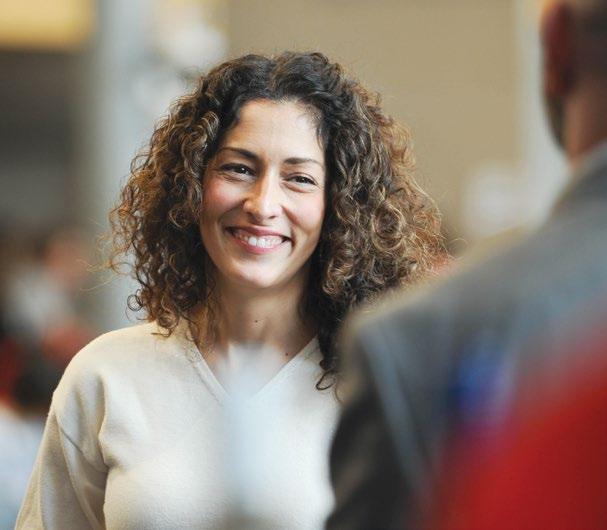
142.7 22.0 18.9
As compared to budget, the tuition shortfall of $8.6 million is mainly the result of lower international enrolment, with student headcount 102 less than budget, mainly due to the continued travel and other related restrictions due to the pandemic. The lower enrolment resulted in international tuition being $7.3 million below budget, as shown in Figure 48. Self-fund tuition was also lower than budget by $1.2 million, mainly seen in the Intensive and Short-term English Language Programs, once again due to international restrictions.
50 2021-22 Annual Report REVIEWING THE NUMBERS
All-in
Compared to prior year, tuition revenue decreased $0.9 million, with lower domestic tuition offset by international growth coming out of the pandemic. Domestic student headcount was down versus 2020-21 by 240 students, resulting in domestic tuition down $1.8 million due in part to a very strong Spring/Summer session in 2020-21, which saw growth of 16 per cent over 2019-20. Figure 47 shows the split of global tuition between Spring/Summer (13.0 per cent) and Fall/Winter (87.0 per cent) sessions. International student headcount enrolment was up by 30 students versus 2020-21, which combined with international rate increases, resulted in international tuition to be $1.7 million higher than 2020-21. All-in student headcount is shown in Figure 46. Headcount by Faculty is shown in Figure 13 on ‘The big picture’ pull-out. As compared to 2020-21, the Faculty of Social Sciences and the Goodman School of Business saw the largest decreases, with 181 and 47 less students, respectively. Both the Faculty of Applied Health Sciences and the Faculty of Humanities had small increases as compared to 2020-21. enrolment by type Type 2021-22 Actual 2021-22 Budget 2020-21 Actual 2019-20 Actual Headcount (1) FTE (2) Headcount (1) Headcount (1) FTE (2) Headcount (1) FTE (2) Undergraduate – domestic 15,760 15,468 15,905 15,970 Undergraduate – international 1,893 1,957 1,867 1,819 Total undergraduate 17,653 17,237 17,425 17,772 17,407 17,789 17,099 Graduate – domestic 1,197 1,302 1,292 1,235 Graduate – international 663 701 659 772 Total graduate 1,860 1,697 2,003 1,951 1,724 2,007 1,783 Total 19,513 18,934 19,428 19,723 19,131 19,796 18,882 (1) Represents Fall student headcount full time (FT) and part time (PT). For a definition, refer to pg 88 of the 2022-23 Budget Report. (2) Represents full-time equivalent (FTE) students. For a definition, refer to pg 88 of the 2022-23 Budget Report. Spring/Summer Fall/Winter
Figure 48: Tuition revenue(1)
($000s)
Undergraduate – domestic
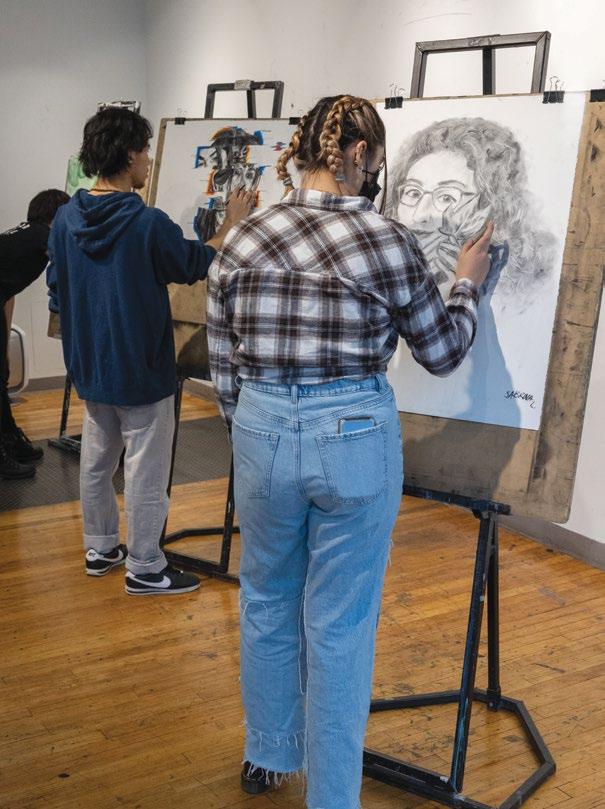
2021-22 Actual 2021-22 Budget 2020-21 Actual
Faculty of Applied Health Sciences 24,157 23,660 23,863
Goodman School of Business 17,515 17,710 18,292
Faculty of Education 8,437 7,833 7,598
Faculty of Humanities 10,373 10,352 10,247 Faculty of Mathematics and Science 11,771 12,274 12,473 Faculty of Social Sciences 25,592 26,234 27,159 Other (2) 365 226 218
Total undergraduate – domestic 98,210 98,289 99,850
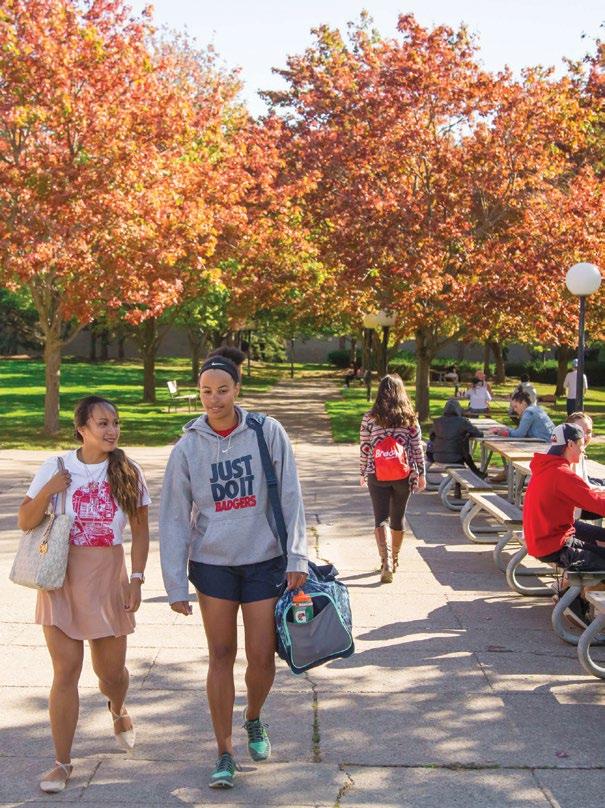
Graduate – domestic Faculty of Applied Health Sciences 2,308 2,006 2,248
Goodman School of Business 1,524 1,848 1,459
Faculty of Education 915 1,215 1,025
Faculty of Humanities 295 354 363 Faculty of Mathematics and Science 752 555 679 Faculty of Social Sciences 2,544 2,472 2,703
Total graduate – domestic 8,338 8,450 8,477
Total domestic 106,548 106,739 108,327
Undergraduate – international Faculty of Applied Health Sciences 5,035 4,583 4,487
Goodman School of Business 15,523 18,871 16,548 Faculty of Education 690 641 304 Faculty of Humanities 2,321 2,140 2,089 Faculty of Mathematics and Science 12,023 12,879 11,239 Faculty of Social Sciences 16,688 18,230 16,456 Other (2) 39 34 46
Total undergraduate – international 52,319 57,378 51,169
Graduate – international
Faculty of Applied Health Sciences 333 270 286
Goodman School of Business 12,533 13,371 12,914
Faculty of Education 1,148 2,521 787
Faculty of Humanities 261 245 146
Faculty of Mathematics and Science 1,578 1,766 1,408 Faculty of Social Sciences 949 844 735
Total graduate – international 16,802 19,017 16,276
Total international 69,121 76,395 67,445
Total undergraduate and graduate tuition 175,669 183,134 175,772
Continuing Teacher Education – Additional Qualifications – AQ 756 943 919
Adult Education 596 722 581 Intensive and Short-term English Language Programs (IELP & SELP) 378 1,240 1,033
Total Tuition Revenue 177,399 186,039 178,305
(1) Figures based on the Faculty of major.
(2) Includes letter of permission, non-degree students and auditors.
51 2021-22 Annual Report REVIEWING THE NUMBERS
Figure 49: Grant revenue
($000s)
MCU Operating Grants
2021-22 Actual 2021-22 Budget 2020-21 Actual 2019-20 Actual
Core Operating Grant 59,050 58,091 68,706 81,743
Differentiation Envelope (Performance/Outcomes-based Funding Grant) 28,738 29,697 19,082 6,045
Special Purpose Operating Grant Envelope 3,740 3,071 11,141 3,209
International Student Recovery (1,720) (1,749) (1,748) (1,705)
Total MCU Operating Grants 89,808 89,110 97,181 89,292
Other MCU and Specific Purpose Grants 9,972 8,598 9,543 7,496
Total grant revenue 99,780 97,708 106,724 96,788
Grant revenue
As detailed in Figure 49, in 2021-22, Brock received $99.8 million of grant revenue, of which $87.8 million related to the Core Operating Grant and the Differentiation Grant Envelope. This is consistent with the 2021-22 budget as well as the actuals received in both 2020-21 and 2019-20.
The Special Purpose Operating grant envelope was $0.7 million higher than budget mainly due to additional grant funding received related to the Mental Health and the Disabilities grant, as well as receiving funding for the Women’s Campus Safety grant, which was not budgeted. The decrease as compared to the 2020-21 actuals is due to the one-time MCU COVID-relief grant of $7.9 million, which was announced and received in 2020-21. Other MCU and specific purpose grants were higher than budget by $1.4 million, due to increased funding received for the Nursing grant of $0.9 million as well as an increase to the Research Support Funding of $0.2 million. In addition, the University received a number of other special purpose grants that were not expected at the time of the budget, including funding from Co-operative Education and Work-Integrated Learning Canada Innovation HUB and the Student Work-Placement Program grant funded by the Government of Canada.
Other revenue
Total other revenue was higher than budget by $1.9 million, driven by higher than forecasted investment income, sales and services revenue, and asset sales revenue at $0.3 million, $0.8 million and $0.8 million, respectively.
The higher sales and services revenue of $0.8 million compared to budget was driven by additional Ontario University Application Centre revenue received as well as other unbudgeted amounts such as surplus/salvage revenue.
General investment income exceeded budget by $0.3 million, more fully described in the Treasury section of this report. Offsetting this increase was the fact that the budget included investment income related to the sinking fund of $0.4 million. This revenue was recorded directly in the internally restricted sinking fund in the actual results and, as a result, is not shown in the actual funding investment income.
Total Ancillary revenue was consistent with budget and higher than 2020-21 actuals by $21.9 million. This positive rebound resulted from increased activity on campus during the year as compared to 2020-21 resulting from lifted COVID-19 restrictions. Parking saw an increase of $3.1 million year-over-year, Dining Services increased $2.4 million and Campus Store saw a $0.6-million increase. Residence fees increased $15.7 million with overall residence capacity at 80.11 per cent in 2021-22 as compared to only 10 per cent last year.
The asset sale revenue of $3.4 million is related to the sale of the Hamilton campus and other asset sales.
Figure 50: Other revenue ($000s)
2021-22 Actual 2021-22 Budget 2020-21 Actual
Residence fees 19,080 18,895 3,376
Other ancillary revenue 12,112 12,283 5,898
Total ancillary revenue 31,192 31,178 9,274 Investment income(1) 2,159 1,866 2,469
Sales and services 13,482 12,716 12,576 Asset sale revenue 3,423 2,646
Total other revenue 50,256 48,406 24,319
(1) Actual figures do not include investment income/loss recorded directly in the sinking fund and employee future benefits reserve. In 2021-22, the sinking fund recorded an investment loss of $0.4 million and the employee future benefits reserve a loss of $0.3 million.
52 2021-22 Annual Report REVIEWING
THE NUMBERS
Internal chargebacks and inter-fund revenue
Internal chargeback revenue was lower than budget for 2021-22 by $1.3 million. This decrease was mainly due to lower-than-expected chargebacks related to utilities. Interfund revenue was also lower than budget by $1.5 million, $1.2 million of which is the result of not having to use the contingency reserve for budget mitigation, which was set aside in the budget. Included in the actual inter-fund revenue was $0.8 million of funding from the Strategic Initiative Funds, consistent with the budget. These funds are established as part of prior year-end discretionary appropriations. Decisions were made throughout the year to utilize strategic reserves by investing in priorities outlined in the Institutional Strategic Plan.
Operating costs
Personnel costs
Our people are what make everything possible at Brock University. Figure 51 illustrates the actual 2021-22 personnel costs versus budget and prior year by personnel group on a funding basis. Overall personnel costs, on a funding basis, were under budget by $12.5 million. The savings were mainly seen in faculty and professional librarians and admin/professional employee groups. Nonfaculty vacancies were evaluated during the year through a hiring review process to ensure our mitigation was achieved.
Temporary personnel costs were slightly lower than budget with CUPE 4207 Unit 1 actuals being over budget by $0.5 million offset by other temporary employee groups being under budget by $0.6 million. Savings versus budget were also experienced in benefit costs of $5.4 million due in part to less health and dental costs during the year likely resulting from the ongoing pandemic.
Faculty and Professional Librarians 91,432 17,933 109,365 94,023 20,647 114,670 106,533 Admin/professional 44,478 11,614 56,092 47,656 13,381 61,037 54,667 OSSTF 7,024 2,192 9,216 7,857 2,538 10,395 9,498 CUPE 1295 FT 6,476 2,030 8,506 6,964 2,513 9,477 8,641 SAC 5,859 993 6,852 5,715 1,134 6,849 6,846 Other ongoing personnel 705 191 896 655 201 856 1,295 Total ongoing personnel 155,974 34,953 190,927 162,870 40,414 203,284 187,480 CUPE 4207 Unit 1 14,885 1,679 16,564 14,398 1,642 16,040 16,392 Other temporary personnel 12,782 1,031 13,813 13,474 963 14,437 10,785
Total temporary personnel 27,667 2,710 30,377 27,872 2,605 30,477 27,177
Total – funding basis 183,641 37,663 221,304 190,742 43,019 233,761 214,657
(See page 61
future benefits adjustment(2)
discussion of
(2) The employee future benefits adjustment for actual 2021-22 of $266,000 is the difference between payments made for employee future benefits and the net change in the obligation. The employee future benefits adjustment for budget 2021-22 actually nets two adjustments – $748,000 and $1,463,000. Refer to adjustment 10 and 11 on page 90 of the 2021-22 Budget Report for detailed descriptions of these adjustments.
(3) The personnel costs on a funding basis does not include personnel costs recorded in the internally or externally restricted funds. This adjustment represents the personnel costs in the following funds: endowments, course fees, capital and infrastructure projects and reserves, operating project accounts, research funds with no external obligations, start-up funds, professional expense reimbursement accounts and the external research fund.
53 2021-22 Annual Report REVIEWING THE NUMBERS
Figure 51: Personnel costs by group
2021-22 Actual 2021-22 Budget Actual 2020-21 Salary/wage Benefits Total personnel costs Salary/wage Benefits Total personnel costs Total personnel costs
Personnel group (1) ($000s)
Adjustments to NFPS
for
adjustments) Employee
266 266 (715) (715) (232) Internal restricted funds and research personnel costs(3) 6,866 1,053 7,919 3,925 589 4,514 6,132 Total – NFPS basis 190,507 38,982 229,489 194,667 42,893 237,560 220,557 (1) Faculty and Professional Librarians – BUFA members, Associate Deans, Associate Vice-Presidents of Research and Associate Librarian; Admin/Professional – ongoing administrative/professional and exempt staff; OSSTF – support and technical staff; CUPE 1295 FT – full-time maintenance, trades and custodial staff; SAC – Senior Administrative Council; Other ongoing – CUPE 4207-2, CUPE 4207-3, CUPE 2220 and IATSE; CUPE 4207 – Unit 1 – instructors, teaching assistants, lab demonstrators, course co-ordinators and marker/graders; Other temporary – all other part-time teaching and non-teaching positions, Faculty overloads and stipend transfers.
Non-personnel operating costs
Overall operating costs, excluding inter-fund expenses, were $4.6 million lower than budget. The following represent the largest variances to budget:
• Other operating costs were lower than budget by $2.5 million driven by lower travel and hospitality expenses because of the pandemic. Internal chargeback expenses were lower than budget mainly as a result of not using the $1.8 million of uncommitted strategic/discretionary funds which represented 0.5 per cent of revenue. This unused allocation was reserved as part of the discretionary appropriations.
• Utilities costs were lower than budget by $1.7 million due to lower electricity, natural gas and water and sewer costs, offset by higher carbon and greenhouse gas costs.
• Purchased services were lower than budget by $0.2 million, mainly driven by lower-than-budgeted contracted services related to the Canada Summer Games Consortium, as well as in maintenance and custodial contracted service. This is offset by higher-thanbudgeted professional fees.
• Inter-fund expenses (before discretionary appropriations), representing transfers to internally restricted reserves, were higher than budget by $2.3 million. The majority
of this increase relates to start-up costs for new Faculty members, mostly in support of the Engineering program.
• The annual discretionary appropriations established at year-end, and approved by the Board of Trustees, are also inter-fund transfers, and represent the portion of the University’s funding surplus that is reinvested in the University’s Strategic Priorities at year-end. In 202122, the discretionary appropriations were $3.9 million, which funded the following internally restricted strategic reserves:
• $1.05 million for the Dean’s Strategic Funds, administered by the Provost, and allocated to each Dean through the Revenue and Expense Allocation model, more fully described starting on page 58.
• $0.32 million for the Vice-President, Research Support Envelope.
• $0.37 million for the Provost Strategic Fund.
• $0.26 million for the President’s Strategic Fund.
• $0.11 million for the Vice-President, Administration Strategic Fund.
• $1.79 million for the Central Strategic Fund representing the unspent strategic/discretionary funds established as part of the operating budget.
54 2021-22 Annual Report REVIEWING THE NUMBERS
Total 128,498 18,172 8,107 13,019 8,502 23,845 5,222 4,513 26,610 20,508 Total 130,084 17,942 6,393 12,985 8,636 23,675 5,218 4,366 32,822 18,047 2021-22 Purchased services Utilities and taxes Financial expenditures Repair and maintenance and capital replacement Scholarships and fellowships Library acquisitions Cost of sales Inter-fund expenses(1) Other operating costs Actual operating costs ($000s) Budget operating costs ($000s) 14% 14% 6% 10% 4% 3% 21% 16% 7% 19% 10% 7% 4% 3% 25% 18% 14% 5%
(1) Included in actual inter-fund expenses are discretionary appropriations in the amount of $3,896.
Figure 52
Funding results by unit
Figure 53 presents the budgeted revenue and costs of each of the University’s responsibility centres based on each unit’s responsibility for establishing their respective budgets. The division of the responsibility centres is not meant to measure each unit’s total revenue impact or fully loaded costs. As such, revenue shown in the Faculties does not include an allocation of global tuition or operating grant revenue. Revenue shown by the responsibility centre only reflects the tuition, fee and grant revenue specifically budgeted in the respective centres, as well as any other revenue generated within each centre.
Total costs, as shown in the responsibility centres, include salaries, benefits and direct non-personnel costs (operating costs). Support service costs have not been allocated in these figures. For example, the majority of utility costs are shown collectively as part of the Utilities, Taxes and Insurance responsibility centre and the majority of scholarships, bursaries and fellowships are reported as part of the Scholarships, Bursaries and Fellowships responsibility centre.
As detailed in the Revenue and expense allocation model section of this report, the revenue and expense allocation model has been developed and allocates all budgeted revenue and net operating costs of the University, including support service costs, to each of the six teaching Faculties. The Provost, working with Financial Services, is utilizing this model as a planning tool.
It should also be noted that direct, externally funded research revenue and matching expenses are not included in the budget, given revenue is recognized as the grants are spent having a net zero impact on the budget, and that asking researchers to forecast timing of spend would be an unnecessary administrative burden.
With certain pandemic related restrictions and mitigation efforts still in place throughout the year, we note that teaching Faculties closed out 2021-22 with a $3.2-million positive variance to budget. The Utilities, Taxes and Insurance unit resulted in budget-to-actual savings of $1.9 million, as a result of the utility cost efficiencies experienced during the year. Further, shared services units were under budget by $1.4 million, with savings across several units including the Senior Academic and Administrative Team, Development and Alumni Relations, Information Technology Services, Financial Services and Human Resources. Student Specific units were also under budget by $1.7 million, mainly in the Office of the Registrar and Brock International Services. Finally, Ancillary and Residence Services’ net contribution to the University for 2021-22 was $4.7 million, $2.3 million higher than budget.

55 2021-22 Annual Report REVIEWING THE NUMBERS
Revenue and expense allocation model
The revenue and expense allocation model was developed through a consultative process with allocation methodologies approved by the Deans and Provost. The model has three key functions to support academic and financial planning of the University:
1. Enhances the understanding of how revenues are generated and how costs are incurred and allocated at the Faculty level in a transparent manner.
2. Supports longer-term resource allocation decision-making for academic units.
3. Establishes an incentive mechanism to ensure year-end surplus funds are allocated to the Faculties and to support institutional strategic priorities.
The third purpose refers to the funding of the Deans’ Strategic Funds, which are allocated based on a twoenvelope basis. The first envelope recognizes the contributions of the Faculties that have a positive contribution margin (i.e. expenses less than revenue) after space costs, recognizing this contribution margin level reflects expenses Faculties have direct control over. The second envelope provides an incentive for year-over-year
improvements in contribution margin, after space costs, for all Faculties through a method that allocates a share of the surplus based on the year-over-year improvement. The use of these funds are bound by the terms of reference with the Provost and are to support the institutional strategic priorities.
Figure 55 reports the full actual funding results for 2021-22 using the Revenue and Expense Allocation Model. Figure 54 is a visual representation of the 2021-22 actual results versus budget, detailing expenses as a percentage of revenues allocated by each Faculty and in total. The model identifies three Faculties generating net positive contributions, one Faculty breaking-even and two Faculties requiring additional funding from these positive contributions to support their operations. Through guidance from the Senior Academic Leadership Team, this model reports all tuition based on students in seats. Regardless of a student’s home Faculty, all tuition is allocated to the course students take and the Faculty the course belongs to.
Going forward, the model will continue to be evaluated and adjustments to the model will be made, in consultation with the Senior Academic Leadership Team where appropriate, to ensure the model is meeting its goals as well as supporting the Institutional Strategic Plan.
58 2021-22 Annual Report REVIEWING THE NUMBERS
100% 0 20 40 60 80 100 120 140 160 21-22 Budget 21-22 Actual 21-22 Budget 21-22 Actual 21-22 Budget 21-22 Actual 21-22 Budget 21-22 Actual 21-22 Budget 21-22 Actual 21-22 Budget 21-22 Actual 21-22 Budget 21-22 Actual Space costs Direct costs Scholarships Academic and student support Overhead FA HS Goodma n FO E FO H FMS FOSS TOTAL 12 19 7 12 50 100 12 4 6 11 56 89 11 14 5 11 74 115 11 13 14 9 87 134 9 11 15 15 18 9 48 55 59 95 93 7 11 5 7 8 11 100 13 11 12 6 4 3 14 16 12 12 15 8 8 19 8 11 54 105 88 126 143 92 101 93 16 14 10 13 9 15 9 12 11 16 6 8 55 81 58 90 47 52 Figure 54: 2021-22 Actual vs. budget costs as
percentage of total revenue (%)
a
Funding basis reconciled to the Financial Statements
A full reconciliation of the differences between the audited NFPS basis of accounting and the funding basis will follow; however, there are two key observations regarding these differences:
• The funding basis accounts are a subset of the audited NFPS accounts, which represent operating/unrestricted activities of the University and the unrestricted fund. The Examination of the Net Assets section, starting on page 62, describes each of the funds of the University.
• The largest difference between the funding basis and the NFPS basis is the treatment of capital transactions. On a funding basis, all principal payments on debt and all fund transfers into separate capital funds to purchase capital and related costs are considered expenses. The function of transferring the funds into separate capital
fund accounts is a mechanism to ensure cash is actually set aside to cover capital and related costs. Therefore, when the cash is transferred to separate capital funds, the funding basis treats the transfer as an expense. On a NFPS basis, capital purchases are not expensed, as they result in an asset, and are included on the Statement of Financial Position. These assets are subsequently expensed through the process of amortization over the useful life of the asset. This is similar to an individual who might purchase a home; the home becomes part of an individual’s net worth statement net of any loans used to purchase the home.
Figures 56 and 57 reconcile the 2021-22 financial results from a funding basis to the NFPS basis. The adjustments represent differences in reporting between the NFPS basis and the funding basis, and are primarily for noncash transactions and timing differences. Each of these differences are described below: Figure 56:
Figure 57: NFPS Adjustments
Revenue
Student fees 188,064 (613) 1,2 322 187,773 Grant revenue 99,780 (2,953) 3 511 97,338
Internal chargebacks 7,346 985 (8,331)
Inter-fund revenue 5,943 9 6 (5,952) Research revenue 13,173 4 13,173 Other revenue 50,256 13,201 5,6,11 279 63,736
Total revenue 351,389 22,817 2,097 (5,952) (8,331) 362,020
Operating costs
Personnel costs (221,304) (4,375) 1,4,6,8,10 (3,810) (229,489)
Inter-fund expenses (32,822) (2,653) 4,6 35,475
Other operating costs (97,262) (36,114) 1,4-9 (4,727) 8,331 (129,772)
Total costs (351,388) (43,142) (8,537) 35,475 8,331 (359,261)
Funding surplus (after discretionary appropriations) 1 (20,325) (6,440) 29,523 - 2,759
Notes Adjustment Amount 1
Course fee revenue 897
Student fees (for capital) (1,510)
Capital grants (2,953)
Research, including fellowships 13,173
Amortization of deferred capital contributions 8,812
Endowment and trust spending 4,524
Proceeds of asset sales (126)
Total revenue adjustments 22,817 1 Course fee spending – personnel (22) 1 Course fee spending – operating costs (875) 4 Research spending – personnel (3,813) 4 Research spending – operating costs (9,360) 5 Amortization of capital assets (26,877)
Trust Spending – personnel (2) 6 Endowment and trust spending – operating Costs (4,522) 7 Principal payments 2,085 8 Non-capital purchases in capital and related project fund –personnel (272)
Non-capital purchases in capital and related project fund –operating costs (1,672) 9 Capital purchases in operating 2,454 10 Post-retirement benefits (266)
Total costs adjustments (43,142)
60 2021-22 Annual Report REVIEWING THE NUMBERS
2021-22 Funding Actuals NFPS adjustments Notes – see Figure 57 Internally restricted funds activity Eliminate inter-fund transfers Eliminate internal chargebacks 2021-22 NFPS Actuals
Reconciliation to NFPS Actuals ($000s)
2
3
4
5
6
11
6
8
NFPS adjustments
1. Course fees – Course fee revenue, along with the offsetting spending, is included as part of the NFPS Financial Statements. This revenue and spending is not recorded as part of the funding basis. The 2021-22 actual course fee spending, along with the offsetting revenue, represents the adjustments.
2. Student fees (for capital) – Student fees received by the University to fund capital purchases, specifically the Zone Expansion, are included as part of deferred capital contributions in the NFPS financial statements and amortized into revenue over the useful life of the capital item it funded. However, on a funded basis, they are reported as student fee revenue, which represents the adjustment.
3. Capital grants – The Facilities Renewal Program Funds received by the University are used for capital purchases and are included as part of deferred capital contributions in the NFPS Financial Statements and later amortized over the useful life of the capital item it funded. However, on a funding basis, this grant is recorded as revenue when it's received. The actual Facilities Renewal Program Funds received in 2021-22 represent the adjustment.
4. Research, including fellowships – Research grants for restricted purposes and the offsetting research expenses, including fellowships, have not been included on a funding basis; however, they are included as part of the Financial Statements. The actual research spending and related revenue represent the adjustments.
5. Amortization, net – Amortization is a non-cash expense and is therefore not included in the funding basis. For Financial Statement purposes, the capital asset amortization is recorded to reflect the usage of capital assets, and amortization of deferred capital contributions (restricted external donations and grants) is being amortized over the useful life of the assets they have funded.
6. Endowment and trust spending – Spending in the endowment fund and non-endowed trust fund, mainly in the form of scholarships, is included as an expense with offsetting revenue as part of the NFPS Financial Statements. This spending is not recorded as part of the funding basis (with the exception of inter-fund transactions). The 2021-22 actual endowment and trust spending, along with the offsetting revenue, represents the adjustments.
7. Principal payments – Principal payments of long-term debt, which represent a cash outflow and are therefore recorded as an expense in the funding basis, are not considered an expense in the NFPS Financial Statements, as they represent a reduction of a liability. The 2021-22 actual principal payments represent the adjustment.
8. Non-capital purchases in capital and related project fund – These purchases are reported as an expense in the NFPS Financial Statements but are not recorded in the funding basis. The expense would have been recognized in the funding basis upon funding the reserve. The 2021-22 actual non-capital purchases represent the adjustment.
9. Capital purchases in operating – Capital purchases made as part of operating spending are recorded as an expense on a funding basis, while they are recorded as an NFPS. The 2021-22 actual capital purchases made as part of operating spending represent the adjustment.
10. Post-retirement benefits – This amount is actuarially determined and represents the actuarial adjustment to employee future benefits related to current service. An adjustment is required because this amount represents an expense in the NFPS Financial Statements; however, since it doesn’t reflect a cash outflow, it is not recorded in the funding basis.
11. Proceeds of asset sales – The net proceeds from the sale of the Hamilton campus and other assets will be recorded on a funding basis as the cash is received, while the NFPS statements will record the gain on sale in accordance with accounting standards. This adjustment represents the difference in these two methods.
Internal chargebacks and inter-fund transfers
All internal charges and inter-fund revenue and expenses, while included in the funding basis, are eliminated in the NFPS Financial Statements as they represent internal movement of funds. The inter-fund revenue of $5.952 million and inter-fund expenses of $35.475 million represent transfers between unrestricted, internally restricted and externally restricted funds. These transfers are eliminated for NFPS Financial Statements. Each of these funds are described in the Examination of Net Assets section of this report. The internal chargeback revenue and expenses of $8.331 million included in the funding basis represent internal charges between departments within the University and are eliminated for the NFPS Financial Statements.
REVIEWING THE NUMBERS
2021-22 Annual Report
61
REVIEWING THE NUMBERS
Examination of net assets
The University is split into a number of different funds, which constitute the University’s net assets. The funds and a related description are as follows:
• Unrestricted – On a funding basis, activity runs through the unrestricted fund. In fact, the balance of this fund represents the sum of historical surpluses and deficits on a funding basis, which also represents the uncommitted cash balance of the University. If the balance is positive, the University has uncommitted cash, and if it is negative, it has over-extended by spending or committing more cash to projects than it actually has. The net uncommitted cash of the University at April 30, 2022 is $0.103 million.
• Internally restricted – This fund represents funds set aside and committed for future use and is really the sum of a number of funds as follows: Capital and infrastructure projects and reserves (capital and related project fund) – This fund was established to transfer funds from the unrestricted fund and other funds into the capital and related projects accounts. As items are capitalized, they are transferred to the invested in capital assets fund.
Operating project accounts – This fund includes support for ongoing strategic initiatives normally funded out of the unrestricted fund, including the unspent portion of the funding of the Dean’s Strategic funds, and ensures these funds can be made available in future years if unspent. It recognizes that, for certain types of activities, we need to take into consideration timing issues with respect to when cash is actually collected and expenses actually incurred, as many activities at the University do not align perfectly to the fiscal year.
Research funds with no external obligations – For the most part, unspent research funds are captured under deferred revenue on the Statement of Financial Position in the NFPS statements. This occurs when there is an external restriction to spend the funds on specific activities or items. The research with no external obligations fund was established to recognize that some research funding has no external restrictions. Examples include the funding of transdisciplinary research units and The Match of Minds program.
Start-up funds – This fund includes all unspent start-up funds awarded to faculty. Professional expense reimbursement (PER) accounts –This fund includes all unspent PER and accountable allowance amounts provided to faculty and some senior administration.
Sinking fund – This fund recognizes the funds set aside to repay the $93-million bond debenture due Dec. 14, 2045 and the $125-million series B debenture due May 17, 2060.
Employee future benefit reserve – This fund was established to set aside funds to pay our employee future benefit liability. The liability on our Statement of Financial Position is $33.7 million as of April 30, 2022. This fund also includes the Pension Stabilization Reserve, which was established in 2017-18.
Debt repayment reserve – This fund was established to work towards repaying the outstanding debt of the University. The goal of this reserve is to set funds aside to repay outstanding debt when it comes up for renewal. The next maturity date is June 30, 2022.
Contingency reserve – This fund was established to cover potential unanticipated costs with current or previous projects and any future litigation as well as $1.5 million set-aside in 2019-20 to address COVID-19 mitigation during 2020-21 and 2021-22. Fortunately, the use of this $1.5 million was not required. The additional funding in 2021-22 is related to section 211 input tax credits for Public Service Bodies (PSB). Given that this tax credit is subject to change-in-use-rules, whereas the University could be required to repay all or a portion of this rebate in the future, it has been the practice of the University to reserve these credits for contingency and support of the financial position of the University.
Strategic initiative fund – This fund was established to support academic, research and institutional priorities with one-time funding. It includes the Provost Strategic Fund, the Vice-President, Research Support Envelope, the President’s Strategic Fund, the Vice-President, Administration Strategic Fund, the Central Institutional Strategic Fund and the Development Strategic Fund.
As of April 30, 2022, this fund also includes the 202122 contributions to the Deans’ Strategic Funds. Once approved by the Board of Trustees, a portion of these funds will be transferred to the Faculties’ Operating Project Accounts consistent with the terms outlined in the Fiscal Framework, the Revenue and Expense
62 2021-22 Annual Report
Allocation Model and the Provost/Deans’ Terms of Reference. See Figure 59 for a breakdown of the balances in this fund.
Encumbrance reserve – This fund was established to accommodate situations where the budgeted funding is available and a purchase commitment is established but the goods have not yet been received by year end. This fund allows the budgeted funding to be reserved and utilized in the following year.
• Invested in capital assets – This fund represents the balance of capital assets net of long-term debt, deferred capital contributions and debt payments. The balance in this fund can reasonably be compared to an individual’s house value, less the mortgage outstanding. In year, the activity in the fund relates to funding, debt or deferred capital contributions and capital assets purchases. The majority of capital assets that were purchased were transacted through either the funding budget recorded in
Figure 58: Balances by Faculty as of April
30, 2022
the unrestricted fund discussed above or the capital and infrastructure projects and reserve, which is included in the internally restricted fund, also discussed above.
• Endowments – The endowment fund represents the activity and balance of our endowments.
• Employee future benefits – This fund is the sum of the pension asset and post-retirement obligations. Unlike the other reserve funds, the post-retirement benefits in this fund remains unfunded. The Board of Trustees approved a plan to reserve $0.9 million annually for a number of years, including 2018-19, to set aside funds to ensure these obligations will be funded in the future. A further $1.6 million was established in 2017-18 as a pension stabilization reserve. Investment income on this reserve remains restricted for employee future benefits.
Figure 58 details the balances of a number of the internally restricted funds as of April 30, 2022 by teaching Faculty as well as the Library.
($000s) Operating project accounts (Strategic Funds) Operating project accounts (other) Research funds with no external obligations Start-up funds PER and accountable allowance accounts Total
Faculty of Applied Health Sciences 833 123 951 1,102 749 3,758
Faculty of Education 52 33 111 181 440 817
Faculty of Humanities 163 146 105 76 506 996
Faculty of Mathematics and Science 1,978 506 862 1,705 700 5,751
Faculty of Social Sciences 1,140 569 660 762 1,116 4,247 Goodman School of Business 1,340 741 128 562 2,771 Library (31) 1 80 50 Other units 799 972 78 1,849 Total 5,506 2,886 3,790 3,826 4,231 20,239
Figure 59:
initiative fund balances as of April 30, 2022
63
2021-22 Annual Report REVIEWING THE NUMBERS
President Provost Vice-President Research Vice-President Administration Central Institutional(1) Research Capital Development Dean's(2) Total
Strategic
($000s)
Opening balance 1,080 1,638 1,240 400 9,936 650 1,475 16,419 Allocation of Dean's strategic funds (1,475) (1,475) 2021-22 contributions 306 1,262 1,568 2021-22 spending (308) (384) (5) (5) (1,498) (2,200) 2021-22 discretionary appropriations 263 368 316 105 1,792 1,052 3,896 Total 1,035 1,928 1,551 500 11,492 - 650 1,052 18,208 (1) Includes $3.3 million resulting from the sale of the Hamilton campus and other asset sales. (2) Dean’s Strategic Funds are overseen by the Provost and, once approved by the Board of Trustees, these funds are transferred to the Faculty Operating Project Account reserves.
Financial review of the audited Financial Statements
Revenues
Revenues increased to $362 million, or 6.0 per cent more than last year. Student fees increased $1.1 million, or 0.6 per cent, due to an increase in international enrolment and tuition rates, offset by a decrease in domestic enrolment. Government grants decreased by $6.6 million, or 6.4 per cent, driven by the one-time MCU COVID grant funding of $7.9 million received in the prior year. Ancillary operations revenue increased $21.9 million in residence, parking, dining, and campus store due to lifted COVID-19 restrictions and more staff and students on campus. Sales and service revenue increased $2.7 million, or 23.6 per cent, driven by increased program fee and other revenue related to sports and recreation programs, and several activities across the University resuming. Investment income decreased $3.2 million, and research grant revenue increased $1.4 million. In addition, 2021-22 included gain on sale of asset revenue of $3.3 million related to the sale of the Hamilton campus and other assets.
Expenses
Expenses increased to $359 million, or 7.4 per cent more than last year. Salaries and benefits increased $8.9 million, or 4.0 per cent. $6.1 million of the increase relates to salary costs, of which $4.0 million related to temporary personnel groups, which were significantly affected by the pandemic in 2020-21. Other operating expenses increased $6.3 million, or 18.8 per cent, as a result of lifted COVID-19 restrictions; travel, conference and hospitality expenses resumed in 2021-22, and more events were held across the University. Scholarships, fellowships and bursaries increased $2.7 million, or 9.7 per cent related to a significant increase in the Undergraduate Brock Scholars award program due to grade inflation from secondary schools. Expendable equipment, repairs and maintenance increased $1.5 million, or 15.1 per cent primarily due to increased software purchases. Amortization of capital assets increased $5.0 million due to the completion of various capital projects now eligible to begin amortizing, including Residence 8, Decew Residence Renewal and Canada Games Park.
Assets
Assets increased to $858 million, or 1.3 per cent over last year. Notably, capital assets increases of $56.4 million, including assets related to Canada Games Park, Residence 8 and Decew Residence Renewal projects, were offset by $26.9 million in amortization. Current assets decreased by $18.5 million or 11.7 per cent, mainly due to a decrease in cash and cash equivalents due to higher amounts of cash used in investing activities. Offsetting the decrease in cash was an increase in accounts receivable and government grants receivable, attributable to an increase in receivables for students accounts and the FedDev VPMI equipment. Restricted investments increased $0.5 million and the employee future benefit asset decreased $0.8 million.
Liabilities
Liabilities increased to $606 million, or 2.8 per cent from last year. Deferred capital contributions increased $22.1 million, or 11.4 per cent, mainly from contributed assets of Canada Games Park. The employee future benefits obligation increased $3.2 million, with the Pension benefit plan obligation increase of $8.6 million offsetting the non-pension employee future benefit obligation decrease of $4.6 million. Accounts payable and accrued liabilities decreased $5.8 million, or 13.1 per cent, due to accruals for construction projects and deferred revenue decreased $2.0 million due to the deferred gain from the sale of the Hamilton campus in 2020-21.
Net Assets
Net assets decreased to $252 million, or 2.2 per cent from last year, in line with the increases in assets and liabilities. The funds included in the endowments, invested in capital assets, and internally restricted and
reserves are all supported by cash or restricted investments.
64 2021-22 Annual Report REVIEWING THE NUMBERS
2019-20 2020-21 2021-22 358.2 186 100 32 18 12 8 3362.0 341.4 188 102 31 14 13 9 2 3 187 108 9 11 12 8 5 2 Student fees Government grants and restricted revenue Ancillary operations Sales and services Research Amortization of DCC Investment income Gain on sale of assets Figure 60: Revenue ($ millions) 2019-20 2020-21 2021-22 346.3 359.3 334.4 Salaries and benefits Other expenses Amortization Scholarships Interest Cost of sales 221 49 22 28 10 5 227 60 22 25 7 6 229 58 27 30 11 4 Figure 61: Expenses ($ millions) 2019-20 2020-21 2021-22 685.2 442 152 90 2 857.8 847.1 511 207 139 482 207 158 1 Capital assets Restricted investments Current assets Employee future benefits asset Figure 62: Assets ($ millions) 2019-20 2020-21 2021-22 453.9 196 137 88 32 605.7 589.2 Deferred capital contributions Long-term debt and debenture payable Current liabilities Employee future benefits obligation 216 238 117 34 194 260 104 31 Figure 63: Liabilities ($ millions) 2019-20 2020-21 2021-22 0 104 115 41 .09 (30) 252.1 257.9 231.3 Endowment Invested in capital assets Internally restricted Unrestricted Employee future benefits 124 87 77 .10 (30) 119 83 84 .10 (34) Figure 64: Net assets ($ millions)
unrestricted
Taking a closer look at some of the numbers
The following section provides additional information regarding Brock’s treasury portfolio, financial health metrics, pension plan, endowment and capital investments.
Treasury: portfolio commentary
Yield on operating investments for 2021-22 was 1.14 per cent (1.20 per cent 2020-21). Yield on operating investment income decreased slightly in 2021-22 as a result of reduced Guaranteed Investment Certificate (GIC) investments due to a lower yield curve impacting GIC rates. The cash deposit rates earn prime minus 165 basis points (bps) and a 31-day notice hold account earns prime minus 150 bps. Prime rate was 2.45 per cent for fiscal 2021-22 until the month of April when it increased to 2.70 per cent. As at April 30, 2022, $42.5 million was invested in GICs with an average yield and duration of 1.75 per cent and 1.8 years respectively ($55.0 million with 1.81 per cent yield and 1.8 years duration respectively in 2020-21). In comparison, Government of Canada two-year bonds had an average yield of approximately 1.01 per cent (0.30 per cent at April 30, 2021). However, as at April 29, 2022 the government of Canada two-year bond yield rose to 2.66 per cent as inflation and interests rates have begun to rise, which should increase yield on deposit investments for the upcoming year.
The sinking fund was in positive territory for most of fiscal 2021-22; however, in the last four months of the fiscal year, markets experienced significant losses. As a result, the sinking fund ended the year with a loss of 4.44 per cent
(14.86 per cent gain in 2020-21). The sinking fund requires a compounding 5.0 per cent rate of return to achieve the target $93 million by December 2045. The Fiscal Framework provides for additional future contributions of $0.4 million commencing in 2024-25 and another $1.95 million in 2028-29 when the Sunlife residence loan is repaid. It is expected, given the asset mix of the balanced fund, that returns will experience short-term volatility. Mawer has historically generated exceptional returns, earning an annualized return of 6.9 per cent before management fees (0.25 per cent) over the last 110 months since the establishment of this investment. No change is planned to this investment strategy at this time. A second sinking fund with the same investment strategy was established in 2021-22 to fund the $125 million series B debenture repayment. Additional information on this strategy is outlined in the Financing section of the 2021-22 and 2022-23 Budget Reports. A deposit of $1.53 million consisting of funds from the Zone construction ancillary fee and funding allocated from ancillary revenues as part of the series B debenture repayment strategy was held back until the end of April 2022; therefore, no gains or losses are reported on this sinking fund for 2021-22.
Figure 65 summarizes the investment income year-over-year and versus budget, Figure 66 graphs the cumulative monthly investment income performance, Figure 67 details the monthly cash flow over the past five years, Figure 68 represents a year-over-year variance analysis of investment holdings and Figure 69 is an analysis of fees for investment management.
2021-22 Annual Report REVIEWING THE NUMBERS 65
Summary investment income ($000s) Unless otherwise stated 2021-22 Actual 2020-21 Actual Variance yearover-year 2021-22 Budget % of budget achieved Operating investment income 2,159 2,387 (228) 1,500 144% Sinking fund – 2005 bond (405) 1,236 (1,641) 366 (111%) Employee future benefits reserve (302) 920 (1,222) NA Sinking fund – 2020 bond - NA NA Investment Income(1) 1,452 4,543 (3,091) 1,866 78% (1) Figures do not include externally restricted trusts with separate investment strategies. Brock currently has three externally restricted segregated trust investments with income of $0.08 million not included in the figures above.
Figure 65:
Figure
66 2021-22 Annual Report REVIEWING THE NUMBERS
March
Jan.
April
Feb.
Dec. Nov. Oct. Sept Aug. July June May
750 500 250 0
Actual 2020-21 operating fund Actual
Actual
Figure 65: Cumulative monthly investment income performance 2020-21 vs. 2021-22 ($000s) 4,750 4,500 4,250 4,000 3,750 3,500 3,250 3,000 2,750 2,500 2,250 2,000 1,750 1,500 1,250 1,000
-250 -500 -750 -1,000 Actual 2021-22 operating fund
2020-21 sinking fund
2021-22 sinking fund
2018-19 fiscal year 2017-18 fiscal year 2019-20 fiscal year 2020-21 fiscal year 2021-22 fiscal year
66: Cumulative monthly investment income performance 2020-21 vs. 2021-22 ($000s)
April March Feb. Jan. Dec. Nov. Oct. Sept Aug. July June May
20,000 0
Figure 66: Monthly cash flow – historical trend month-end balances ($000s)
260,000 240,000 220,000 200,000 180,000 160,000 140,000 120,000 100,000 80,000 60,000 40,000
Figure 67: Monthly cash flow – historical trend month-end balances ($000s)
Figure 68: Year-over-year variance analysis of investment holdings
($000s) Unless otherwise stated Average balance (1) Investment income Rate of return Year-over-year change due to rate
Money market/guaranteed investment certificates/high-interest savings accounts
Year-over-year change due to balance and investment mix
2020-21 163,203 2,125 1.30% 2021-22 161,235 1,944 1.21% Variance better/(worse) (1,968) (181) -0.10% (157) (24)
Cash 2020-21 35,091 262 0.75% 2021-22 27,337 215 0.79% Variance better/(worse) (7,754) (47) 0.04% 14 (61)
Total operating investments 2020-21 198,294 2,387 1.20% 2021-22 188,572 2,159 1.14% Variance better/(worse) (9,722) (228) -0.06% (143) (85)
Sinking fund – 2020 bond 2020-21 8,318 1,236 14.86% 2021-22 9,131 (405) -4.44% Variance better/(worse) 813 (1,641) -19.30% (1,605) (36)
Employee future benefits reserve 2020-21 6,191 920 14.86% 2021-22 6,796 (302) -4.44% Variance better/(worse) 605 (1,222) -19.30% (1,195) (27)
Sinking fund – 2020 bond 2020-21 0.00% 2021-22 64 0.00% Variance better/(worse) 64 - 0.00% - -
Total investment 2020-21 212,803 4,543 2.13% 2021-22 204,563 1,452 0.71% Variance better/(worse) (8,240) (3,091) -1.43% (2,943) (148) (1) Average balance does not include externally restricted trusts with separate investment strategies. Brock currently has three externally restricted segregated trust investments with income of $28,000 not included in the figures above. Figure
TD Waterhouse -
BMO Nesbitt Burns 2,596 2,537 (59) Scotiabank InvestmentsTotal non-discretionary 2,596 2,537 (59)
Mawer – balanced fund 44,751 34,582 (10,169) Total fees 47,347 37,119 (10,228) Total fees as a % of balance 0.02% 0.02% 0.0%
2021-22 Annual Report REVIEWING THE NUMBERS 67
fees
investment management
Unless
Non-discretionary broker accounts
69: Analysis of
for
($)
otherwise stated 2021-22 Actuals 2020-21 Actuals Variance better/(worse)
Financial health metrics
These financial health metrics compare us to other universities in the comprehensive category as detailed in Figure 70.
Figure 70: Financial health metrics
Primary reserve ratio
Brock(1)
Median(2) Weighted average(2) April 2022 April 2021 April 2020 April 2021 April 2020 April 2021 April 2020
25.7% 25.6% 14.2% 27.5% 22.8% 45.2% 40.6%
Debt burden ratio 3.5% 3.7% 6.7%(3) 2.6% 2.4% 2.5% 3.8%
Interest burden % 3.2% 3.4% 2.1% 1.5% 1.3% 1.7% 1.2%
Interest coverage 2.98 3.00 4.64 4.48 4.64 5.19 5.07
Viability ratio 38.8% 32.9% 35.7% 113.1% 109.2% 131.5% 131.6%
Net operating revenues ratio 1.8% 8.3% 9.3% 11.7% 4.6% 15.2% 5.4%
Employee future benefits per student headcount ($000s) $(1.32) $(1.09) $(1.13) $(1.24) $(3.52) $(2.35) $(4.25)
Endowment per student headcount ($000s) $6.10 $6.28 $5.25 $10.37 $8.61 $8.81 $7.94
(1) Certain Brock 2021 metrics have been adjusted due to an update in reporting.
(2) Calculated using financial information from 13 other comprehensive universities. Certain 2020 metrics have been updated due to revisions in certain universities’ financial statements.
(3) Increase is due to a one-time repayment of a $14.4-million loan utilizing the debt repayment reserve establish within the Fiscal Framework.
The metrics can be explained as follows:
1. The primary reserve ratio refers to the amount of cash available to cover operations. At April 2022, Brock has approximately 94 days (2021 – 93 days) of expendable reserves.
The next two ratios (debt burden ratio and interest burden per cent) describe how Brock utilizes a greater proportion of its annual operating expense to fund debt obligations. The ratio was higher by three per cent in 2019-20, as it included the repayment of the Marilyn I. Walker School of Fine and Performing Arts loan of $14.4 million. A normalized 2019-20 debt burden ratio would be 2.58 per cent.
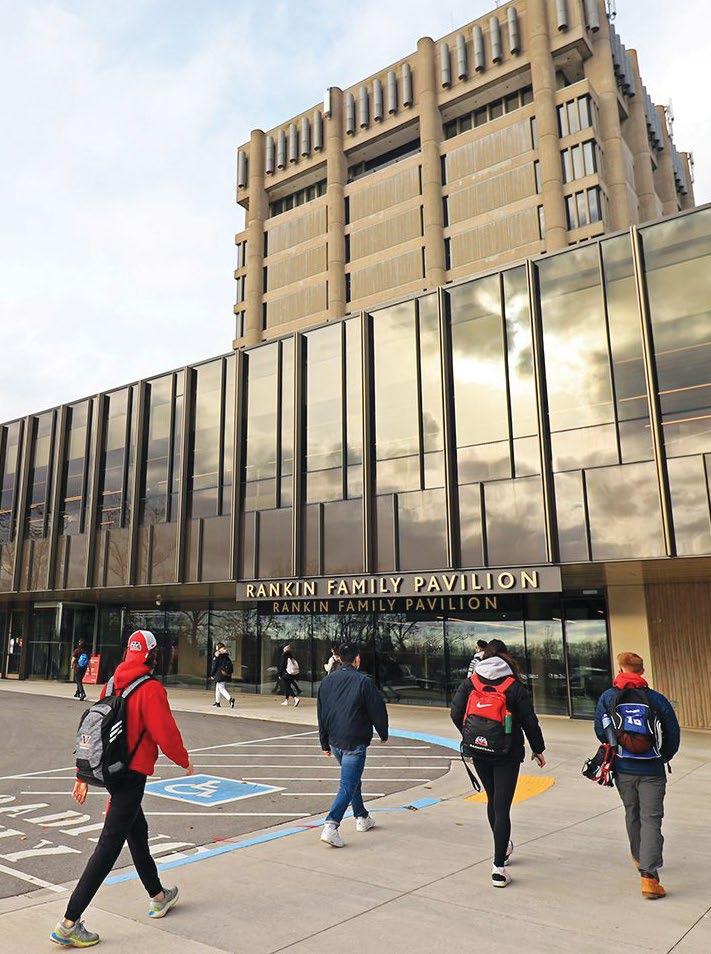
2. The interest coverage ratio measures the ability to fund interest charges from cash generated through operations. It remains above the guidance of 2.00 set by the Board of Trustees and above the ratio of 2.50 considered to be the minimum standard by the University’s credit rating agency, Dominion Bond Rating Service (DBRS) Morningstar, for Brock’s current credit rating of A high.
3. The viability ratio is essentially how much of the institution’s debt could be paid off with expendable resources. The average institution in our category could pay off all of their debt with expendable resources. Brock can pay off 39 per cent and therefore is comparably more vulnerable to unplanned events. The increase in this ratio in 2021-22 is the result of positive fiscal performance.
4. The net operating revenues ratio provides an indication of the extent to which we are generating positive cash flows in the long run to be financially sustainable.
68 2021-22 Annual Report REVIEWING THE NUMBERS
5. The employee future benefits per student metric acknowledges certain obligations are owed to certain employees in the future when they retire or cease employment. The negative balance here represents the fact that the obligation is larger than the actual cash set aside to pay these benefits. Despite the fact that we are in a deficit position, Brock compares favourably to our peers on this metric.
Our debt
Figure 71 details the current and projected external debt of the University, which is within financial metric ranges of the University’s current credit rating.
6. The endowment per student is an indicator of external support for the institution. Endowments provide relief to the operating budget as a source of additional funding to support areas of the institution’s mission. Our endowment per student has seen some growth but still remains less than our peers.
Our metrics have been improving over the past seven years, which is a positive sign and the result of a lot of hard work by everyone in the University community.
The comparative April 2022 figures of the other universities in the comprehensive category were not available at the time of writing this annual report.
DBRS Morningstar maintained Brock’s credit rating on March 3, 2022, with the Issuer Rating and Senior Unsecured Debentures rating of “A (high)”, and changed our trend from “Negative” to “Stable.” The trend changed to “Negative” last year based on DBRS Morningstar’s understanding that Brock had been disproportionately affected by the Coronavirus (COVID-19) pandemic as a result of increased competition for domestic students. This, in turn, resulted in a weaker enrolment outlook. The positive change back to “Stable Trending” reflects DBRS Morningstar’s view that Brock’s enrolment forecast has modestly improved and, combined with responsive management, will lead to an improvement in financial risk metrics relative to previous expectations. Figure 71:
Marilyn I. Walker School of Fine and Performing Arts (MIWSFPA) 15,960 15,240 14,520 2020 Bond and Scotia loan 14,400 139,400 139,400 139,400 139,400 125,000 Total debt 149,038 146,682 144,224 142,257 $265,295 $263,210 255,564 252,841 235,575 Total student FFTE (1) 20,086 20,303 20,548 21,597 21,896 21,689 22,475 22,980 23,090 Total debt/FFTE (in dollars)(1) $7,420 $7,225 $7,019 $6,587 $12,116 $12,136 $11,371 $11,003 $10,202
Debt reduction strategy
Sinking fund – 2005 Bond 6,413 6,696 7,370 7,607 8,843 8,437 8,859 9,302 10,172
Sinking fund – 2020 Bond 1,532 3,107 4,797 7,480
Debt repayment reserve 2,895 4,457 6,753 384 1,884 3,153
M. Walker donation – MIWSFPA 5,326 5,470 5,617
Other donations – MIWSFPA 717 851 932
Total assets for debt reduction 15,351 17,474 20,672 7,991 10,727 13,122 11,966 14,099 17,652
Net debt 133,687 129,208 123,552 134,266 254,568 250,088 243,598 238,742 217,923
Net debt/FFTE (in dollars)(1) $6,656 $6,364 $6,013 $6,217 $11,626 $11,531 $10,839 $10,389 $9,438
(1) Fiscal full-time enrolment (FFTE). For a definition, refer to page 88 of the 2022-23 Budget Report.
2021-22 Annual Report REVIEWING THE NUMBERS 69
($000s) Unless otherwise noted Actual Forecast April 30, 2017 April 30, 2018 April 30, 2019 April 30, 2020 April 30, 2021 April 30, 2022 April 30, 2023 April 30, 2024 April 30, 2025 2005 Bond 93,000 93,000 93,000 93,000 93,000 93,000 93,000 93,000 93,000 Roy and Lois Cairns Health and Bioscience Research Complex 24,863 24,109 23,319 22,491 21,624 20,715 Loan renewal 14,333 12,968 11,561 Residence 15,215 14,333 13,385 12,366 11,271 10,095 8,831 7,473 6,014
Outstanding debt
The existing sinking fund for the Series A Debenture issued in 2005 continues to trend ahead of schedule due to strong investment returns despite negative returns in fiscal 202122. As at April 30, 2022, the balance of the sinking fund was $8.44 million, which exceeds the expected value of $7.69 million based on the growth schedule for the fund. The additional funding is due to a fund rate of return since inception of 6.9 per cent compared to the 5.0 per cent required rate of return. A second sinking fund was also established in 2021-22 to fund the repayment of the Series B 2020 Debenture issued in 2020. The funding of this sinking fund was made at fiscal year-end; therefore, no gains or losses were recorded in this fund.
In May 2022, Brock will acquire a property located near the main campus to support future growth needs of the University. This acquisition is being financed through a loan that will be secured in fiscal 2022-23.
Pension plan
The actuarial valuation on the pension plan completed as at Jan. 1, 2020 indicated the plan was 98 per cent funded on a going-concern basis (96 per cent as at July 2017 valuation) and 106 per cent on a solvency basis (105 per cent as at July 2017 valuation). The going concern deficit improved mainly due to strong investment returns, offset by new legislation to fund a provision for adverse deviation (Pfad), which is a requirement for all single employer sponsored pension plans. The actuary sets the expected rates of returns based on industry best practices guided by the Canadian Institute of Actuaries. The University has no control or influence over these assumptions used by the actuary. The going concern deficit of $12.7 million ($17.9 million as at July 2017 valuation) has required special payments into the plan of $1.46 million and current service cost payments for the plan of $14.53 million for a total cost to the University of $15.99 million annually. Employees also contribute to the money purchase component of the plan (defined contribution) an additional $7.99 million, resulting in an employer to employee funding ratio of 2.0 to 1.0. An updated valuation is required in fiscal 2022-23 where a decision to return to the Pension fiscal year-end June 30th valuation date or repeat the off-cycle valuation date of Jan. 1, 2023 will be required.
Additional information on the pension plan may be found at brocku.ca/human-resources/pension/

70 2021-22 Annual Report
REVIEWING THE NUMBERS
Net assets available for benefits ($000s) Returns Figure 72: Pension Plan as of June 30 pension year end ($000s) 2014 2015 2016 2017 2018 2019 2020 2021 401,731 437,508 449,411 481,174 515,006 561,168 595,224 653,618 15.8% 9.5% 3.1% 9.7% 8.4% 8.3% 7.5% 12.5%
Endowment summary
Figure 73: Endowment activity
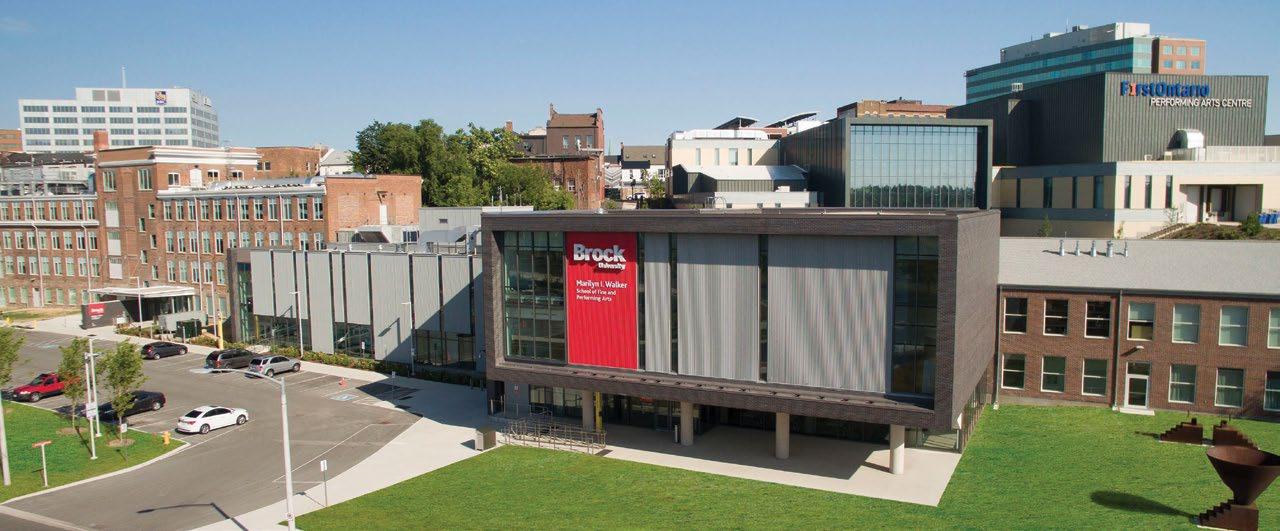
71 2021-22 Annual Report REVIEWING THE NUMBERS
The endowments of the University continue to grow. Figure 73 summarizes the activity of the last six years. Figure 74 details the Top 10 endowments by size of investments as of April 30, 2022.
2021-22 Actual 2020-21 Actual 2019-20 Actual 2018-19 Actual 2017-18 Actual
Actual
123,810
Spending
Investment
New
722
Ending
119,025
($000s)
2016-17
Opening endowment
103,896 107,026 96,671 93,697 83,098
(3,180) (3,091) (2,929) (2,464) (2,396) (1,999)
income and unrealized (loss)/gain (2,327) 19,893 (1,553) 10,932 4,099 11,145
donations
3,112 1,352 1,887 1,271 1,453
endowment
123,810 103,896 107,026 96,671 93,697
Amount ($000s) Name Purpose 20,166 Marilyn I. Walker SFPA Fund Supports the MIWSFPA 8,835 The Harrison-Thompson Bursary Trust Supports Undergraduate Awards 3,356 The Joyce Foundation Bursary Supports Undergraduate Awards 3,237 Dr. Gerald B. Mitchell Fund in Experiential Learning Supports Research, Student Experiences and Programming 2,767 VP Research Discretionary Fund VP Research Discretionary 2,200 Dr. and Mrs. Moriyama Graduate Fellowship Fund Supports Graduate Awards 2,110 Bluma Appel Entrance Scholarship For Excellence Supports Graduate Awards 1,702 Luigi and Amalia Setacci Award Supports
1,577 Ruth Evelyn Williamson Estate Supports
1,550 Provost
Enhancement Fund Provost
Figure 74: Top 10 endowments (2021-22 Actual)
Undergraduate Awards
Undergraduate Awards
Discretionary
Discretionary
REVIEWING THE NUMBERS
2021-22 Annual Report
Capital investments
In total, the University purchased $56.4 million in capital additions during 2021-22. These additions represent investments in facilities and information technology supporting a number of projects, including investments in the construction of Residence 8, the Learning Management System, classroom modernization and many other projects, as well as other smaller capital items such as furniture and computers. Typically, one of the main sources of funding for these projects, other than external debt, donations and government grants, was from the capital and infrastructure projects and reserves fund (capital fund). As detailed in Figure 75, $13.9 million of funding from the capital fund supported the information technology capital purchases ($2.0 million) and facilities management capital purchases ($11.8 million) during the year.

Figure 75 illustrates the 2021-22 activity of the capital fund, which makes up a component of the internally restricted net asset balance in the audited NFPS Financial Statements. During 2021-22, $15.1 million was transferred into the fund from operating. In year, an additional $1.1 million in funding was added to the fund from the Strategic Reserves for the renovation of the Nursing lab to support the increased enrolment in the nursing program, and $0.04 million from endowments to support the student information system.
The key to the capital and infrastructure projects and reserves fund is that funding transferred into it is held in reserve at year-end for spending the following year. This recognizes that capital and related projects can often span one or more years and could have timing delays due to planning or regulatory requirements.
Figure 75: Activity of the capital and infrastructure projects and reserves fund ($000s)
Facilities Management (FM) Projects Information Technology Services (ITS) Projects
Total Capital and Infrastructure Projects and Reserves
Opening Balance (May 1, 2021) 14,791 1,746 16,537
Funding from operating 10,740 4,362 15,102
Funding from strategic reserve 1,100 1,100
Funding from endowments 44 44
In-year spending (capitalized) (11,837) (2,014) (13,851)
In-year spending (not capitalized)* (102) (1,842) (1,944)
Ending Balance (April 30, 2021) 14,692 2,296 16,988
* This spending, although significant to the University and part of the capital and related projects budget, does not meet the requirements to be capitalized in accordance with accounting standards for not-for-profits.
72
University Risk Management
University Risk Management (URM) continues to evolve and mature at Brock. URM helps inform decision-making and support the achievement of the University’s strategic objectives and priorities through the identification, assessment and management of principal risks. Brock’s URM program does not seek to eliminate risk. Rather, the aim of URM is to identify and understand both risks and opportunities and develop appropriate strategies – including mitigation and optimization –to help achieve the University’s goals.
Adapted from best practices and international standards, Brock’s principal risk assessment process below facilitates a structured approach for risk-informed decision-making and promoting innovative and collaborative solutions in support of Brock’s strategic plan. URM must be fluid to adapt to the ever-changing environment and complex university landscape. Through the leadership and commitment of the University, URM is positioned to continue to support the University in achieving objectives.
Risk
73 2021-22 Annual Report REVIEWING THE NUMBERS
management
Scope • Context • Criteria Risk identification Risk analysis Risk evaluation Risk assessment Risk treatment Recording and reporting Co m munication and consultatio n Monitoring and re view
process
Figure 76
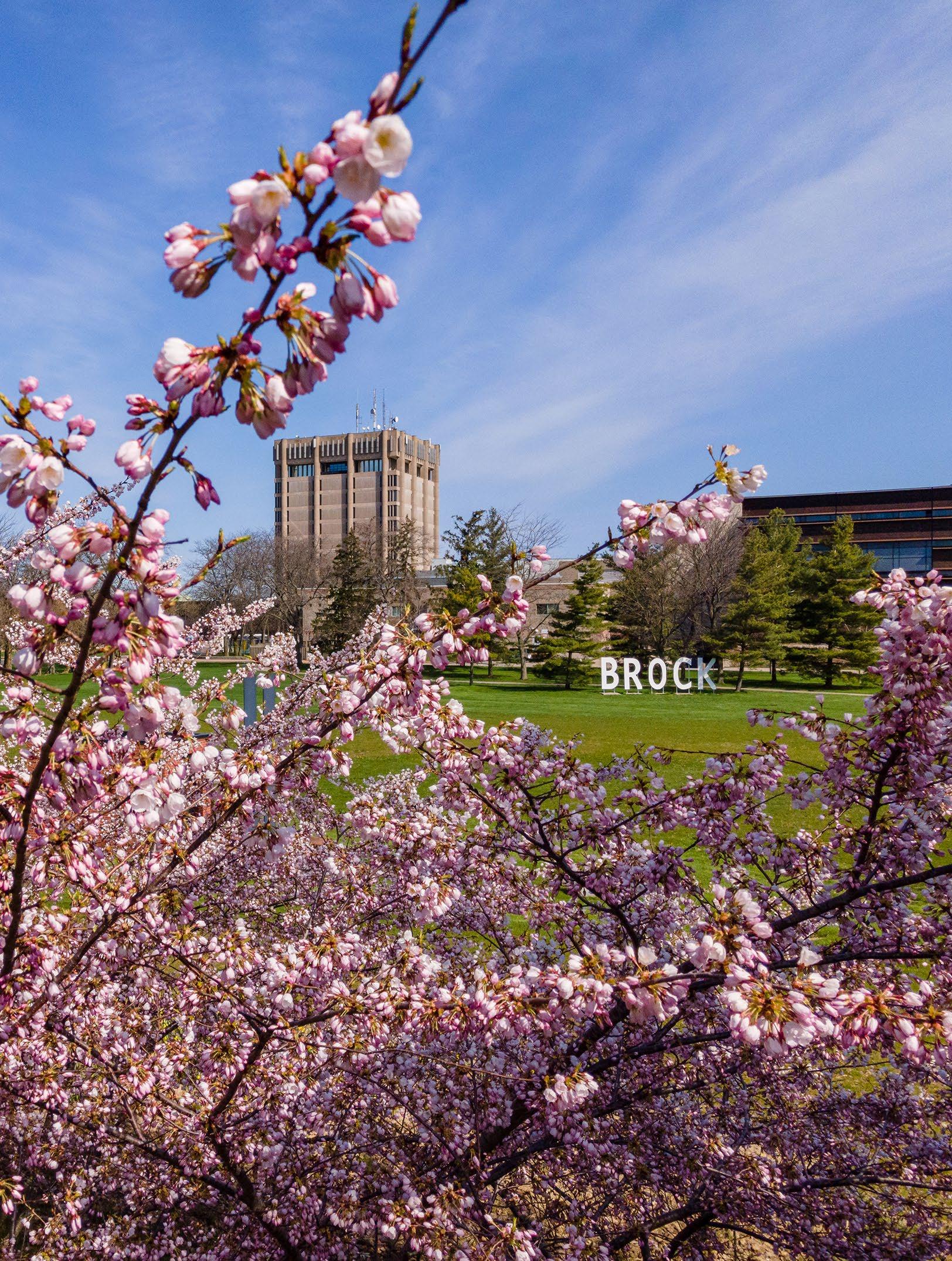
74
Financial Statements of BROCK UNIVERSITY
Year ended April 30, 2022
Statement of Administrative Responsibility


The Administration of Brock University is responsible for the preparation of the financial statements, the notes and all other financial information contained in this annual report.
The Administration has prepared the financial statements in accordance with Canadian accounting standards for not-for-profit organizations. The Administration believes that the financial statements present fairly the University’s financial position as at April 30, 2022 and the results of its operations for the year then ended.
In fulfilling its responsibilities and recognizing the limits inherent in all systems, the Administration has developed and maintains a system of internal control designed to provide reasonable assurance that University assets are safeguarded from loss and that the accounting records are a reliable basis for the preparation of the financial statements.
The Board of Trustees is responsible for ensuring that the Administration fulfills its responsibilities for financial reporting and is ultimately responsible for reviewing and approving the financial statements. The Board of Trustees carries out its responsibility for review of the financial statements principally through the Audit Committee. The members of the Audit Committee are not officers or employees of the University. The Audit Committee meets with the Administration, as well as the external auditors, to discuss the results of audit examinations and financial reporting matters and to satisfy itself that each party is properly discharging its responsibilities. The auditors have full access to the Audit Committee with and without the presence of the Administration.
The financial statements for the year ended April 30, 2022 have been reported on by KPMG LLP, Chartered Professional Accountants, Licensed Public Accountants, the auditors appointed by the Board of Trustees. The auditors’ report outlines the scope of their audit and their opinion on the financial statements.
Wells, Ph.D..
Interim President and Vice-Chancellor
Provost and Vice-President Academic
Tonnos, MBA, CPA, CGA Chief Financial Officer & Associate VicePresident Financial Services

FINANCIAL STATEMENTS 75
2021-22 Annual Report
Lynn
2021-22
FINANCIAL STATEMENTS
Ken Chan, MBA, MFAcc, ICD.D Vice-President, Administration
Annual Report
Joshua
KPMG LLP

Vaughan Metropolitan Centre 100 New Park Place, Suite 1400 Vaughan ON L4K 0J3 Canada Tel 905-265-5900 Fax 905-265-6390
INDEPENDENT AUDITORS' REPORT
To the Trustees of Brock University
Opinion
We have audited the accompanying financial statements of Brock University (the University), which comprise: the statement of financial position as at April 30, 2022 the statement of operations for the year then ended the statement of changes in net assets for the year then ended the statement of cash flows for the year then ended and notes to the financial statements, including a summary of significant accounting policies (Hereinafter referred to as the "financial statements").
In our opinion, the accompanying financial statements present fairly, in all material respects, the financial position of the University as at April 30, 2022, and its results of operations, its changes in net assets and its cash flows for the year then ended in accordance with Canadian accounting standards for not-for-profit organizations.
Basis for Opinion
We conducted our audit in accordance with Canadian generally accepted auditing standards. Our responsibilities under those standards are further described in the "Auditors' Responsibilities for the Audit of the Financial Statements" section of our auditors' report.
We are independent of the University in accordance with the ethical requirements that are relevant to our audit of the financial statements in Canada and we have fulfilled our other ethical responsibilities in accordance with these requirements.
We believe that the audit evidence we have obtained is sufficient and appropriate to provide a basis for our opinion.
76 2021-22 Annual Report FINANCIAL STATEMENTS Independent Auditor’s Report
member
LLP.
KPMG LLP, an Ontario limited liability partnership and member firm of the KPMG global organization of independent
firms affiliated with KPMG International Limited, a private English company limited by guarantee. KPMG Canada provides services to KPMG
Responsibilities of Management and Those Charged with Governance for the Financial Statements
Management is responsible for the preparation and fair presentation of the financial statements in accordance with Canadian accounting standards for not-for-profit organizations, and for such internal control as management determines is necessary to enable the preparation of financial statements that are free from material misstatement, whether due to fraud or error.

In preparing the financial statements, management is responsible for assessing the University's ability to continue as a going concern, disclosing as applicable, matters related to going concern and using the going concern basis of accounting unless management either intends to liquidate the University or to cease operations, or has no realistic alternative but to do so.
Those charged with governance are responsible for overseeing the University's financial reporting process.
Auditors' Responsibilities for the Audit of the Financial Statements
Our objectives are to obtain reasonable assurance about whether the financial statements as a whole are free from material misstatement, whether due to fraud or error, and to issue an auditors' report that includes our opinion.
Reasonable assurance is a high level of assurance, but is not a guarantee that an audit conducted in accordance with Canadian generally accepted auditing standards will always detect a material misstatement when it exists.
Misstatements can arise from fraud or error and are considered material if, individually or in the aggregate, they could reasonably be expected to influence the economic decisions of users taken on the basis of the financial statements.
As part of an audit in accordance with Canadian generally accepted auditing standards, we exercise professional judgment and maintain professional skepticism throughout the audit.
We also:
Identify and assess the risks of material misstatement of the financial statements, whether due to fraud or error, design and perform audit procedures responsive to those risks, and obtain audit evidence that is sufficient and appropriate to provide a basis for our opinion.
The risk of not detecting a material misstatement resulting from fraud is higher than for one resulting from error, as fraud may involve collusion, forgery, intentional omissions, misrepresentations, or the override of internal control.
77 2021-22 Annual Report FINANCIAL STATEMENTS
Page 2
Obtain an understanding of internal control relevant to the audit in order to design audit procedures that are appropriate in the circumstances, but not for the purpose of expressing an opinion on the effectiveness of the University's internal control.
Evaluate the appropriateness of accounting policies used and the reasonableness of accounting estimates and related disclosures made by management.

Conclude on the appropriateness of management's use of the going concern basis of accounting and, based on the audit evidence obtained, whether a material uncertainty exists related to events or conditions that may cast significant doubt on the University's ability to continue as a going concern. If we conclude that a material uncertainty exists, we are required to draw attention in our auditors' report to the related disclosures in the financial statements or, if such disclosures are inadequate, to modify our opinion. Our conclusions are based on the audit evidence obtained up to the date of our auditors' report. However, future events or conditions may cause the University to cease to continue as a going concern.

Evaluate the overall presentation, structure and content of the financial statements, including the disclosures, and whether the financial statements represent the underlying transactions and events in a manner that achieves fair presentation.
Communicate with those charged with governance regarding, among other matters, the planned scope and timing of the audit and significant audit findings, including any significant deficiencies in internal control that we identify during our audit.
Vaughan, Canada
June 23, 2022
2018-19 Annual Report FINANCIAL STATEMENTS 78 2021-22 Annual Report FINANCIAL STATEMENTS
Page 3
Chartered Professional Accountants, Licensed Public Accountants
BROCK UNIVERSITY
Statement of Financial Position
As at April 30, 2022, with comparative information for 2021 (in thousands of dollars)
Assets
Current assets:
Cash and cash equivalents (note 2) $98,027 $120,741 Accounts receivable 33,287 30,598 Government grants receivable 5,842 4,770 Prepaid expenses and other assets 838 441 Inventories 1,409 1,402 139,403 157,952 Restricted investments (note 3) 207,159 206,666 Capital assets (note 4) 511,205 481,711 Employee future benefits asset (note 9) - 801
$857,767 $847,130
Liabilities and Net Assets
Current liabilities:
Accounts payable and accrued liabilities (note 16) $38,568 $44,364 Deferred revenue 43,766 45,735 Deferred contributions (note 5) 13,128 12,244 Current portion of long-term debt (note 6) 21,978 2,085 117,440 104,428
Long-term debt (note 6) 23,232 45,210 Debenture payable (note 7) 214,940 214,872 Deferred capital contributions (note 8) 216,335 194,224 Employee future benefits obligation (note 9) 33,719 30,501

Total liabilities 605,666 589,235

Net assets: Endowments (note 10) 119,025 123,810 Invested in capital assets (note 11) 82,670 86,920 Internally restricted (note 12) 84,022 76,763 Employee future benefits (33,719) (29,700) Unrestricted 103 102 252,101 257,895
Commitments (note 13) Contingencies (notes 14 and 15) Subsequent events (note 20)
$857,767 $847,130
The accompanying notes are an integral part of these financial statements.
On behalf of the Board: Trustee
Trustee
79 2021-22 Annual Report FINANCIAL STATEMENTS 2022 2021
BROCK UNIVERSITY
Statement of Operations
Year ended April 30, 2022, with comparative information for 2021 (in thousands of dollars)
Revenues:
Student fees
2022 2021
$187,773 $186,657
Government grants 97,338 103,943
Ancillary operations 31,192 9,274
Sales and services 14,018 11,338
Other revenues for restricted purposes 4,938 3,987
Investment income 1,479 4,676
Research grants for restricted purposes (note 17) 13,173 11,778
Gain on sale of assets 3,297 1,889
Amortization of deferred capital contributions (note 8) 8,812 7,902 362,020 341,444
Expenses:
Salaries and benefits 229,489 220,557
Operating expenses 39,776 33,476
Scholarships, fellowships and bursaries 30,230 27,562
Expendable equipment, repairs and maintenance 11,587 10,066
Utilities and taxes 6,393 5,880
Interest on long-term debt 10,543 10,477
Cost of sales 4,366 4,520
Amortization of capital assets 26,877 21,861 359,261 334,399
Excess of revenues over expenses 2,759 7,045
Net transfers (to) from internally restricted net assets (7,274) (35,325)
Net transfers from (to) invested in capital assets 4,250 28,521
Net transfers from (to) employee future benefits 266 (232)
Change in unrestricted net assets in the year (2,758) (7,036)
Unrestricted net assets, beginning of year 102 93
Unrestricted net assets, end of year $103 $102
The accompanying notes are an integral part of these financial statements.
80 2021-22 Annual Report FINANCIAL
STATEMENTS
BROCK UNIVERSITY Statement of Changes in Net Assets
Year ended April 30, 2022, with comparative information for 2021 (in thousands of dollars)
April 30, 2022
Employee future benefits Endowments
(note 10)
Invested in capital assets (note 11)
Internally restricted (note 12) Unrestricted Total
Net assets, beginning of year $(29,700) $123,810 $86,920 $76,763 $102 $257,895 Excess of revenues over expenses (expenses over revenues) - - (20,210) - 22,969 2,759
Change in internally restricted net assets - - - 7,274 (7,274) -
Net change in investment in capital assets (note 11(b)) - - 15,960 - (15,960) -
Actuarial loss in employee future benefits (3,753) - - - - (3,753)
Net current service charge in employee future benefits (266) - - - 266 -
Change in endowment net assets (note 10(a)) - (4,785) - (15) - (4,800)
Net assets, end of year $(33,719) $119,025 $82,670 $84,022 $103 $252,101
30, 2021
Net assets, beginning of year $(29,576) $103,896 $115,441 $41,438 $93 $231,292
Excess of revenues over expenses (expenses over revenues) - - (9,672) - 16,717 7,045
Change in internally restricted net assets - - - 35,325 (35,325) -
Net change in investment in capital assets (note 11(b)) - - (18,849) - 18,849 -
Actuarial loss in employee future benefits (356) - - - - (356)
Net current service charge in employee future benefits 232 - - - (232) -
Change in endowment net assets (note 10(a)) - 19,914 - - - 19,914
Net assets, end of year $(29,700) $123,810 $86,920 $76,763 $102 $257,895
The accompanying notes are an integral part of these financial statements.
81 2021-22 Annual Report FINANCIAL STATEMENTS
April
Employee future benefits Endowments (note 10) Invested in capital assets (note 11)
Internally restricted (note 12) Unrestricted Total
BROCK UNIVERSITY
Statement of Cash Flows
Year ended April 30, 2022, with comparative information for 2021 (in thousands of dollars)
Cash provided by (used in):
Operating activities:
Excess of revenues over expenses $2,759 $7,045
Add (deduct) non-cash items: Gain on sale of assets (3,297) (1,889)
Amortization of gain on sale of assets (204) (146) Amortization of capital assets 26,877 21,861 Amortization of deferred capital contributions (8,812) (7,902) Amortization of deferred charges on debenture payable 68 (310) 17,391 18,659
Net change in non-cash working capital balances related to operations:
Increase in accounts receivable (3,689) (6,148) (Increase) decrease in government grants receivable (1,072) 13
Increase in prepaid expenses and other assets (397) (48) (Increase) decrease in inventories (7) 134 (Decrease) increase in accounts payable and accrued liabilities (5,796) 5,032
Increase in deferred revenue 1,085 8,198 Increase in deferred contributions 884 2,644
Net current service charge in employee future benefits 266 (232) (8,726) 9,593
Cash provided by operating activities 8,665 28,252
Financing activities:
Contributions restricted for capital purposes 30,923 5,788 Increase in debenture payable - 125,000 Repayment of long-term debt (2,085) (1,962)
Cash provided by financing activities 28,838 128,826
Investing activities:
Net change in restricted investments (493) (54,888) Purchase of capital assets (58,531) (61,730)
Net proceeds from sale of assets 3,592 2,021 Change in endowment net assets (4,785) 19,914
Cash used in investing activities (60,217) (94,683) (Decrease) increase in cash (22,714) 62,395 Cash and cash equivalents, beginning of year 120,741 58,346
Cash and cash equivalents, end of year $98,027 $120,741
The accompanying notes are an integral part of these financial statements.
82 2021-22 Annual Report FINANCIAL STATEMENTS 2022 2021
BROCK UNIVERSITY
Notes to Financial Statements
Year ended April 30, 2022
Incorporated in 1964, Brock University (the “University” or “Brock”) flourishes through the scholarly, creative, and professional achievement of its students, faculty and staff. Offering a range of undergraduate and graduate programs, Brock fosters teaching and research of the highest quality. As a diverse and inclusive community, the University contributes positively to Canada and beyond through our imagination, innovation and commitment.
These financial statements reflect the assets, liabilities, net assets, revenue, expenses and other transactions of all of the operations controlled by the University. Accordingly, these financial statements include the academic, administrative and other operating expenditures funded by fees, grants and other general revenue; restricted purpose funds, including endowment, research and trust; and the ancillary operations, such as residence and parking.
The University is a charitable organization and, as such, is exempt from income taxes under the Income Tax Act (Canada).
1. Significant accounting policies:
These financial statements have been prepared in accordance with Canadian Accounting Standards for Not-For-Profit Organizations in Part III of the CPA Canada Handbook. The financial statements include the financial results of the University and its investment in a joint venture (note 1(o) and note 19).
(a) Cash and cash equivalents:
Cash equivalents are held for the purpose of meeting short-term commitments and are readily convertible to a known amount of cash and are subject to an insignificant amount of risk of changes in value. Cash equivalents include money market funds and investments with maturities of three months or less from the date of acquisition. Cash and cash equivalents are valued at fair value.
(b) Inventories:
Inventories are stated at the lower of cost, which is determined using the weighted average cost approach and net realizable value.
(c) Investments: Investments are recorded at fair value.
(d) Capital assets:
Purchased capital assets are recorded at cost less accumulated amortization. Contributions of capital assets are capitalized at fair market value at the date of contribution. Capital assets are amortized on a straight-line basis using the following annual rates:
Asset Rate
Buildings
Furnishings and equipment
2.5% to 10%
10% to 33 1/3%
Library books 20%
Construction costs are capitalized as work progresses and amortization commences as work is substantially completed. The carrying amount of capital assets is tested for recoverability whenever events or changes in circumstances indicate that the carrying amount may not be recoverable. An impairment loss is recognized in the Statement of Operations when the asset’s carrying amount is not recoverable and exceeds its fair value.
83 2021-22 Annual Report FINANCIAL STATEMENTS
(e) Works of art:
Contributed works of art are recorded as revenue and expense, at fair market value, at the date of contribution. If the fair market value is not determinable, the contribution is recorded at a nominal amount. Artwork purchases are expensed as acquired.
(f) Endowments:
Contributions restricted for endowments consist of restricted donations received by the University and donations internally designated by the Board of Trustees, in the exercise of its discretion. The endowment principal is required to be maintained intact. The investment income generated from endowments must be used in accordance with the various purposes established by donors or the Board of Trustees. The University ensures, as part of its fiduciary responsibilities, that all funds received with a restricted purpose are expended for the purpose for which they were provided.
Investment income on endowments that is available for spending at the discretion of the University or is available for spending as the conditions established by the donor have been met has been recorded in the Statement of Operations. University policy has been established with the objective of protecting the real value of the endowments by having an overall investment objective for endowments to earn, over time, a rate of return at least equal to the total of inflation plus spending and the costs of administering the funds. The spending rate is reviewed annually. Investment income in excess of administration costs and spending allocations will be added to capital. In the case of endowments where the original donation adjusted for inflation is higher than the market value of the fund, spending may be temporarily suspended in order to preserve donor capital.
(g) Internally restricted net assets:
The University internally restricts the use of portions of its unrestricted net assets for specific future use. Transfers to internally restricted net assets only occur once authorized by the Board of Trustees. When expenses are incurred, expenses are charged to the Statement of Operations and the balance of internally restricted net assets is reduced accordingly.
(h) Revenue recognition:
The University follows the deferral method of accounting for contributions. Unrestricted contributions are recognized as revenue when received or receivable, if the amount to be received can be reasonably estimated and collection is reasonably assured. Pledged donations are recognized on a cash basis since pledges are not legally enforceable claims. Contributions externally restricted for purposes other than endowment are deferred and recognized as revenue in the year in which the related expenses are recognized. Contributions restricted for the purchase of capital assets are deferred and amortized into revenue on a straight-line basis at a rate corresponding with the amortization rate for the related capital asset. Endowment contributions are recognized as direct increases in net assets in the year in which they are received. Student fees are recognized as revenue when courses and seminars are held. Sales and services and ancillary revenue is recognized at the point of sale or when the service has been provided.
84 2021-22 Annual Report FINANCIAL
STATEMENTS
(i) Employee future benefits:
The University provides pension benefits to employees primarily through a hybrid pension plan. Under this arrangement, the University and employees are required to make contributions based on a specific percentage of the employee’s earnings. The amount of pension benefits provided to employees is based on the accumulation of contributions and investment earnings thereon, when the employee retires, subject to a guaranteed minimum benefit amount. Certain faculty are also members of the Teacher’s Superannuation Fund, a multi-employer defined benefit plan.
The University provides other non-pension benefits to most of its employees, including retiree medical and dental benefits until the age of 65, accumulating sick leave benefits, pre-retirement leave benefits and for specific employees a health-care spending account.
The University accrues its benefit obligations for these employee future benefits as the employees render the services necessary to earn them. The actuarial determination of the accrued benefit obligations for these employee future benefits uses the projected benefit method prorated on service. For purposes of measuring the benefit obligations, the funding valuation is used for the pension and the accounting valuation is used for the non-pension benefits.
The University recognizes the amount of benefit obligations net of the fair value of plan assets in the Statement of Financial Position. Current service and finance costs are expensed during the year, while remeasurement and other items, representing the total of the difference between actual and expected return on plan assets, actuarial gains and losses, and past service costs, are recognized as a direct increase or decrease in net assets within the employee future benefits fund. In years between valuations, a roll-forward technique is used to estimate the accrued benefit obligations.
The most recent actuarial valuation of the pension plan for funding purposes was as of January 1, 2020 and the next required valuation will be as of January 1, 2023.
The most recent actuarial valuation of the non-pension benefits for accounting purposes was as of April 30, 2022.
(j) Derivative financial instrument and hedge accounting:
The University is party to interest rate swap agreements used to manage the exposure to market risks from changing interest rates. The University applies hedge accounting for its interest rate swaps. Payments and receipts under the interest rate swaps are recognized as adjustments to interest expense on long-term debt.
The University’s policy is not to utilize derivative financial instruments for trading or speculative purposes.
(k) Pledges:
Pledges are recorded as revenue on a cash basis and accordingly are not recognized as an asset in the Statement of Financial Position. The total amount of pledges outstanding is approximately $14,496,000 (2021 –$6,378,000) and is expected to be received as follows:
85 2021-22 Annual Report FINANCIAL STATEMENTS
STATEMENTS
(000’s) 2022 2021
2022 $- $790 2023 1,669 252 2024 886 234 2025 859 201 2026 709 71 2027 577Thereafter 9,796 4,830 $14,496 $6,378
(l) Financial instruments:
Financial instruments are recorded at fair value on initial recognition. Freestanding derivative instruments that are not in a qualifying hedging relationship and equity instruments that are quoted in an active market are subsequently measured at fair value. All other financial instruments are subsequently recorded at cost or amortized cost, unless management has elected to carry the instruments at fair value.
Transaction costs incurred on the acquisition of financial instruments measured subsequently at fair value are expensed as incurred. All other financial instruments are adjusted by transaction costs incurred on acquisition and financing costs, which are amortized using the effective interest rate method.
Financial assets are assessed for impairment on an annual basis at the end of the fiscal year if there are indicators of impairment. If there is an indicator of impairment, the University determines if there is a significant adverse change in the expected amount or timing of future cash flows from the financial asset. If there is a significant adverse change in the expected cash flows, the carrying value of the financial asset is reduced to the highest of the present value of the expected cash flows, the amount that could be realized from selling the financial asset or the amount the University expects to realize by exercising its right to any collateral. If events and circumstances reverse in a future period, an impairment loss will be reversed to the extent of the improvement, not exceeding the initial carrying value.
(m) Contributed services and materials:
Volunteers contribute an indeterminable number of hours per year as well as various materials used by the University in carrying out the provision of services. Because of the difficulty of determining their fair value, contributed services and materials are not recognized in these financial statements.
(n) Use of estimates:
The preparation of financial statements in conformity with Canadian Accounting Standards for Not-For-Profit organizations requires management to make estimates and assumptions that affect the reported amounts of assets and liabilities and the disclosure of contingent assets and liabilities at the date of the financial statements and the reported amounts of revenue and expenses for the period reported. Items subject to such estimates and assumptions include the carrying amount of capital assets, valuation allowances for receivables, valuation of derivative financial instruments, accrued liabilities and obligations related to employee future benefits. Actual results could differ from those estimates. These estimates are reviewed periodically, and, as adjustments become necessary, they are reported in income in the year in which they become known.
86 2021-22 Annual Report FINANCIAL
(o) Joint ventures:
Joint ventures are accounted for under the proportionate consolidation method. The University accounts for its interest in the joint venture on a line by line basis in the financial statements and eliminates any inter-organizational transactions and balances. Accounting policies of the joint venture are conformed to those of the University before it is proportionately consolidated.
2. Cash and cash equivalents:
The fair values of the cash and cash equivalents are comprised of:
(000’s) 2022 2021
Cash and cash equivalents $93,245 $103,252 Held for future capital projects Cash and cash equivalents 4,782 17,489 $98,027 $120,741
3. Restricted investments:
The fair value of investments are as follows:
(000’s) 2022 2021
Invested for endowments
Cash and cash equivalents $270 $194
Walter Scott & Partners Global Equity Fund 34,300 40,265 Mawer Global Equity Pooled Fund 37,005 38,119 Barings Global High Yield Credit Strategies Fund 23,444 23,976 PH&N Core Plus Fixed Income 24,006 21,256 119,025 123,810
Invested for unspent capital projects
Cash and cash equivalents (note 8) 155 1,166
Invested for future loan repayments Mawer Balanced Fund 9,969 8,843
Invested for employee future benefit reserve Mawer Balanced Fund 6,280 6,581
Invested for other restricted purposes
Cash and cash equivalents 71,057 65,537
TD Global Equity Investments 673 729 71,730 66,266 $207,159 $206,666
87 2021-22 Annual Report FINANCIAL STATEMENTS
4. Capital assets:
April 30, 2022 (000’s) Cost Accumulated amortization Net book value
Land
$52,655 $- $52,655
Buildings 704,580 287,689 416,891 Furnishings and equipment 98,588 59,094 39,494 Library books 46,939 44,774 2,165 $902,762 $391,557 $511,205
April 30, 2021 (000’s)
Cost
Accumulated amortization Net book value
Land $54,800 $- $54,800
Buildings 666,587 268,868 397,719 Furnishings and equipment 81,009 53,910 27,099 Library books 46,032 43,939 2,093 $848,428 $366,717 $481,711
Included in buildings and furnishings and equipment is $12,406,000 (2021 –$76,682,000) of construction in progress that was not amortized during the year.
The increase in net book value of capital assets is due to the following:
(000’s) 2022 2021
Balance, beginning of year $481,711 $441,828
Purchase of capital assets funded by deferred capital contributions 31,934 6,007
Purchase of capital assets internally financed 13,875 (11,634)
Purchase of capital assets financed by proceeds of long term debt 12,707 72,261
Sale of Land (2,145) (4,890) Amortization of capital assets (26,877) (21,861) Balance, end of year $511,205 $481,711
5. Deferred contributions:
Deferred contributions represent unspent externally restricted grants and donations for research and other restricted purposes. The changes in the deferred contributions balance are as follows:
(000’s) 2022 2021
Balance, beginning of year $12,244 $9,600
Grants, donations and other expendable funds received 13,753 14,173 Amounts recorded as revenue during the year (12,869) (11,529) Balance, end of year $13,128 $12,244
88 2021-22 Annual Report FINANCIAL
STATEMENTS
6. Long-term debt:
(000’s) 2022 2021
Fixed rate instruments:
Earp student residence: 7.2% loan with certain residences and investments pledged as security, with monthly blended payments of principal and interest of $91, due October 1, 2028
$5,628 $6,284
Lowenberger student residence: 7.2% loan with certain residences and investments pledged as security, with monthly blended payments of principal and interest of $72, due October 1, 2028 4,467 4,987
Roy and Lois Cairns Health and Bioscience Research Complex: 4.69% mortgage loan with monthly blended payments of principal and interest of $159, due June 29, 2022 20,715 21,624
Student Experience Projects: 2.49% interest only payments with the principal repayable in full on or before June 3, 2024 14,400 14,400 45,210 47,295 Less current portion (21,978) (2,085) $23,232 $45,210
Debt maturities:
The following are the future minimum annual debt principal repayments due over the next five fiscal years and thereafter:
(000’s) 2023 $21,978 2024 1,358 2025 15,859 2026 1,567 2027 1,684 Thereafter 2,764 $45,210
(a) Bank credit facility:
The University has available operating lines of credit of $20,000,000 and $5,000,000 which were not utilized at April 30, 2022. The interest rate on the operating lines of credit, when drawn, are the Bank’s Prime lending rate from time to time minus 0.55% and the Bank’s Prime lending rate from time to time, respectively (the prime rate at April 30, 2022 was 3.20%). Amounts are due on demand.
89 2021-22 Annual Report FINANCIAL STATEMENTS
(b) Interest rate swap:
The University has entered into interest rate swap agreements to manage the volatility of interest rates.
The University converted a net notional of $28,000,000 of floating rate long-term debt relating to the Roy and Lois Cairns Health and Bioscience Research Complex.
The fixed rate paid under the interest rate swap is 4.69%. The maturity date of the interest rate swap is the same as the maturity date of the associated long-term debt of June 29, 2022.
The University converted a net notional of $14,400,000 of floating rate long-term debt relating to the Student Experience Projects. The fixed rate paid under the interest rate swap is 2.49%. The maturity date of the interest rate swap is the same as the maturity date of the associated long-term debt of June 3, 2024.
The notional and fair values of the interest rate swap agreements is as follows:
2022 2021 (000’s)
Notional value Fair value Notional value Fair value
Roy and Lois Cairns Health and Bioscience Research Complex $20,714 $20,910 $21,624 $22,535
Student Experience Projects 14,400 14,109 14,400 14,894 $35,114 $35,019 $36,024 $37,429
The fair value of the swaps are determined using the benchmark valuation methodology without consideration for non-performance or counterparty risk.
7. Debenture payable:
(000’s)
2022 2021
Series A debenture payable, bearing interest at 4.967%, $2,309 payable interest only semiannually, due December 14, 2045 93,000 93,000
Deferred refinancing expenses (2,562) (2,616)
Series B debenture payable, bearing interest at 3.033%, $1,896 payable interest only semiannually, due May 17, 2060 125,000 125,000 Deferred refinancing expenses (498) (512) $214,940 $214,872
The fair value of the debenture payable due December 14, 2045 (Series A) is $100,321,000 (2021 – $116,428,000). Fair value has been determined using the market quote of the debenture which as at April 30, 2022 was $107.87 (2021 –$125.19).
The fair value of the debenture payable due May 17, 2060 (Series B) is $91,885,000 (2021 – $114,144,000). Fair value has been determined using the market quote of the debenture which as at April 30, 2022 was $73.51 (2021 – $91.32).
The University has established two internal sinking funds for each of the Series A and Series B debentures and purchased units in the Mawer Balanced Fund with a market value of $8,437,000 (2021 – $8,843,000) and $1,532,000 (2021 – nil) respectively. It is the University’s policy to annually review the sinking fund investment structure and required contributions so that the ultimate proceeds of the investments will be applied against the Series A and B debenture payable.
90 2021-22 Annual Report FINANCIAL
STATEMENTS
8. Deferred capital contributions:
Deferred capital contributions represent the unamortized amount of donations and grants received for the purchase of capital assets. The amortization of deferred capital contributions is recorded as revenue in the Statement of Operations. The changes in the deferred capital contributions balance are as follows:
(000’s)
2022 2021
Balance, beginning of year $194,224 $196,338 Less amortization of deferred capital contributions (8,812) (7,902) Add contributions restricted for capital purposes 30,923 5,788 Balance, end of year $216,335 $194,224
The balance of unamortized capital contributions related to capital assets consists of the following:
(000’s)
2022 2021
Unamortized capital contributions used to purchase assets $216,180 $193,058 Unspent capital contributions 155 1,166 $216,335 $194,224
9. Employee future benefits obligation:
(a) Pension benefit plan:
The University sponsors a hybrid pension plan, which contains both a defined contribution component and a defined benefit component. The defined contribution component of the plan is funded by University and member contributions and provides a benefit to members based on their accumulated account balance. The defined benefit component of the plan is funded by University contributions and provides for a guaranteed minimum benefit. The latest actuarial funding valuation was performed as at January 1, 2020. The next required actuarial funding valuation will be completed on or before January 1, 2023.
The University measured its accrued benefit obligation and fair value of plan assets for accounting purposes as at April 30, 2022. A summary of the financial status of the plan is as follows:
(000’s)
2022 2021
Accrued benefit obligation $632,739 $635,780 Fair value of plan assets 624,951 636,581 Accrued benefit asset $(7,788) $801
91 2021-22 Annual Report FINANCIAL STATEMENTS
The principal actuarial assumptions adopted in measuring the University’s employee future benefits obligation are as follows:
2022 2021
Discount rate on defined benefit costs 5.30% 5.30%
Rate of compensation increases 2.80% – 3.25% 2.80% – 3.25%
Expected long-term rate of return on plan assets 6.00% 6.00%
The contribution and the amount expensed for the University’s pension benefit plans are as follows:
(000’s) 2022 2021
Current service cost (defined contribution) $12,708 $12,639
Current service cost (defined benefit) 1,813 1,829
Unfunded liability (going concern) 1,463 1,741
Total $15,984 $16,209
(b) Other benefit plans:
The University has a number of non-pension future benefits that are available to most of its employees. These non-pension benefits include retiree medical and dental benefits until the age of 65, accumulating sick leave benefits and pre-retirement leave benefits and, for specific employees, a health-care spending account. The latest actuarial accounting valuation was performed as at April 30, 2022.
A summary of the financial status of the plans is as follows:
(000’s)
2022 2021
Accrued benefit obligation $25,931 $30,501
Fair value of plan assets - -
Accrued benefit liability $25,931 $30,501
The University established an internally restricted reserve (note 12) for employee future benefits of $7,867,000 (2021 – $8,168,000).
The principal actuarial assumptions adopted in measuring the University’s employee future benefits obligation are as follows:
2022 2021
Discount rate 4.60% – 5.00% 2.80% – 3.50%
Prescription drug costs 7.15% (2020 – 7.15%) decreasing to 4.00% in and after 2040
Other benefits costs 4.00% 4.00%
Health Care Spending Account 2.00% 2.00%
The expense for the University’s other benefit plans is as follows:
(000’s)
2022 2021
Non-pension defined benefit plans $4,378 $4,651 Non-pension benefit plans 673 729
Total $5,051 $5,380
92 2021-22 Annual Report FINANCIAL STATEMENTS
10. Endowments:
(a) Change in endowment net assets:
The following were recorded directly to endowment net assets:
(000’s) 2022 2021
Contributions restricted for endowments $637 $3,112 Investment income 4,221 6,272 Internally allocated for endowment spending (3,180) (3,091) Unrealized gain (loss) (6,463) 13,621 $(4,785) $19,914
It is the University’s policy to endow any amounts not made available for spending during the fiscal year. These amounts are recorded as a direct increase to endowments as preservation of capital.
(b) Contributions restricted for endowments consist of the following:
(000’s)
2022 2021
Externally endowed $110,714 $115,104 Internally endowed 8,311 8,706 $119,025 $123,810
(c) Ontario Student Opportunity Trust Fund, Phase One:
Externally restricted endowments include grants provided by the Government of Ontario from the Ontario Student Opportunity Trust Fund (“OSOTF”) matching program, Phase One to award student aid as a result of raising an equal amount of endowed donations. The OSOTF represents a portion of the endowment fund.
Schedule of Changes in Expendable Funds Available for Awards:
(000’s) 2022 2021
Expendable funds available for awards, beginning of year $2,097 $1,826 Investment income eligible for expenditures 470 735 Bursaries awarded (471) (464)
Expendable funds available for awards, end of year $2,096 $2,097
Total OSOTF, Phase One, end of year $12,786 $12,705 Number of bursaries awarded 130 130
93 2021-22 Annual Report FINANCIAL STATEMENTS
Schedule of Changes in Endowment Balance based on book and market value:
(000’s)
2022 2021
Market Book Market Book
Endowment balance, beginning of year $15,949 $10,609 $13,984 $10,255
Unrealized (loss) gain for the year (672) - 1,611 -
Investment income less bursaries awarded 83 83 354 354 Endowment balance, end of year $15,360 $10,692 $15,949 $10,609
(d) Ontario Student Opportunity Trust Fund, Phase Two:
Externally restricted endowments include grants provided by the Government of Ontario from the OSOTF matching program, Phase Two to award student aid as a result of raising an equal amount of endowed donations. The OSOTF represents a portion of the endowment fund.
Schedule of Changes in Expendable Funds Available for Awards: (000’s)
2022 2021
Expendable funds available for awards, beginning of year $1,062 $900
Investment income eligible for expenditures 190 286 Bursaries awarded (124) (124)
Expendable funds available for awards, end of year $1,128 $1,062
Total OSOTF, Phase Two, end of year $5,242 $5,140
Number of bursaries awarded 31 31
Schedule of Changes in Endowment Balance based on book and market value:
(000’s)
2022 2021
Market Book Market Book
Endowment balance, beginning of year $6,118 $4,078 $5,363 $3,946
Unrealized (loss) gain for the year (296) - 623 -
Investment income less bursaries awarded 36 36 132 132 Endowment balance, end of year $5,858 $4,114 $6,118 $4,078
(e) Ontario Trust for Student Support:
Externally restricted endowments include grants provided by the Government of Ontario from the Ontario Trust for Student Scholarship (“OTSS”) matching program to award student aid as a result of raising an equal amount of endowment donations to an allocated ceiling. The OTSS represents a portion of the endowment fund.
94 2021-22 Annual Report FINANCIAL
STATEMENTS
Schedule of Changes in Expendable Funds Available for Awards:
(000’s)
2022 2021
Expendable funds available for awards, beginning of year $6,175 $5,338 Investment income eligible for expenditures 1,029 1,563 Bursaries awarded (750) (726)
Expendable funds available for awards, end of year $6,454 $6,175
Total OTSS, end of year $29,064 $28,601 Number of bursaries awarded 401 383
Schedule of Changes in Endowment Balance based on book and market value:
(000’s)
2022 2021 Market Book Market Book
Endowment balance, beginning of year $33,875 $22,424 $29,721 $21,688
Unrealized (loss) gain for the year (1,574) - 3,418Investment income less bursaries awarded 184 184 736 736 Endowment balance, end of year $32,485 $22,608 $33,875 $22,424
11. Net assets invested in capital assets:
(a) Net assets invested in capital assets consist of the following:
(000’s)
2022 2021
Capital assets, net (note 4) $511,205 $481,711
Less amounts financed by: Long-term debt (note 6) (30,810) (32,895)
Deferred capital contributions (note 8) (216,180) (193,058) Debenture payable (note 7) (186,327) (186,327)
Cash and cash equivalents held for future capital projects (note 2) 4,782 17,489
Balance, end of year $82,670 $86,920
(b) The change in net assets invested in capital assets is calculated as follows:
(000’s) 2022 2021
Repayment of long-term debt $2,085 $1,962
Purchase of capital assets internally financed (note 4) 13,875 (11,634)
Increase in invested in capital assets 15,960 (9,672)
Amortization expense (26,877) (21,861)
Less amortization of deferred capital contributions 8,812 7,902 Sale of land (2,145) (4,890)
Decrease in invested in capital assets (20,210) (18,849)
Net change in invested in capital assets $(4,250) $(28,521)
95 2021-22 Annual Report FINANCIAL STATEMENTS
12. Internally restricted net assets:
Internally restricted net assets for allocation and spending in subsequent years consist of the following:
(000’s) 2022 2021
Capital and infrastructure projects and reserves $16,988 $16,537
Operating project accounts 8,392 8,217 Research funds with no external obligations 3,790 3,395 Start-up funds 3,826 2,585
Professional expense reimbursement accounts 4,231 3,520 Sinking fund (note 7) 9,969 8,843
Employee future benefits reserve (note 9) 7,867 8,168
Debt repayment reserve 3,153 1,884
Contingency reserve 6,670 6,088
Strategic initiative fund 18,208 16,419 Encumbrance reserve 928 1,107 $84,022 $76,763
13. Commitments:
(a) As at April 30, 2022, the estimated costs to complete approved capital and renovation projects are approximately $602,000 (2021 – $14,414,000), which will be funded by government grants, donations, debt and operations.
(b) The following are the future minimum annual operating lease payments due over the next five fiscal years and thereafter (in 000’s):
(000’s)
2023 $2,392 2024 1,524 2025 1,235 2026 483 2027Thereafter$5,634
14. Canadian Universities Reciprocal Insurance Exchange:
The University is a member of the Canadian Universities Reciprocal Insurance Exchange (CURIE). CURIE is a pooling of the property damage and public liability insurance risks of its members. All members pay annual deposit premiums that are actuarially determined and are subject to further assessment in the event members’ premiums are insufficient to cover losses and expenses. No assessment has been made for the year ended April 30, 2022.
96 2021-22 Annual Report FINANCIAL STATEMENTS
15. Contingencies:
The nature of the University’s activities are such that there may be litigation pending or in the prospect at any time. With respect to claims at April 30, 2022, the Administration believes that the University has valid defenses and appropriate insurance coverage in place. In the event any claims are successful, Administration believes that such claims are not expected to have a material effect on the University’s financial position. No provision has been accrued in these financial statements.
16. Accounts payable and accrued liabilities:
Included in accounts payable and accrued liabilities are government remittances payable of $4,736,000 (2021 – $4,379,000), which includes amounts payable for payroll-related taxes.
17. Research revenue and expenses:
The Statement of Operations consolidates all the revenue and expense activity of the University. The schedule below separates externally restricted research revenue and expense by financial statement line item for increased transparency of research grant activity.
(000’s) 2022 2021
Revenues:
Grant revenue $12,869 $11,529 Grant revenue – central overhead 304 249 13,173 11,778
Expenses:
Salaries and benefits 3,813 3,064 Operating expenses 5,505 3,757 Scholarships, fellowships and bursaries 2,779 2,992 Expendable equipment, repairs and maintenance 1,076 1,965 13,173 11,778
Excess of revenue over expenses $- $-
18. Financial risks:
(a) Credit risk:
Credit risk refers to the risk that a counterparty may default on its contractual obligations resulting in a financial loss. The University deals with creditworthy counterparties to mitigate the risk of financial loss from defaults.
The carrying amount of accounts receivable is valued with consideration for an allowance for doubtful accounts. The amount of any related impairment loss is recognized in the statement of operations. Subsequent recoveries of impairment losses related to accounts receivable are credited to the statement of operations. The balance of the allowance for doubtful accounts at April 30, 2022 is $4,063,000 (2021 – $4,649,000).
97 2021-22 Annual Report FINANCIAL STATEMENTS
(b)
Interest rate risk:
The University is exposed to interest rate risk on its fixed and floating interest rate financial instruments. Fixed-interest instruments subject the University to a fair value risk while the floating-rate instruments subject it to a cash flow risk.
The University mitigates interest rate risk on its term debt through derivative financial instruments (interest rate swaps) that exchange the variable rate inherent in the term debt for a fixed rate (see note 6). Therefore, fluctuations in market interest rates would not impact future cash flows and operations relating to the term debt. There have been no changes in interest rate risk exposure as compared to the prior year.
(c) Currency risk:
The University is exposed to foreign currency risk with respect to its investments denominated in foreign currencies, including underlying investments in pooled funds denominated in foreign currencies because the fair value and future cash flows will fluctuate due to the changes in the relative value of the foreign currencies against the Canadian dollar. The University manages currency risk through monitoring activities and adherence to the investment policy. The University currently holds forward contracts to hedge 50% of its exposure to US dollar equity investments held in the endowment fund. At year end the University had forward foreign exchange contracts to sell currency with an aggregated value of $16,426,000 USD (2021 – $16,375,000 USD). At April 30, 2022 there is an approximate $335,000 unrealized foreign exchange loss resulting from the mark to market of foreign exchange contracts.
(d) Liquidity risk:
Liquidity risk is the risk of being unable to meet cash requirements or to fund obligations as they become due. Accounts payable and accrued liabilities are generally paid shortly after year end. For long-term debt, the University has established investments to provide for cash flow requirements (notes 6 and 7).
(e) Market risk:
Market risk is the risk that the fair value of future cash flows of a financial instrument will fluctuate as a result of market factors. The University’s investment policies detail the objectives, management and guidelines of investment, as well as providing for an appropriate risk tolerance strategy.
On March 11th, 2020, the COVID-19 (the “pandemic”) outbreak was declared a pandemic by the World Health Organization. Brock University halted in-person activity and restricted its facilities to faculty, staff and students and moved to online education format in March 2020 based on recommendations from Public Health. The spring 2020 semester was moved to an online format and subsequently the entire 2020-21 academic year remained mostly in the same online format with some exceptions where access to campus facilities were required.
98 2021-22 Annual Report FINANCIAL STATEMENTS
Brock began a phased re-opening of the campus for the fall 2021 academic term with a return to in person classes complemented with hybrid delivery and fully online course offerings. On campus classes transitioned back to online delivery at the beginning of the winter term in January 2022 following advice of public health officials to address the Omicron variant of concern. During the period of online course delivery, the campus remained open. Oncampus classes resumed on January 31, 2022.
Brock had in place a mandatory vaccination and masking policy as required by the Province of Ontario for the 2021-22 academic year. Both the vaccination and masking policy were still in place at April 30, 2022 with plans to maintain the policy for the spring/summer 2022 term. Given the rapidly evolving public health situation, it remains to be determined whether these requirements will remain in place for the Fall 2022 Term.
As Brock looks to the 2022 Fall Term, the University is preparing for a full return to campus. On-campus operations are expected to return to pre-pandemic levels and all activities placed on hold due to public health measures will resume as planned. At this time, the expectation is that almost all classes will be taught on campus.
19. Canada Games Park:
The University entered into a Consortium agreement with the Niagara Region, City of St. Catharines and City of Thorold (together with the University, the “Consortium”) for the construction of Canada Games Park, which was substantially complete on February 11, 2022. The facility is located on lands owned by the University and leased to the Consortium for a nominal fee until February 2060. A decision to either renew the land lease or transfer facility ownership to the University is scheduled for year 30 of the agreement in 2052. The University has a 25% ownership in the Canada Games Park facility and is a one-third operating partner of the facility. The financial results of the Canada Games Park are proportionately consolidated with those of the University.
The amounts included in these financial statements are as follows:
Statement of Financial Position
(000’s) 2022
Assets: Cash and cash equivalents $75 Accounts receivable 38 Capital assets 23,820 23,933
Liabilities and Net Assets: Accounts Payable 72 Deferred capital contributions 23,879 Net assets (18) $23,933
99 2021-22 Annual Report FINANCIAL STATEMENTS
Statement of Operations
(000’s) 2022
Revenues:
Amortization of deferred capital contributions $521 521
Expenses:
Salaries and benefits 18
Operating expenses 26 Utilities and taxes 24
Expendable equipment, repairs and maintenance 4 Amortization of capital assets 580 652
Capital assets of the Canada Games Park proportionately consolidated include the following:
Excess of expenses over revenue $(131) April 30, 2022 (000’s) Cost Accumulated amortization Net book value
Buildings 23,453 498 22,955 Furnishings and equipment 947 82 865
$24,400 $580 $23,820
The University will contribute annually its proportionate share of an amount equal to 1.5% of the initial hard costs of constructing the facility into a capital reserve fund held by the Niagara Region for future capital repairs and improvements.
20. Subsequent Events:
Subsequent to year end, the University entered into a purchase agreement to acquire a strategic asset for $12,750,000 before closing costs. The strategic asset is 8.1 acres of land with a 89,000 sq. ft. building located near the main campus. The transaction closed on May 31, 2022. To finance the purchase of this asset plus subsequent costs, the University signed a commitment letter for a new loan of $15,500,000 and the loan is expected to be fully drawn by June 30, 2022.
100 2021-22 Annual Report FINANCIAL
STATEMENTS

Brock University Niagara Region 1812 Sir Isaac Brock Way St. Catharines, ON L2S 3A1 Canada 905 688 5550 annualreport@brocku.ca brocku.ca/finance
STRATEGIC PRIORITIES

Student Experience Community Engagement Inclusivity
Research






















































































































































































